Neues in dieser Version
Die Version 2.2 bringt wieder einige neue Funktionen für Ihr evon Smart Home mit:
Anwesenheitssimulation:
Die evon Smart Home Anwesenheitssimulation lässt Ihr Eigenheim auch dann bewohnt aussehen, wenn Sie einmal nicht zuhause sind. Das System lernt nach Aktivierung die gewöhnlichen Abläufe und kann diese dann zu jeder Zeit (z.B.: im Urlaub) abspielen und somit ein bewohntes Haus simulieren und potentielle Einbrecher abschrecken.Die genaue Konfiguration finden Sie unter "Weitere Funktionen - Anwesenheitssimulation".

Samsung Klimageräte Integration:
In Kooperation mit der Firma SamCool wurde eine Integration von Samsung Klimaanlagen geschaffen. Die Integration erlaubt das automatische Auslesen aller installierten Innengeräte über die Außenstation (Modbus-RTU-Protokoll). Die automatisch gefundenen Geräte können im Anschluss in evon Smart Home bedient und über Szenen frei konfiguriert werden.Die genaue Konfiguration finden Sie unter "Weitere Funktionen - Samsung".

evon Smart Meter Integration:
Mit den neuen evon Smart Meter 300 und 100 behalten Sie den elektrischen Energieverbrauch im Überblick. Die Geräte können direkt mit dem Controller (ab Version -10) oder dem TA200 Modul verbunden werden. Die Smart Meter zeichnen sowohl Energieverbrauch als auch die Energieeinspeisung in das Netz für die letzten Tage, Wochen, Monate und Jahre auf.Die genaue Konfiguration finden Sie unter "Weitere Funktionen - Smart Meter".

Protokollierung von Szenen (Verlauf):
Damit Sie immer genau wissen wann und warum eine Szene ausgelöst wurde, gibt es ab dieser Version die Anzeige eines zeitlichen Verlaufs samt Grund der Auslösung für jede Szene.Die genaue Konfiguration finden Sie unter "Szenen - Verlauf".

Suchfunktion am Startbildschirm:
Der Startbildschirm wurde um ein Symbol (Lupe) ergänzt welches das schnelle Auffinden von beliebigen Funktionen ermöglicht (z.B.: Szenen, Benutzer, Lichter, ...).
Verbesserung der Alarmanlagenkonfiguration:
Die Erstkonfiguration der Alarmanlage wurde mit einem Konfigurationsassistenten versehen. Der Assistent erlaubt eine einfache und verständliche Konfiguration der möglichen Funktionen.Die genaue Konfiguration finden Sie unter "Weitere Funktionen - Alarmanlage".

Mehrere Favoritenpositionen in der Beschattung konfigurierbar:
Die Beschattungselemente erlauben nun die Konfiguration und Benennung einer beliebigen Anzahl von Favoritenpositionen. Diese Favoriten können zudem jederzeit manuell oder automatisiert über Szenen angesteuert werden.Die genaue Konfiguration finden Sie unter "Beschattung - Konfiguration".
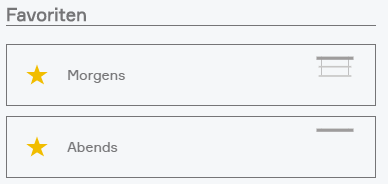
Introduction
With evon Smart Home, you have brought the most up-to-date home automation system into your home. We want to help you with the planning so that your project is easily implemented. Before you dedicate yourself to the detailed information in the documentation, we would like to give you a rough overview of the functionality in an evon Smart Home system.
Depending on what you intend to control, you will need different evon Smart Home modules (light module, blinds module …); according to the application or function, there is a range of different modules you can choose from. The autonomous evon Smart Home modules provide you with centralized functions such as “All Lights Off”. The complete range of control functionality is only available with the CPU module, which enables the configuration and control to be done via smartphone, tablet or PC.
The modules are mounted in one or more cabinets and need to be connected and wired differently to conventional electrical installations. The electrical consumers are connected to the module outputs and one or more switches are connected to the inputs. In contrast to a conventional electrical installation, the switches are not used to directly switch 230V to a consumer, but to control an evon Smart Home module. Since the laying of empty conduit and the laying of cables occurs at a different time to the installation of the consumer unit and the commissioning of the controls, it is extremely important that the cabling for electrical consumers and switches is planned in detail. Hence the first part of our documentation details with the necessary steps to do this.
Before Installing
Here you will find all necessary information about the installation of your evon Smart Home.
Planning
You need to consider a few things when implementing your smart home project. If you want, you can determine the following points yourself and go to an evon Smart Home partner of your choice with the results, or the evon Smart Home partner can accompany you and advise you through these steps.
In the beginning, there was a plan – what do I want my house to be capable of? Take your house plans and think of the following for each floor and room:
- Where will the consumer unit be located?
- Number of electric blinds and what type (standard or 24V with reverse switching?).
- Number of separate switchable light circuits and what type (standard via load relay, integrated load relay or dimmer function).
- Number of room temperature regions for temperature control (number of heating circuits per room temperature region is not relevant here).
- Number of special functions via input and outputs (e.g. doorbell, alarm light, window contacts, presence sensor, camera, audio, …).
Shoppingcart
First things first: think about what you actually want to control. Don’t worry at this stage about how and when, because all functions can be combined later via the evon Smart Home app. Just get them connected to the controller (lights, blinds, garden irrigation, doorbell, …).
The evon Smart Home configuration Excel file enables you to determine your exact module requirements and helps you keep an eye on the costs.
You will need a 24V power supply for the modules and a CPU evon Smart Home Controller (HC-iX800) module for the app control.
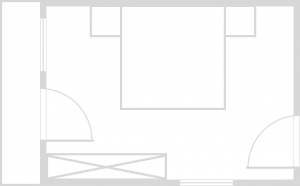
Example:
Let’s take a bedroom on the first floor as an example. We will use this example throughout the entire documentation and show the full capability so that we can use it everywhere.
Electrical Cabinet Placement
Depending on space requirements and availability, you can install everything in a central consumer unit or split it up over sub-consumer units. Normally, it is advantageous to combine the cellar, ground floor and outdoors area in a single consumer unit and put the electronics for the first floor in a smaller sub-consumer unit on the first floor. Using sub-consumer units reduces the length of cables and thus substantially reduces the cabling effort and simplifies the feeding in of cables.
You will need a bus extension module for every sub-consumer unit to connect the evon Smart Home modules to one another. You also need a bus extension module (Sys 1200) each time you start a new row within a consumer unit.
A separate 24 V supply is not always required for a sub-consumer unit. If the power is sufficient, you can route the supply from a previous unit.
Ensure that the GND connection of all power supplies is connected with the protected earth connection (PE).

Example:
Since the bedroom is on the first floor, we will use a sub-consumer unit. The power supply and the evon Smart Home controller are placed into the main consumer unit and the bus extension and the module for the bedroom in the sub-consumer unit. Both consumer units are connected to each other with the bus cable (CAT5) and the 24V power supply cable.
Blinds
The number and type of blinds to be controlled determines which module is to be used. It doesn’t matter whether the shading element is a roller shade, internal blinds, external blinds, or an awning – the important thing is how it is driven. Use the evon Smart Home module Blinds module B1144 if the motor has a separate line for UP and DOWN and is supplied with 230V. If the motor has a reversing switch then use the evon Smart Home module Blinds module B1244. Each of these modules can control two shading elements.

Example:
The bedroom has a window and a balcony door whose shading elements are to be controlled. Both shading elements are equipped with a normal motor (UP/DOWN, 230V). We will therefore plan an evon Smart Home module B1144, whereby the first output will be used for the balcony door and the second output for the window.
Light Circuit
It is important that you consider the number, function and type of lighting you wish to use for illumination. It is a good idea to draw your lighting circuits on a floor plan and note whether the circuits should be switchable or dimmable. Once you have considered the lighting circuits, the next thing to think about is the type and number of lights per lighting circuit: they will determine the optimum module selection:
The dimmable light will need the evon Smart Home dimmer module L1424. Each module can control 2 lighting circuits. In addition to the dimmer modules, you will need a dimmer pack for each dimmable light suitable for your type of bulb, for example the Eltako SUD12 1-10 V universal dimmer switch. The evon Smart Home dimmer module L1424 controls the dimmer pack via 0-10V or 1-10V; you can switch your dimmer pack or an intermediate relay on or off via the digital output of the dimmer module. Two dimmer circuits can be connected to each module.
The other lights will either require the evon Smart Home lighting module L1244 with integrated 230V/16A relay or the evon Smart Home lighting module L1144 to connect external relays for larger loads. You can choose either, or ask your electrician to decide for you. Four lighting circuits can be connected to each module.
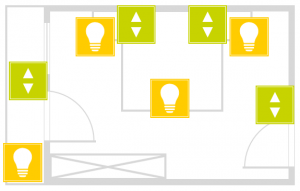
Example:
Two normal and two dimmable lighting circuits are to be installed in the bedroom.
Both of the normal lighting circuits are used for the ceiling and balcony lighting; an evon Smart Home module L1244 (with 16A relays) is sufficient here. Only two of the four outputs of the lighting module are used, the other outputs can and should be used for other rooms.
The two dimmable lighting circuits are reserved for two reading lights positioned left and right of the bed; they will use an evon Smart Home dimmer module L1424. In addition, we will use a dimmer pack each, which will be connected later to the modules.
Temperature Control
To control temperature, you will need the evon Smart Home single room modules C1144 or C1244. Module C1144 is controlled by the evon Smart Home room operating panel and module C1244 via PT1000 sensors, or from an external demand value (for example from an analog input).
Four control valves and 4 room operating panels can be connected to the evon Smart Home single room control module C1144 and C1244, whereby this corresponds to 4 separate room control zones. Each output can be connected to as many valve drives in parallel as you wish; it is only limited by the load on the relay output. This is useful if you have to install several heating circuits in a room because of the heating pipe lengths and the room is to remain a single zone with a constant temperature distribution.
You still need temperature sensors in the rooms with module C1144 so that the controller can modify the temperature as required. Temperature sensors are already integrated into our room operating panels C1101, C1102, C1103 and C1104. When fully equipped, in addition to room temperature measurement, the models C1101 to C1104 also have other functions such as demand temperature selection, mode selector (comfort, energy-saving, frost protection) and presence button (raise/lower temperature when activated).
In contrast to module C1144, the temperature demand value and mode cannot be changed with module C1244, this is only possible via the App, since only a PT1000 temperature sensor can be connected to the input of module C1244.

Example:
Naturally, we also want to control the climate in the bedroom. There is a heating circuit in the bedroom. We select the room-operating panel C1103 (temperature sensor, demand value, mode setting and presence button), the choice is yours.
We need an evon Smart Home single room module C1144 for the heating circuit, whereby the valve requires an output leaving three outputs free.
Special Functions
Special functions such as doorbell, door opener, window contacts, garden irrigation, scene buttons etc. require our digital modules. To determine how many modules you need, consider first the number and type of special functions you require. The evon Smart Home digital module D1180 has 8 digital inputs at 24V DC and is normally used in conjunction with the evon Smart Home digital module D1208, which has 8 digital outputs. The evon Smart Home digital module D1344 combines 4 inputs and 4 outputs in one module.
The inputs are designed for 24 V DS for all modules. Make sure you never connect higher voltages or alternating current sources to the module; otherwise it will be irreparably damaged.
The outputs can be used, depending on the wiring, to switch either 24 VDC or 230 V AC, however note when using 230 V consumers, the load is ohmic and may not exceed 5 A! Ohmic loads are, for example, normal light bulbs, whereby LED lamps represent capacitive loads and must be switched using an external relay. If in doubt, please ask your electrician or evon Smart Home partner!

Example:
Using our bedroom example, we plan to add an alarm system and we need a digital input and a switch to activate and deactivate the alarm, and a closing contact for the window and balcony door.
We plan an evon Smart Home digital module D1180 with 8 digital inputs, whereby 4 inputs are for the bedroom (the 4 reserve inputs can be used for a further room). Two inputs are for the closing contacts and two others for the switch.
In our example, we demonstrate the planning of special functions via digital modules.
Switches
Basically, you have a free choice concerning the switch type, but for evon Smart Home, we only use pushbuttons. We recommend that you use pushbuttons with at least 2 to 4 pushbutton functions per unit (corresponding to a flush-mounted socket). Since evon Smart Home only switches 24V signals via the pushbuttons/ sensors, there are no particular requirements concerning current carrying ability.

Example:
In our example, we plan using the following switches:
- 1x 2-way pushbutton at the entrance for the ceiling light, a double-click switches the dimmable reading lights and the ceiling light off.
- 1x 4-way and 1x 2-way pushbutton next to the balcony door. Two pushbuttons each for the two window shades UP / DOWN, one for the external light and one for the ceiling light.
- 2x 2-way pushbuttons, one of each side of the bed. 1 pushbutton for the dimmable light and 1 for the ceiling light.
- 1x 2-way pushbutton behind the bed for special functions, this could normally be handled with a double-click or a long push and are only in our example to demonstrate the evon Smart Home digital module D1180.
Control Cabinet
Once you have decided the number of evon Smart Home modules, relays and pushbuttons and have also fixed how you wish to distribute them in the cabinet(s), you can dimension the consumer unit. Basically, you can install evon Smart Home in any standard consumer unit due to the standard rail mounting with 45mm plate.
All lights, blinds and other loads, all switches, window contacts and sensors are wired into the appropriate consumer unit. For the switches, we recommend the use of multi-core communication cable (F-YAY) or CAT5 cable. Clearly arrange them, optimally on LSA plus strip (see template connection strip).
Do not forget to leave space for the power supply, bus extension and bus terminator. Once everything has been installed, 20-30% of the space in the consumer unit should be free for future extensions.
Example:
In our bedroom example, we have planned a sub-consumer unit for the modules on the first floor.
The total space requirements for the sub-consumer unit on the first floor results from: 176mm in the first row and 132mm in the second row – including bus extension for row extension and bus terminator.
First row:
- 0x power supply: power is supplied from the main consumer unit
- 1x evon Smart Home bus extension: 22mm
- 1x evon Smart Home blind module B1144: 44mm
- 1x evon Smart Home lighting module B1233: 44mm
- 1x evon Smart Home dimmer module L1424: 44mm
- 1x evon Smart Home bus extension: 22mm (to new row)
Second row:
- 1x evon Smart Home bus extension (new row)
- 1x evon Smart Home single room control module C1144: 44mm
- 1x evon Smart Home digital module D1180: 44mm
- 1x evon Smart Home bus terminator: 22mm
We need additional space for several circuit breakers and for a suitable LSA Plus strip to connect the pushbuttons (4x 24V supply, 13x pushbutton inputs).
Cabling
All cables must be routed to the consumer unit in which you have planned the corresponding module.
Each button will require a 24V voltage supply (+24V), and per pushbutton a cable that is connected to the pushbutton and the corresponding module. When cabling the sensors (pushbutton, contact, room operating panel) we recommend the use of communication cable (F-YAY) or CAT5 cables. If you wish to have more than one pushbuttons connected to a module input, you can either daisy-chain the cable in the room (from switch to switch, contact in the junction box) or cable all switches to the consumer unit and connect them all together there. The second variant gives you the advantage to only have the connection effort once, in the consumer unit, but increases the effort required for initial installation and cabling, and more space requirements in the consumer box.
Use deeper junction boxes as switch back boxes or boxes with more space – you will be grateful to yourself later when it comes to connecting the cables.
As opposed to a conventional electrical installation, the switches do not come into contact with the 230 V mains, however 230 V mains supply must still be routed into the consumer boxes to be connected to the evon Smart Home modules to provide power for the consumers (lighting circuits, blinds…).
Make sure that you do not forget cables for the room control unit, doorbell, window contacts, door opener etc. It is better to route one cable more than necessary than have one too few.
Wiring
The consumer unit houses the mains connectors, LSA Plus strips, evon Smart Home modules, their supply, further relays and, if necessary, the circuit breakers for the 230V circuits.
The 24 V power supply and the pushbutton and sensor inputs – i.e. the CAT5 or communication cable – are connected to an LSA Plus strip and wired from there to the evon Smart Home modules.
The 230 V cables are wired via terminal strips or directly to the evon Smart Home modules or load relay.
More information on how each module is connected individually can be found in the module description or a wiring diagram is printed on the side of each module. The individual wires can be easily allocated using the connection list and the cable labels.
If you are unsure, please contact your evon Smart Home partner or an electrician.
Electrical connection work may only be carried out with the power disconnected and only then by suitably qualified expert staff.
CPU I/O
You can connect up to four digital inputs and two digital outputs to the evon Smart Home controller (iX800).
Some of these In- and Outputs are already assigned with predefined functions (rain, storm, ...) - the assignment can always be changed by the user.
DI1
Digital Input 1 – Predefined as Home Off - Switch
DI2
Digital Input 2 – Predefined for rain detection
DI3
Digital Input 3 – Predefined for twilight detection
DI4
Digital Input 4 - Predefined for storm detection
DO1
Digital Output for arbitrary use
DO2
Digital Output for arbitrary use
These In- and Outputs can be found in the Hardware-App by clicking on the left Area of SC1-Line1 (smartCOM Line1).
General
Your new evon Smart Home can be controlled either conventionally via the pushbuttons mounted on the wall, or also via your PC, tablet or your smartphone. This way, you have your evon Smart Home with you all the time. You have full access to all functions that make your life easier, from your sofa or when you are traveling.
Connecting
In order to be able to control your home via the app, your must first connect to your system. Simply follow these simple steps.
WiFi Connection
Before your activate your evon Smart Home app, make sure you are connected to the same network as your evon Smart Home controller. Simply go to the WLAN settings on your device and check the currently selected WLAN, or connect to the correct one.
In case you switch on your evon Smart Home CPU for the first time and it does not receive a valid IP address after several attempts (DHCP), it will automatically switch to the following static address:
IP-address: 192.168.50.50
Subnetmask: 255.255.0.0
If you are using the WiFi dongle to connect to evon Smart Home the controller will always use 192.168.192.1 as its IP address.
Home Screen

Once you have successfully installed the app via the AppStore, the app is located on the home screen. You can start the app directly from here. After a short time to load the app, you will see the start page of the app.
From here, search for the available evon Smart Home systems. The selection is either a connection via a local Wi-Fi/WLAN or the internet (e.g. mobile network provider via a secure HTTPS connection).
If you are configuring evon Smart Home for the first time, select “Wi-Fi” in order to search for your system via the local WLAN.
Start Search

The evon Smart Home app will now search for all system in your network. As soon as one or more have been found, they will be displayed along with their allocated IP address. Your new system will be listed with the default name evon Smart Home + unique identification number (e.g. evon Smart Home_1234AB9). You can change the name later, if your wish.
Once you have selected your evon Smart Home system, the next thing you must do is login.
Login
After selecting the evon Smart Home system, you will find yourself on the login page.
Enter your username and password. You can also determine whether you wish in future to login automatically with your login data.
To make it easier for you to login to your evon Smart Home on your first configuration, there is also the option to do this by using a QR-code. Use the green button on the top right corner of the login screen to use this feature.
Point the camera at the QR-code, which you will find in your enclosed documents, and position it at the center of the marked area. once the QR-code ist successfully recognized, the associated login field will be filled in.
You have now successfully connected to your evon Smart Home system and can start to control your home.
To connect for the first time, use the username and password or QR-code provided for you in the enclosed documents.
Browser

Besides accessing your evon Smart Home system with the official app, you can also connect to it with any modern browser (e.g. Chrome, Safari, Edge). You only have to know the IP-Adress (Which is displayed in the app once your system is found).
When you enter the address in the url bar of your browser, you will be directed to the login page, where you will have to enter your credentials. You can then use your evon Smart Home system like you are used to.
If you connect to your evon Smart Home system with a browser (e.g. Chrome), some device specific functions from the mobile App may not be available to you. These include, among others, native notifications, which also appear when the app is currently not in use.
Cache Löschen
Nach einem evon Smart Home Update kann es vorkommen, dass der Browser die Aktualisierungen nicht sofort korrekt darstellt. Hier empfehlen wir nach dem Update das Löschen des Browser-Caches. Nachfolgend finden Sie dazu die Anleitung für die diversen Webbrowser.
Google Chrome
Drücken Sie die Tasten "Strg + Shift + Entf" oder geben Sie "chrome://settings/clearBrowserData" in die Adresszeile ein.
Wählen Sie bei "Zeitraum" den Eintrag "Gesamter Zeitraum"
Aktivieren Sie "Bilder und Dateien im Cache" und klicken Sie dann auf "Browserdaten löschen"
Microsoft Edge
Drücken Sie die Tasten "Strg + Shift + Entf"
Wählen Sie "Zwischengespeicherte Daten und Dateien" und klicken Sie dann auf "Löschen"
Alternativ:
Klicken Sie auf das "..."-Symbol oben rechts
Wählen Sie "Einstellungen"
Suchen Sie den Abschnitt "Browserdaten löschen". Klicken Sie dort auf "Zu löschendes Element auswählen"
Wählen Sie "Zwischengespeicherte Daten und Dateien"
Klicken Sie abschließend auf "Löschen"
Mozilla Firefox
Drücken Sie die Tasten "Strg + Shift + Entf"
Es öffnet sich ein neues Fenster. Aktivieren Sie die Option "Cache" und klicken Sie dann auf "Jetzt löschen"
Microsoft Internet Explorer
Drücken Sie die Tasten "Strg + Shift + Entf"
Wählen Sie "Temporäre Internetdateien" und klicken Sie dann auf "Löschen"
Alternativ:
Klicken Sie auf das Zahnrad-Symbol oben rechts
Wählen Sie "Internetoptionen"
Wählen Sie das Register "Allgemein"
Suchen Sie den Abschnitt "Browserverlauf". Klicken Sie dort auf "Löschen…"
Es öffnet sich ein neues Fenster. Deaktivieren Sie "Bevorzugte Websitedaten beibehalten" und aktivieren Sie "Temporäre Internetdateien" und "Cookies"
Klicken Sie abschließend auf "Löschen"
External Access
If you are currently not at home, but would still like to have access to your home control, then you can use the external access provided by your evon Smart Home system. If you have activated this option, you can access your system from anywhere in the world assuming there is an Internet connection, just as if you were at home.
The configuration for external access is located under “all apps” – “settings”.
Configuration

Activate the function for external access in the settings by placing a tick next to it.
As soon as you have activated the function, the displayed status changes from “not connected” to “connected” and the evon Smart Home ID appears. This ID is required to connect you to your evon Smart Home system. It is a good idea to write this ID down, you will need it in the next step.
This evon Smart Home ID gives you the ability to access your system from a normal web browser (via
my.evon-home.com).
Logout
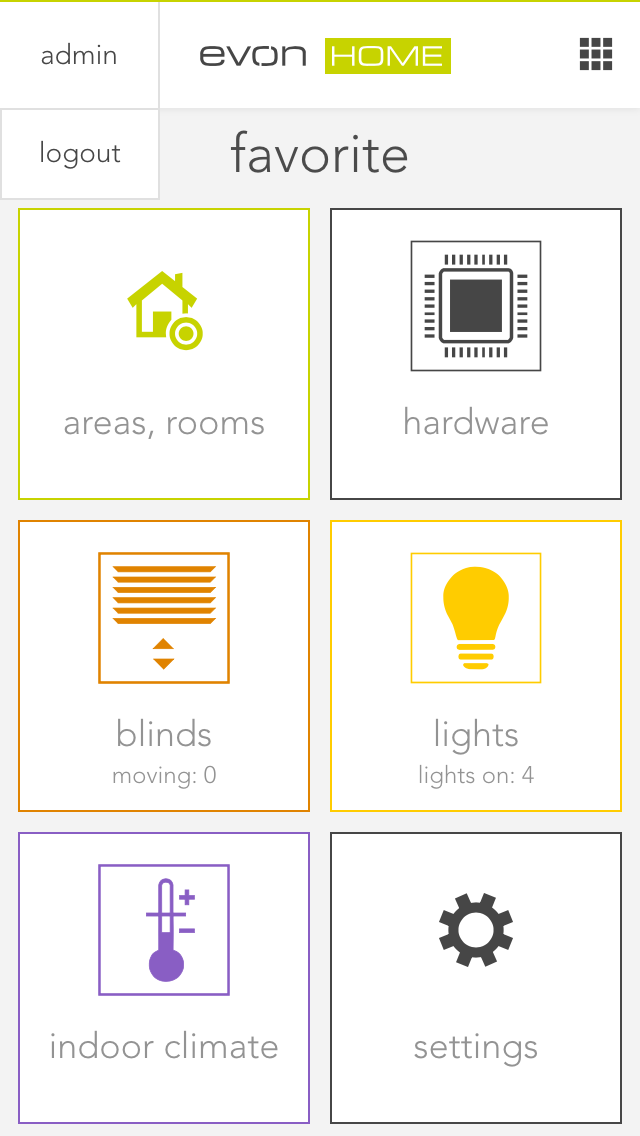
Return to the main screen. On the top left is your current username. If you click on it, the logout button will appear. Logout via this button.
You will now be on the start screen of the evon Smart Home app, which shows a list of all your previously connected systems.
Connect

Click on “new” to create a new connection. You will now see an overview of all possible connection types, as described previously.
Select “internet” as the connection type. You must enter the evon Smart Home ID in the next screen, along with your username and password. When done, connect via the button at the bottom of the screen.
As soon as you have successfully connected to your evon Smart Home system via the external connection, this connection will appear on the start page of your evon Smart Home app. You can now easily select this connection at any time.
The first external connection to your evon Smart Home system can take some time. Even once the connection has been established, please wait until all data has been uploaded before your quit the app.
Browser
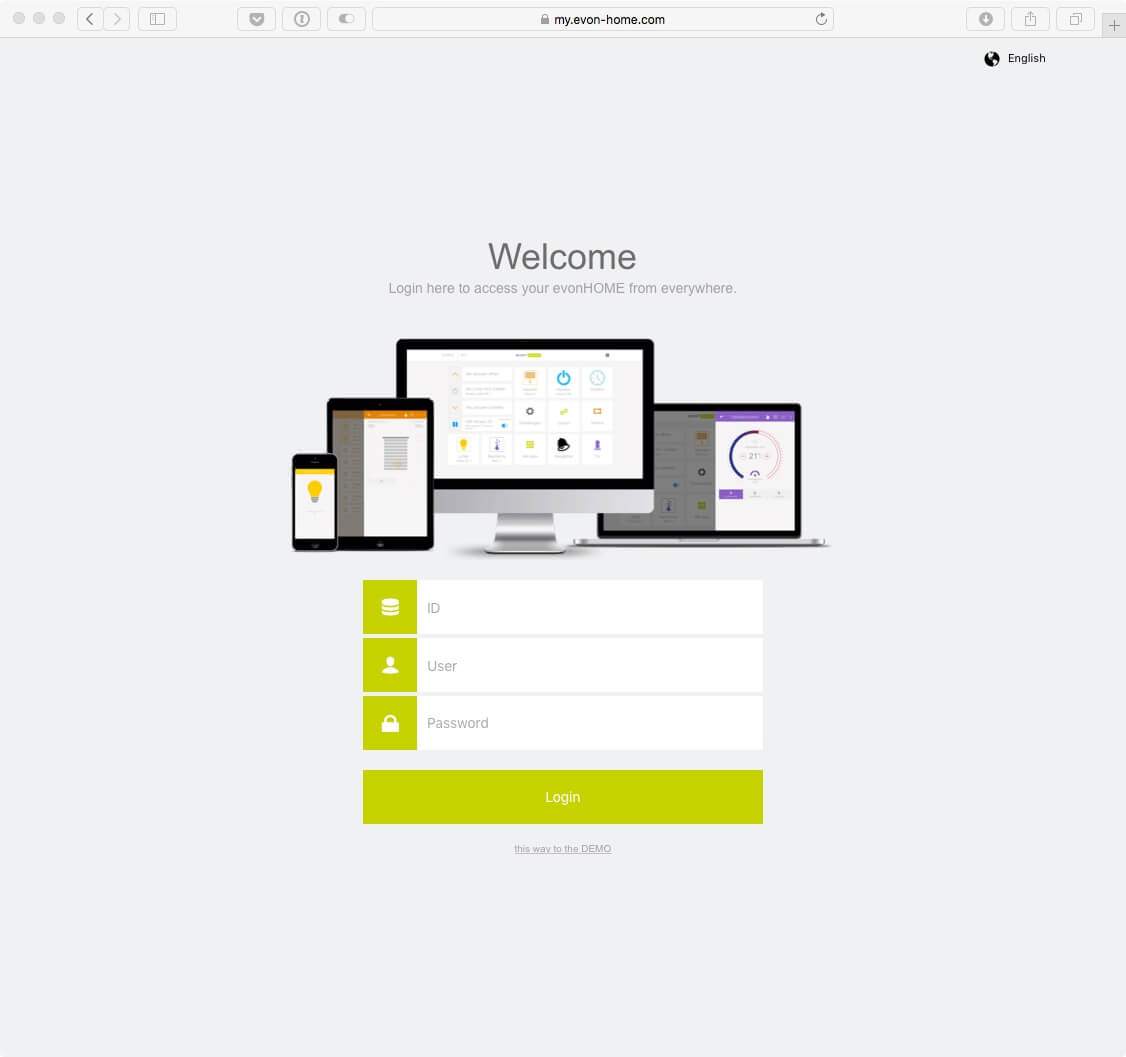
Once you activate the external access, you can connect to your evon Smart Home system from every supported browser (Safari, Chrome, Edge).
Go to the website my.evon-home.com and login with your credentials. In addition to your user name and password, your will also require the evon Smart Home ID, which you received by activating the external access.
If you connect to your evon Smart Home system with a browser (e.g. Chrome), some device specific functions from the mobile App may not be available to you. These include, among others, native notifications, which also appear when the app is currently not in use.
Interface
Visualization of your evon Smart Home system enables you to control all functions in your home and adjust all necessary settings. There are a few simple concepts that we would like to describe here.
Current User

Once you have logged in, your username is displayed at the top left of the screen. Clicking on your username opens a menu where you can logout.
All Apps

A single click on the symbol (top right) opens all apps. This shows you all available apps. If you don’t want “all apps” open all the time, you can put frequently used apps into your favourites, as follows.
Favorites

Favourites lets you store apps that you use on a frequent basis.
If you want to add something to your favourites, mark the app (press the app with your finger/your cursor until a blue bar appears below) and select “add to start”.
If you want to remove something from your favourites, mark the app and select “remove from start”.
Marked apps can also be moved and sorted.
Areas
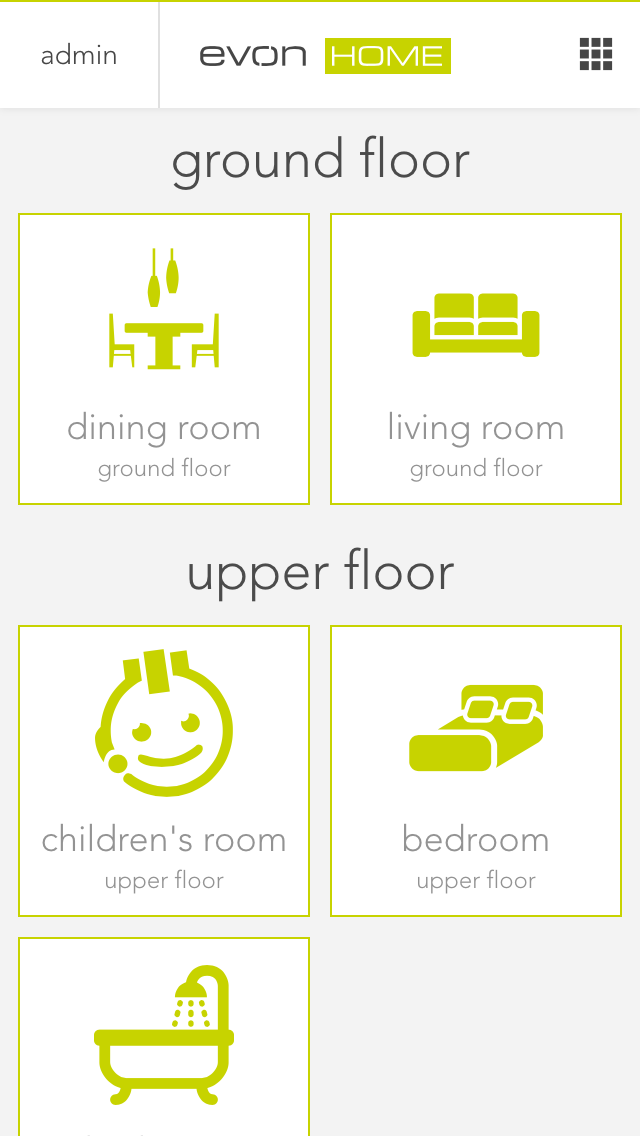
After the favourites are your areas. First up are your floors (ground floor and first floor in the diagram) and below that your areas and rooms. However, only those areas that contain something are displayed. For example, if a light is added to the room “bedroom”, the bedroom will be displayed.
Usage
Every app contains different views and representations that are used for opening, operating or changing settings.
App
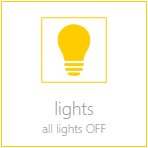
This is the basic representation of every app in the system. A single click/press on this display opens the app view and its functions can be used and/or changed.
App Interface
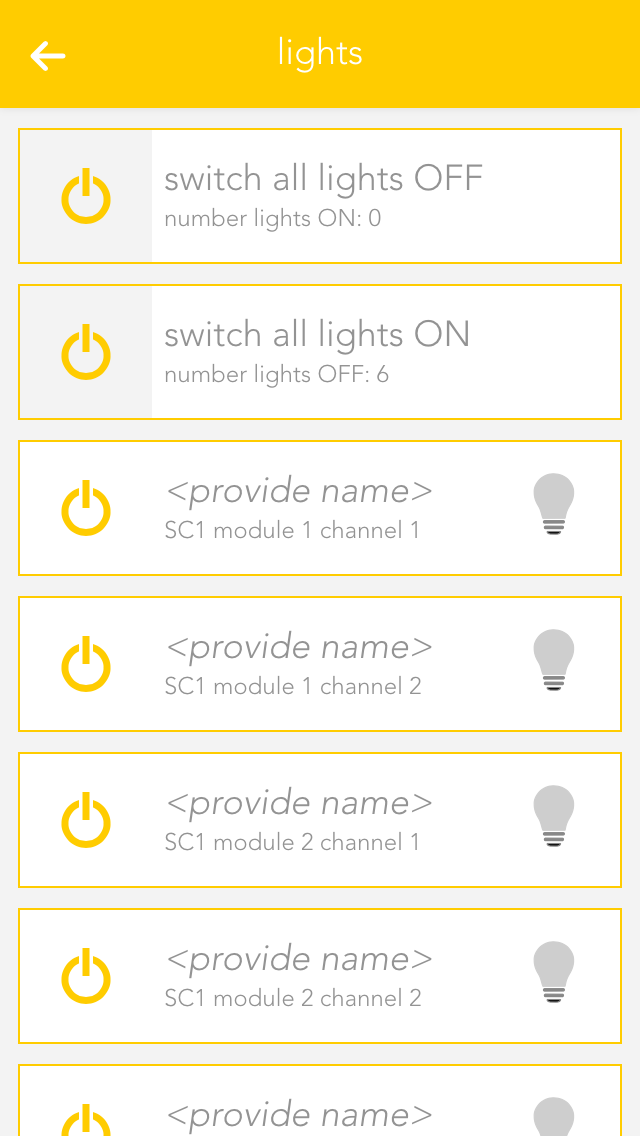
As long as you have an app open, you can also open its view. This shows you all content and functions that are available to you. In the case of the light app, the items displayed include all connected lights and the group functions.
Group Functions

The group function can vary from app to app, but is mainly used to create new elements or to operate several available elements. Taking the app “lights” as an example, it can be used to switch all available lights on or off. In other cases, such as “user”, you can add new users.
Elements

This display represents a single element in the app. In the case of “lights” every single one of your connected lights is displayed like this. The display is divided into several individual sections, each one serving a different purpose. The area on the left contains operating elements in the form of one or more buttons that you can use to control the element (e.g. light on/off). Then there is a text area containing information such as the name and the allocated area. On the right, many apps have a status display showing you the current status of the element. Fo lights, you can see whether the light is on or off, or (if the energy saving mode is active) when the light will be switched off.
Clicking /pressing the text area of an element opens the settings screen where you can change the app name, allocated areas and functions as you wish.
Settings
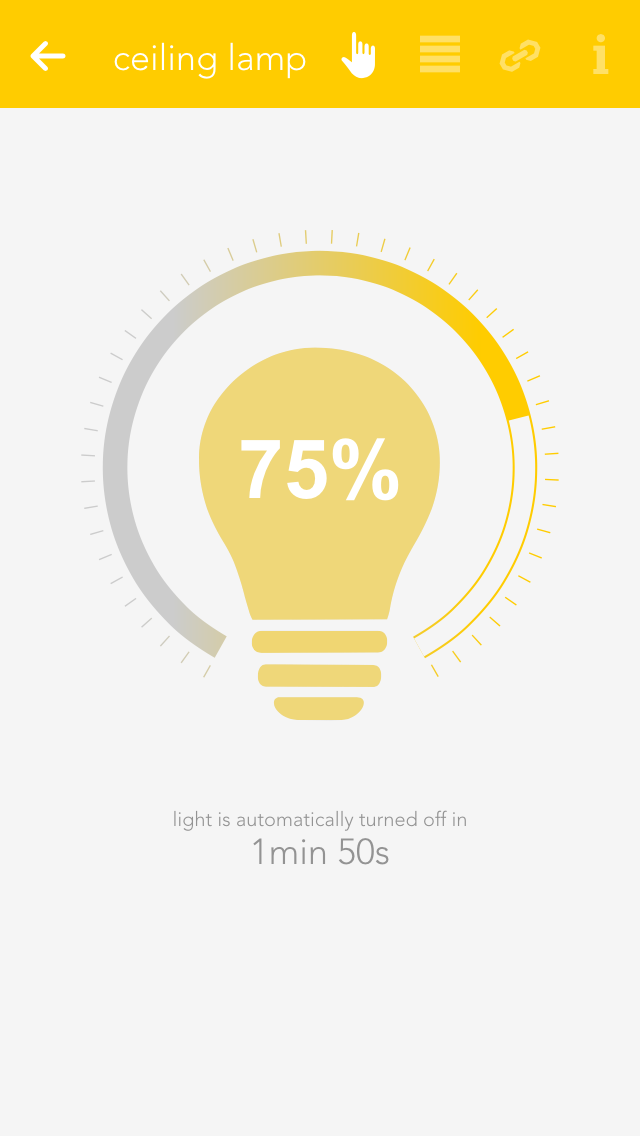
This display offers you various information and settings possibilities for the selected element and is divided into several sections. On the top right are small buttons that let you jump into other areas. The first section contains the most important operating elements via which you can operate the selected element and, depending on the app, various items of basic information.
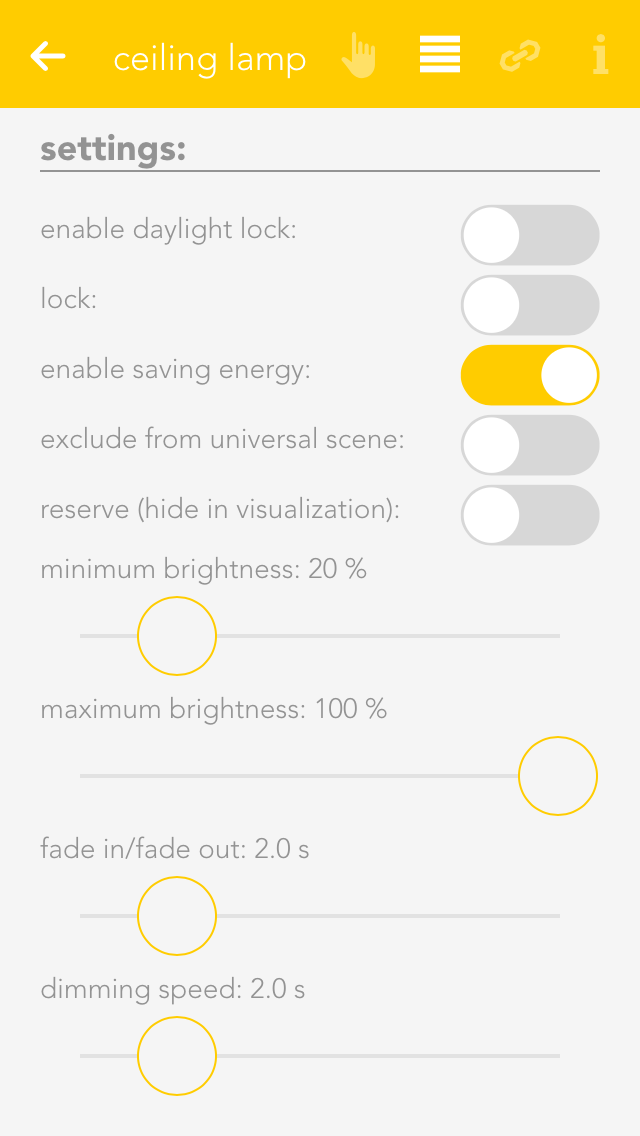
The second section contains the settings that you can change for that element. These allow you to change the behaviour of individual element to suit your needs.

This section shows you al the links for your element. This gives you an overview, should you desire it, of which switches or functions affect the element. You can also link the element with other elements, depending on the app. For example, in the app “lights”, you have the possibility to link a light with a motion sensor.
In the settings view, most of the apps have a button on the top right allowing you to access the official documentation.
Please note that the settings possibilities vary from app to app and therefore not all sections are available for all apps.
Notifications
Your evon Smart Home uses a range of notifications to inform you of events in the system. For example, if you have integrated a door intercom, the system can notify you when someone rings the doorbell.

Depending on how you access your system, there are different forms of notification. If you access your evon Smart Home via an app or via a web browser, you will receive new notifications directly in the visualization. All collected and unread notifications can be found via the button “letter symbol” on the main page.
The evon Smart Home app, used on tablets and mobile phones, also offers you native system notifications. You will receive these even if you are not currently using the evon Smart Home app.
If you have started the evon Smart Home app for the first time, you will be asked if you would like to permit notifications to be sent to you. If you agree then the app will be able to send you notifications. You can change the settings for notifications for each individual device that accesses your system later in the app “devices”.
Configuration
Once you have connected the evon Smart Home app with your evon Smart Home, there are just a few steps to be taken in order to adapt your evon Smart Home to your requirements.
Areas
Use the app “areas” to organize your evon Smart Home into rooms and elements within the rooms (e.g. lights, blinds …). This way, you will be able to find them quickly.

Your previously defined rooms will be displayed on the home screen (as long as they contain elements). To modify the rooms, open the “settings” app and select “areas, rooms”.
Create

In order to add rooms, areas and floors to your evon Smart Home, simply tap on the corresponding element (e.g. “add room”). This automatically opens the operator panel for the added element. Enter the name into the field “name” and an abbreviation in the field “abbreviation” for the room. If you want to allocate this new room to a floor, simply select the floor you want. If you want to move the area back to the highest level, select the empty entry in “area, floors”.
Alternatively you can first navigate to a floor and add a room there.
Settings

If you wish to personalize your rooms, you can select colour, icon and background picture for your room. Do this by opening the operator panel for the room via in “settings” – “areas, rooms” and select the element under “settings” and modify it.
Open the area via the button “edit” and view the elements for this area. If you want a shortcut to an area, simply click on the area of the symbol in the object panel (left).
You can also link each room with a room thermostat. Do this by allocating an element to this room in the app room climate. If you have allocated more than one room thermostat to a room, you can use the parameter panel of the room to select the room thermostat you wish to use for the room temperature display.
Erweiterte Einstellungen
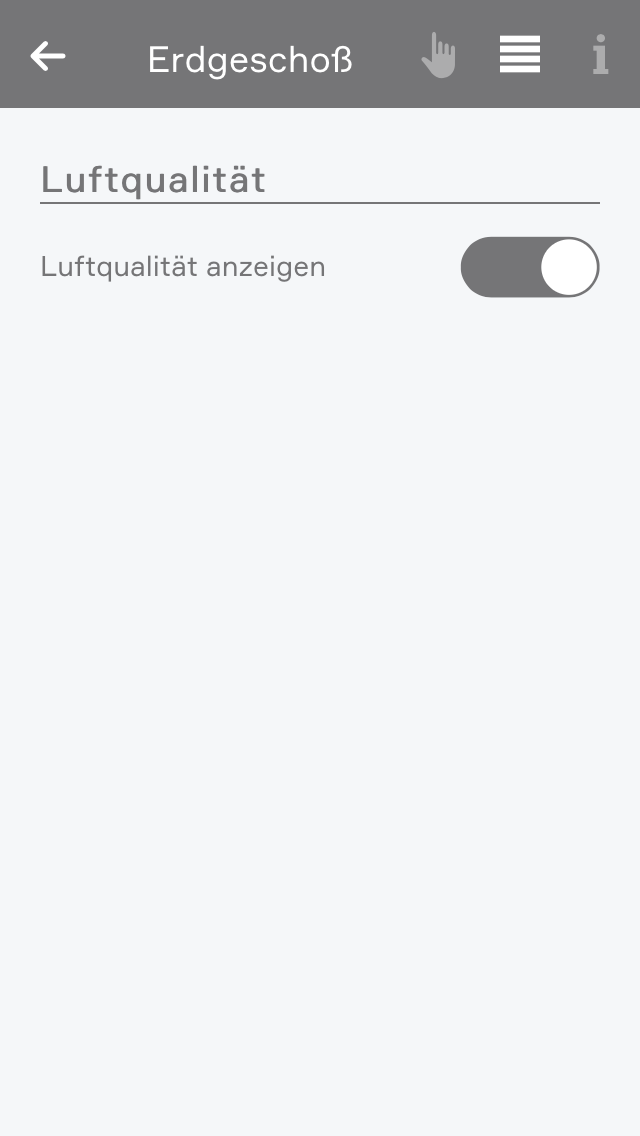
In den erweiterten Einstellungen können Sie angeben welche Elemente zur Berechnung und Anzeige des Raumklimas verwendet werden sollen. Außerdem können Sie hier das Raumklima des Raumes ausblenden.

Wenn Temperatur-, CO2-, Feuchtigkeits- oder Geräuschsensoren dem Raum zugewiesen wurden, wird im Raum das Raumklima angezeigt.
Je nach Zustand des Raumes wird hier ein Gesundheitswert berechnet welcher von "Hervorragend" bis "Sehr schlecht" reicht. Wenn sich der Zustand des Raumes verschlechtert bekommen Sie eine Benachrichtigung über den verschlechterten Zustand.

In den Einstellungen des Raumklimas können Sie die Benachrichtigungen deaktivieren.
Außerdem können Sie hier die optimalen Grenzwerte des Raumes anpassen.
Naming
After you have connected via the evon Smart Home app to your evon Smart Home system, you should name all of the connected devices (lights, blinds, heating circuits, etc.) and allocate them to a room. This helps you to not only find and operate them easier, but also to access further functions.
Select

Open “lights”, “blinds” or “room climate”, depending on the items you wish to modify the names and rooms.
The app shows you a list of central functions and below that a list of your elements – this corresponds to the channels of your evon Smart Home modules. More detail concerning the central functions can be found in the corresponding documentation.
Tap on the area that displays the name and the room, in this case “ no name”, “no room” to open the settings for this device.
Provide Name and Room
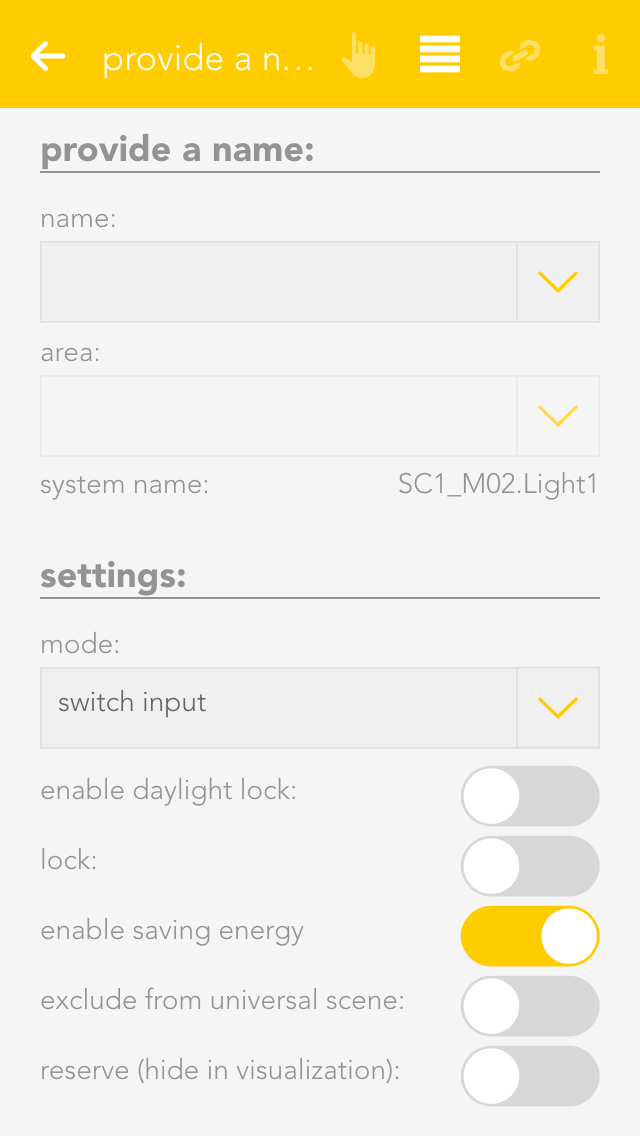
Enter the name of the device in the field “name”. You can type any name in here, or use a predefined name by tapping on the small arrow.
Tap on the field to select a room. The system already has a predefined few names that you can use. If you cannot find a suitable room in the list, create one in the settings -> areas and custom rooms.
You do not need to specifically save your changes, simply tap on the arrow symbol in the menu bar.
Choose a distinctive name depending on the device and purpose like: ceiling light, ambient, radiator or wall heating.
User & Groups
You can allocate different rights in your evon Smart Home to users, for example so that children can only use functions in the children’s room. The rights are controlled via the user groups.
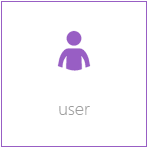
You can find users and user groups in “all apps” – “settings”.
User
A user allows you to control exactly the rights for your evon Smart Home.

You can add a new user here or configure an existing one. To add a new user, simply select “add user”. This opens a panel where you can enter the user name and an optional description. Enter a password for the user so that you can login using the username.
Settings

Profile picture
The profile picture to be displayed for this user.
Background picture and text colour
You change the background of your visualization as you wish. The text colour selects the colour of titles such as “favourites” on the home screen so that they are readable, even with other background pictures.
Show areas on the home screen
This setting lets you define whether areas will be displayed on this user’s home screen.
Own favourites
If you activate the option “own favourites”, you can customize the favourites on your own home screen without these changes being visible to other users. If this option is deactivated, then your favourites are shared with other users and any changes will be visible to all users.
Language
This lets you change the language for this user. To change the language of the current user, click on “load new language settings”.
Permissions

Permit external access
The option “allow external access” lets you decide whether this user is permitted to connect to your evon Smart Home externally.
Rights
This allows you to allocate rights to this user. If you want to allocate rights independently from a group, simply select “user defined”. The individual rights are explained further down the screen. If the user is to have no rights, simply select “no rights”.
Areas
The section “areas” lets you select which the areas this user is to have access to. If you have allocated this user to a user group, the rights in this group have already been defined for this area and hence you only have the possibility to limit the rights for individual areas further.
Some changes cannot be made to the user you have used for your login. So for example you cannot withdraw administrator rights or delete the current user.
Groups
User groups allow you to configure rights for several users.

The settings can be modified for a user group that already exists, or a new one can be created. To create a new user group, click on the element “add group”. This opens a panel where you can enter the name of the group (e.g. “guests”), and assign colour and an icon.
Permissions
Rights are used to limit what a user in this group is allowed to do in your evon Smart Home.

Admin
This level of rights gives the user full access to all possibilities in the system. All the following rights are deactivated, since they are all included in the admin rights.
Change parameter
Users in this group are allowed to change parameters, i.e. all settings accessible via the parameter symbol.
Manage settings
The user can open the settings (all apps – settings) and make changes. Exceptions are the user settings.
Manage home screen
The user can change the start page of the app, in other words, they can set favourites and move elements. See also “own home screen”.
Add object
The user can add new objects to the system, for example a new surveillance camera, a new Denon system, etc.
Edit logic
The user can create and edit logic elements.
Edit scenes
The user can create and edit scenes; otherwise scenes can only be executed.
Edit area
The user can create and edit areas.
Execute universal scene
The user can execute universal scenes such as close all blinds, switch on all lights, etc.
See all apps
The user can open all apps, otherwise they only have the possibility to open apps that are on the home screen.
See notifications
Notifications are displayed for the user (such as wind, alarm system, etc.).
Areas

In “areas”, you can define which areas the users in the group will be able to access.
Light
A light in evon Smart Home corresponds to a lighting channel that is connected to an evon Smart Home light module. Once connected, each light can be switched on and off. In addition, you also have the pre-defined universal functions “all lights on” and “all lights off”.

You can find the lights under “all apps”.
Usage

You can switch a light on or off via the “power symbol” on the left side. The right-hand side of the panel shows you whether the light is currently switched on or off. Clicking on the element takes you into the extended operation or configuration of this light. You can switch the light on or off by clicking on the bulb symbol.

If you have a dimmable light, you can switch in on or off via the object panel. Of course, you can also control this dimmable light via the operator panel by setting the circular slider around the light to the desired value.

RGBW
If you own a RGBW Module (HC-L1644), you can control the desired light color and brightness from within the OperatorPanel.

Additionally, you can also save the current light settings as a favorite and activate it again later.

Saved favorites will also be displayed in the ObjectPanel, if you resize it to the appropriate size.
Configuration
Once a light has been given a name, you can configure it to suit your needs.
General

Mode
This setting determines whether this light is controlled by a switch or a presence detector. If you select “presence detector”, the settings to adjust the time the light is switched on are displayed.
Activate daylight lock
This option lets you prevent the light from switching on during the day (if there is sufficient light). This can be used for a hallway where the light is controlled by a presence detector. You can adjust the source for daylight detection in the global settings.
Lock
If you activate “lock”, then the light cannot be switched on or off by the switch, nor by the presence detector.
Activate energy saving mode
This option lets you configure the light to switch itself off after a certain time. If you have activated this option, then the software shows you the settings for the time the light is to remain switched on. You can change this time to anything you want.
Remove from universal scene
An example of a universal scene is “all lights off”, where all lights are switched off. However, if you want a particular light to be excepted from this, then activate this option (useful for lighting an aquarium).
Reserve
If you have a module with spare connections, i.e. where no light is connected, the app still shows that the light is on or off, because the output is active (although no light is actually connected). The “reserve” field lets you hide lights that are not used/connected. You can reactivate this light via the corresponding module in the app “hardware”.
Dimmer

Minimum and maximum brightness
Minimum and maximum brightness: many lights only have a noticeable change in brightness within a certain range. Hence you can set a minimum and maximum brightness level so that dimming will happen in between those limits. The visualization will still display 0% to 100%.
Fade in time
This is the time that the light is to take to reach the desired brightness from being switched off.
Dim speed
This is how fast the brightness is reached when the button is pressed continuously.
RGBW

Minimum brightness
Legt die kleinste Helligkeitsstufe fest
Set the minimum brightness level
Maximum brightness
Set the maximum brightness level
Fading time
This will set the time it takes for the light to dimm between "on" and "off" state rather than switching instantly.

Dimm speed
Sets the time it takes for the light to dimm to the desired brightness.
Color changing speed
This setting will affect how fast the light switches through all available colors when using the linked switch with a longpress.
Only white
When this setting is active, the color wheel will be hidden and only the brightness slider is available in the OperatorPanel.
Enable saving energy
Enables the energy saving mode, in which the light will switch itself off after a given time. You can adjust the desired time with the given interface elements, which appear once this setting is active.
Exclude from universal scene
Activating this option will exclude it from Universal scenes which will not impact this light anymore until this option is turned off.
Switch off automatically after
This option only appears after the "enable saving energy" setting it active. It allows you to adjust the time it takes for the light to switch itself off.
While the standard mode of the RGBW Module is "1xRGBW" it is also possible to switch to "4xWhite". This will allow you to connect 4 separate lights to one RGBW module and use them like normal dimmable lights. To change this setting, go to "All apps" - "Hardware" and navigate to the correct module ("Light1644"). Click on the Name and change the setting in the appearing OperatorPanel.
Linking
Linking allows you to connect your light to other elements in your evon Smart Home.

Switch on with
If you want this light to be switched on as soon as another is switched on, then use the function “switch on with”. The button “select” lets you select the other light you wish to link to this one.
Bewegungsmelder/Taster hinzufügen
Further presence detectors or buttons can be defined in one light channel to control the light.
The function of the linked button or presence detector depends on the autonomous light function, i.e. whether the button or presence detector mode has been selected.
Gruppenfunktion
Über die Gruppenfunktion lassen sich mehrere Lichter zu einer Gruppe zusammenfassen. Dadurch werden alle gleichzeitig geschalten.

Um eine neue Lichtgruppe anzulegen, wählen Sie "Neue Lichtgruppe" innerhalb der Licht App.

Eine neue Lichtgruppe wird erstellt.

In den Einstellungen der Gruppe sollten Sie als erstes einen Namen vergeben und einen Raum zuordnen.
Hier haben Sie außerdem die Möglichkeit, die Gruppe zu deaktivieren. Dadurch können Sie eine bereits konfigurierte Gruppe temporär abschalten, ohne sie löschen zu müssen.
Für erweiterte Anwendungen ist das deaktivieren der Lichtgruppe auch über die Logik möglich.

Fügen Sie nun mehrere Lichter hinzu. Alle Lichter die sich in der Gruppe befinden werden nun gleichzeitig geschalten. Schalten Sie ein Licht der Gruppe aus, werden auch alle anderen ausgeschalten. Handelt es sich bei einem der Lichter um einen Dimmer, so wechselt dieser zwischen "Aus" bzw. der zuletzt eingestellten Dimmstufe.
Die Gruppenfunktion wirkt sich sowohl auf die Bedienung über die evon Smart Home Visualisierung, als auch Taster und Bewegungsmelder aus. Sie können außerdem zu jeder Gruppe weitere Taster hinzufügen.
Im Regelfall können Lichter und Taster nur zu einer Lichtgruppe hinzugefügt werden. Für Spezialanwendungen ist es jedoch möglich, bereits verknüpfte Lichter und Taster zu einer Lichtgruppe hinzuzufügen. Dies können Sie im Parameter Panel unter "Erweiterte Parameter" konfigurieren.
Achtung: Lichter und Taster mit mehreren Lichtgruppen zu verknüpfen ist nur dann sinnvoll, wenn immer nur eine Lichtgruppe aktiviert ist. Beispielanwendungen hierfür sind Räume, welche über Trennwände aufgeteilt werden. Hier kann es sinnvoll sein, dass Lichtgruppen je nach geschlossener oder geöffneter Trennwand deaktiviert werden.
Motion Detector
If a light channel is connected to the input of a presence detector, then this light will always be automatically switched off after the defined time independently of whether an additional button or presence detector is switched on.
A presence detector light can be immediately manually switched off using an additional button.
If the time for the presence detector is to be used, then the time for the light must be set to 0. If the time for the light is to used, then the time for the presence detector must be set to 0.
Additional buttons
The light can be switched off at any time with an additional button linked to this light channel (or on, if required). If the light is switched on via the button, it is also switched off after the defined period of time.
Note that in this case, the energy saving time cannot be 0, because otherwise the button input would be immediately switched off – and hence not seem to work.
Additional presence detector
An additional presence detector can also switch the light off after the defined period of time.
Note that in this case, if the energy saving time is defined with 0, then the on/off times for the light will vary due to the times defined by the presence detector.
Switch
If a light channel input is connected to a button, this light will be switched by every linked button or presence detector according to the autonomous function.
If no automatic switch-off time is defined (energy saving mode), then the presence detector can only switch the light on.
Additional button
The light can be switched on or off at any time using an additional button linked to this light channel.
Note that in this case, the energy saving time cannot be defined as 0, as otherwise the light would be switched off immediately after the button press – and therefore not seem to work.
Additional presence detector
An additional presence detector will always switch the light on and switch it off after the defined period of time.
Settings
You can configure settings that affect all lights in “all apps – settings – lights”.

Daylight-lock-delayed switching
To configure the daylight lock, navigate to settings and select lights. You can adjust how many minutes after dusk you want the daylight lock to be deactivated and how many minutes after dawn you wish the daylight lock to be activated. In other words, if your evon Smart Home registers dusk at 8pm and you have set 10 minutes, then the daylight lock will be deactivated at 8:10pm.
DALI
Das evon Smart Home DALI Modul ermöglicht Ihnen die komfortable Steuerung von DALI Lampen mit Ihrem evon Smart Home System.
Mit dem Modul L1842 können Sie zwei DALI Linien mit jeweils bis zu 16 Lichter steuern.
Nähere Information zur Verkabelung der DALI Linien finden Sie im mitgelieferten Datenblatt des Moduls.
Bitte beachten Sie, dass nur DALI Lampen und Vorschaltgeräte unterstützt werden, welche nach dem DALI Standard IEC 62386 genormt sind.
Bedienung

Sie finden Ihre DALI Module unter "Alle Apps" - "Hardware"

Im Parameter Panel können Sie entscheiden, ob Sie den Expertenmodus verwenden möchten.
Standardmodus: Alle Lichter auf einer DALI Linien können gemeinsam geschalten werden. Zusätzlich werden die Lichter der Linien mit den Taster der Kanäle 1 und 2 geschaltet.
Expertenmodus: Der Expertenmodus erlaubt die Steuerung jeder einzeln angeschlossenen Lampe. Hierfür müssen alle angeschlossenen Lampen adressiert werden. Die Taster der Kanäle 1 und 2 werden nicht für die Steuerung der Lampen verwendet.
Zusätzlich haben Sie im Parameter Panel die Möglichkeit, die Steuerungsbefehle Ein, Aus und Dimmen auf eine DALI Linie auszuführen.

Durch Klick auf den linken Bereich des Object Panels oder durch Klick im Operator Panel auf "Kanäle anzeigen" werden alle Taster und Lichter des Moduls aufgelistet. In der Standardkonfiguration werden hier 2 Lichter aufgelistet, welche jeweils die Lampen einer DALI Linien repräsentieren.
Expertenmodus
Mit dem Expertenmodus können Sie alle angeschlossen Lichter adressieren und in weiterer Folge getrennt steuern. Beim Adressieren wird jeder angeschlossenen Lampe eine pro Linie eindeutige Adresse zugeordnet.

Zum Aktivieren des Expertenmodus, klicken Sie im Parameter Panel auf "Expertenmodus".
Nach der Aktivierung werden die 2 Lichter, welche die gesamten Linien repräsentierten, entfernt. Zusätzlich wird die Autarkfunktion der Taster deaktiviert und können beliebig verwendet werden. Zusätzlich erhalten Sie im Parameter Panel die Werkzeuge zum Adressieren der Lichter.
Zum Adressieren wählen Sie als Erstes die gewünschte Linie aus und anschließen den Adressierungsmodus.
Durch Klick auf "Adressierung starten" werden die Adressen unter den angeschlossenen Lampen ausgehandelt und anschließend in Ihrem evon Smart Home aufgelistet.
Adressierungsmodus "Alle Lichter neu adressieren":
In diesem Modus werden vorhandene Lichter gelöscht und alle Lichter neu adressiert.
Adressierungsmodus "Neue Lichter adressieren":
In diesem Modus werden nur neue Lichter hinzugefügt, welche noch nie adressiert wurden. Vorhandene Lichter bleiben erhalten

Nach der Adressierung werden alle gefundenen Lampen unter den Kanälen des Moduls angezeigt. Sie finden die Kanäle durch Klick auf den linken Bereich des Moduls oder durch Klick auf "Kanäle anzeigen" im Operator Panel
Zusätzlich werden alle Lichter unter "Alle Apps" - "Lichter" aufgelistet und können wie gewohnt verwendet und in Szenen oder Lichtgruppen verknüpft werden.
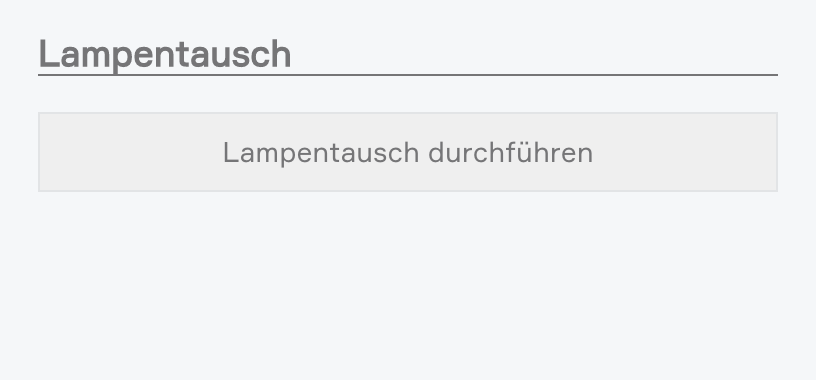
Lampentausch:
Falls Sie eine Lampe tauschen müssen, muss diese wieder neu adressiert werden.
Mit Hilfe der Funktion "Lampentausch" im Parameter Panel wird Ihre neu verbaute Lampe automatisch adressiert.
Alle Szenen und Verknüpfungen in Ihrem evon Smart Home bleiben erhalten.
Falls Sie immer alle Lichter einer Linie gemeinsam schalten möchten, empfiehlt es sich den Expertenmodus zu deaktivieren. Das Schaltverhalten ist dann wesentlich synchroner als durch das verknüpfen aller einzelnen Lichter.
Blind
The app “Blinds” lets you operate and configure all shading elements in your system. You also have pre-defined functions such as “open all blinds” and “close all blinds”.

You can find Blinds under “all apps”.
Usage

You can open or close your shading element using the arrows in the left-hand side of the object panel. The right-hand side of the panel shows the current position and the angle of the blinds.

You can also operate each blind element via the operator panel by using the sliders on the right and on the left, or dragging the point in the middle of this window to the desired position. If you have defined a favourite position and wish to use it, simply click on the button “go to favourite position”.
Szenen
Die Beschattung bietet folgende Funktionen für evon Smart Home Szenen (Dann...):
- Alle auf erste Favoriten Position fahren: Alle Beschattungselemente werden auf die jeweils erste eingestellte Favoriten-Position gefahren
- Alle auf Position fahren: Alle Beschattungselemente werden auf eine frei definierbare Position und einen frei definierbaren Lamellen-Winkel gefahren
Der Beschattung bietet folgende Funktionen für evon Smart Home Szenen (Dann...): Alle Beschattungselemente werden auf einen frei definierbaren Winkel gestellt - Alle stoppen: Alle Beschattungselemente werden gestoppt
- Alle öffnen: Alle Beschattungselemente werden geöffnet
- Alle schließen: Alle Beschattungselemente werden geschlossen
- Auf Favoriten Position fahren: Das Beschattungselement wird auf die definierte Favoritenposition gefahren.
- Auf Position fahren: Das Beschattungselement wird auf eine frei wählbare Position und einen frei wählbaren Lamellen-Winkel gefahren
- Auf Winkel stellen: Das Beschattungselement wird auf einen frei wählbaren Lamellen-Winkel gefahren
- Öffnen: Das Beschattungselement wird vollständig geöffnet
- Schließen: Das Beschattungselement wird vollständig geschlossen
- Stoppen: Das Beschattungselement wird gestoppt.
Beschattungselemente können unter den Einstellungen von Universalszenen ausgenommen werden. Für ausgenommene Elemente werden die Szenen-Funktionen "Alle..." nicht angewendet.
Configuration
Apart from giving the shading elements individual names, you can customize them further to suit your needs.
Settings

Mode
This option is available when an 'evon Smart Home Blind 1344' (Schlotterer RETROLux) module is used. It allows to change the operation mode from 'standard blind' to 'without working position' or 'with working position'. In this case, 'working position' refers to a blind with a mechanical working position.
With working position
This mode is meant for use with the Schlotterer RETROLux venetian blind, which has a mechanical working position. It allows you to change the slat position with a short button press and to switch between 'closed' and 'working position'. In this mode, the slats can only be adjusted to a certain limit, which is caused by the underlying mechanical construction of these blinds.
Without working position
Choose this mode if you own a Schlotterer RETROLux venetian blind, which does not not have a working position. This mode grants you the ability to simulate a working position.
Type
Type lets you select whether the blind is a jalousie, a rolling shutter or a window (windows will be dealt with in an extra chapter). The jalousie has a position, an angle of the slats and a turnaround time, all of which must be considered in the calculation. A rolling shutter does not have an angle.
Vertical jalousie
If you have a jalousie that opens and closes vertically, then you can configure it here. If this is activated, you are then presented with a further option defining the direction you wish the jalousie to open.
Remove from universal scene
A universal scene could be “open all blinds”. However, if you want this shading element to be excepted from this universal scene, then activate this option.
Remove from wind-lock
If you do not want this blind to open in strong wind, then activate this option. If this option is not visible, then activate the wind-lock in the settings “all-apps – settings – shading”.
Lock blind
Use this option to lock a blind, which means that the shading position can no longer be changed via the app or the button.
Close at dusk
If you want the shade to close at dusk, then activate this option.
Reserve
If you have a module that has reserve connections, i.e. blinds are not connected to every output, then these elements are still displayed. The reserve function allows you to hide unused shading elements in the app. If you wish to see these unused elements, activate them in the corresponding module in the hardware section.

Extended parameter
If you use the 'evon Smart Home Blind 1344' module in combination with a Schlotterer venetian blind (and select the correct operation mode) additional options will be available to you here.
Those refer to the varied motion times, which are specific to Schlotterer blinds, like working position/snapping times. This settings are pre configured for optimal operation. In case you encounter any problems when switching between positions (working mode/closed) please contact your evon Smart Home partner, who can adjust those settings for you.
Travel Times

Travel time wizard
This wizard lets you easily and simply determine the travel times for your shading element. Simply follow the instructions and your travel times will be configured for you.
Use these travel times for all blinds
Pressing this button opens a dialog where you can have all blinds use these travel times. This is useful if all blinds are of the same type and you do not wish to have individual times for each blind.
Favorite Position

You can save your favourite blind position either by entering the values by hand or pressing the button “use current position as favourite”. The favourite position can be triggered via a scene.
Linking
Linking allows you to connect your shading elements to other elements in your evon Smart Home.

Connect with
If you want two shading elements to always have the same position and slat angle, then use this “connect with”. Navigate to “connect with” and press “select” to choose the shading element you wish to connect to.
Gruppenfunktion
Über die Gruppenfunktion lassen sich mehrere Beschattungen zu einer Gruppe zusammenfassen. Dadurch werden alle gleichzeitig geschalten.

Um eine neue Beschattungsgruppe anzulegen, wählen Sie "Neue Beschattungsgruppe" innerhalb der Beschattungs App.

Eine neue Beschattungsgruppe wird erstellt.

In den Einstellungen der Gruppe sollten Sie als erstes einen Namen vergeben und einen Raum zuordnen.
Hier haben Sie außerdem die Möglichkeit, die Gruppe zu deaktivieren. Dadurch können Sie eine bereits konfigurierte Gruppe temporär abschalten, ohne sie löschen zu müssen.

Fügen Sie nun mehrere Beschattungselemente hinzu. Sie habe die Möglichkeit die Gruppe in 2 Betriebsarten zu betreiben: „Starre Kopplung“ oder „Lose Kopplung“.
Starre Kopplung: Dieser Modus ist sinnvoll, wenn Sie Beschattungselemente der gleichen Größe (Fensterhöhe) zu jeden Zeitpunkt auf derselben Position wünschen. Alle Beschattungselemente einer Gruppe fahren somit immer auf dieselbe Position und den Lamellenwinkel (falls vorhanden). Dabei ist es unerheblich ob der Befehl als Einzelbefehl über die App, als Gruppenbefehl über die App, den Autark-Taster oder den Gruppentaster erfolgt ist, die Position wird immer synchronisiert.
Lose Kopplung: Dieser Modus erlaubt das gemeinsame Heben und Senken von unterschiedlichen Beschattungselementen über einen oder mehrere Gruppentaster. Die Beschattungselemente können aber jederzeit über Einzelbefehle aus der App oder den Einzeltaster (Autarkfunktion) individuell positioniert werden.
Settings
Settings contains the configuration for general settings that are valid for all shading element. Navigate to “all apps – settings – blinds”.

Mode
Short button press – completely up: If the blinds button is pressed for a short period of time, then the blinds will travel in the desired direction until either the blinds are fully open/closed, or a further press of the button causes them to stop where they are. A long button press sets the angle for the slats, i.e. after a wait time to correctly identify a long button press, the blind slats begin to turn until the button is released.
Short button press - set slats: A short button press changes the angle of the blinds and a long button press completely opens or closes the jalousie. A second button press interrupts the travel and the jalousie stops where it is.
Over-travel time
The over-travel time lets you define the percent of time to increase the time that the jalousie takes for completely UP to completely DOWN. This makes sure that the blinds are really open or closed.
Activate wind lock
If you have activated this option, then all shading elements are closed if it is windy. If you want to exempt elements from this wind lock, it can be done for each individual element.
Close at twilight
If “close at twilight” is selected, then all blinds will close as soon as twilight is detected. If you do not want all blinds to close at twilight, then deactivate “close at twilight” for each individual blind. In addition, you can also delay the closing at twilight by entering the number of minutes you wish to wait after twilight until the blinds close.
Indoor climate
The app “indoor climate” lets you operate and configure all room climate elements in your system. You also have the pre-defined central functions “all frost protection mode”, “all comfort mode” and “all energy saving mode”.

The app is located under “all apps” – “indoor climate”.
Usage

Clicking on the left-hand area of the object panel switches back and forth between comfort mode and energy saving mode.

You can also select the operating mode using the three buttons located next to each other in the operator panel. The desired temperature can be adjusted in the circle above these buttons via the “+” and “-“ buttons, or you can simply click on the position in the circle that you want.
Configuration
General

Deactivate individual room control
If you have a module type C1144, you can deactivate a connected room control panel with this setting. In this case, only the actual value is taken from the room control panel. All other values are ignored.
External actual value
If you have a module type C1244, you can activate this setting to receive the actual value from another source than a connected PT1000. If you use this setting, you will have to choose the new source in the linkpanel.
Cooling disabled
This setting allows you to deactivate cooling for the connected climate device. Additionally, while this option is active, the cooling mode from the global settings will also be ignored.
Permanent ON/OFF
The valve output can be permanently switched on or off, independently of the current temperature and the current operating mode.
Remove from universal scene
The valve output can be permanently switched on or off, independently of the current temperature and the current operating mode.
Display actual/desired value
This value determines whether the actual or desired value should be displayed in the object panel.
Reserve
Even if not all room climate channels are connected to a module, all four control elements are still displayed for this module. If you want to hide these unconnected control elements, then mark them as reserved. You can unhide them via the app “hardware” (all apps – “hardware”).
Setpoints

The desired values for the various operating modes are defined here. Clicking on the button “use this desired value for the entire room climate” opens up a dialogue with which the desired values in this room climate element can also be used for all other elements.
Presence Rise

If the presence button on the room control panel is pressed, the desired temperature of the room is increased by the defined value and time period.
Temperature Limit

The item “temperature limit” lets you define a temperature limit, i.e. you can react with a scene if the value falls below or exceeds the limit. You can also activate notifications for falling below or exceeding the limit via “notifications for temperature limits”.
Regler
Bei C1144 und C1244 Modulen mit Firmware 4.0 oder höher kann die Art des Reglers eingestellt werden. Dieser kann entweder als Zweipunkt oder PWM Regler konfiguriert werden.

Zweipunkt Regler
Der Zweipunkt Regler ist die einfachste Form eine Heiz- oder Kühl-Regelung zu realisieren. Der Zweipunktregler vergleicht den Istwert mit dem Sollwert und schaltet in Abhängigkeit der Hysterese den Ausgang bei Überschreitung oder Unterschreitung Aus oder Ein. Die Hysterese dient dazu die Schalthäufigkeit (Frequenz) des Ausgangs zu begrenzen.
Folgende Einstellungen können gesetzt werden:
- Hysterese Heizen
Die Hysterese beim Heizen definiert den Totbereich zum Umschalten des Zustandes. Bei einem Sollwert von 22° und einer Hysterese von 1°, schaltet die Heizung bereits bei 21.5° ein und erst bei 22.5° wieder aus. Das verhindert das Schwingen des Ausganges. - Hysterese Kühlen
Gleich wie beim Heizen kann auch eine Hysterese zum Kühlen eingestellt werden.

PWM Regler
Der PWM Regler (Pulsweitenmodulations-Regler) ist eine erweiterte Möglichkeit zur Regelung von Heiz- oder Kühlsystemen. Der PWM Regler nützt die Trägheit von Systemen aus, um im Vergleich zum Zweipunktregler (Ein, Aus) sehr viele Ausgangszustände abbilden zu können. Der PWM Regler arbeitet dabei auch nur mit einem digitalen Ausgangssignal, dieses wird jedoch innerhalb einer definierten Periodendauer so geschaltet, dass in Abhängigkeit der Soll-/Ist-Temperaturabweichung der Ausgang mit unterschiedlichen Puls- (Ein) und Pausenzeiten(Aus) angesteuert wird. Ein träges System (z.B.: Thermostellantrieb in einer Fußbodenheizung) kann durch diese Art sehr intelligent von 0-100% geregelt werden.
Beispielhafte Funktionserklärung:
Solltemperatur 22°C, Isttemperatur 21,3° ergibt eine Abweichung von 0,7°C. 0,7 + Offset von 0,2 Multipliziert mit einem Kp von 100 ergibt einen Wert von 90%. Der PWM Regler wird in diesem Fall bei einer Periodendauer von 300sec (5min) den Ausgang (Ventil) 270sec aktiv ansteuern (90% von 300sec).
-
Periodendauer
Die Periodendauer definiert den gesamten Zeitbereich für die Berechnung der Puls- Pausenzeit. Die Periodendauer muss der Zeitdauer für das vollständige Ansprechen des verknüpften Ausgangs entsprechen.
Beispiel Thermostellantrieb: Die Periodendauer entspricht der Zeit welche vergeht, bis der Stellantrieb nach der Ansteuerung vollständig geöffnet ist.
Beispiel Infrarotheizung: Die Periodendauer entspricht der Zeit welche vergeht, bis das Panel nach der Ansteuerung die maximale Heizleistung /Wärme abstrahlt. -
Kp
Der Verstärkungsfaktor Kp definiert die Verstärkung des berechneten Ausgangswertes (Pulse/Pause) in Abhängigkeit von Soll-/Isttemperatur. Eine Erhöhung von Kp führt bei gleichbleibender Abweichung von Soll-/Isttemperatur zu einem erhöhten Ausgangswert. Kp kann somit als ein Multiplikationsfaktor der Abweichung betrachtet werden. -
Offset
Eine reine Multiplikation über den Verstärkungsfaktor Kp würde nicht zum genauen erreichen von Solltemperatur gleich Isttemperatur führen. Das Offset führt somit eine leichte Manipulation der berechneten Temperaturabweichung aus und führt somit zur schnelleren Erreichung der gewünschten Isttemperatur. Der Wert für das Offset sollte im Regelfall immer unter 1°C ausreichend sein.
Expertenmodus
Bei den Klimamodulen C1144 und C1244 mit Firmware Version 4.0 oder höher steht ein Expertenmodus zur Verfügung über welchen die allgemeine Konfiguration des Moduls erfolgt. Dieser muss direkt im Modul unter Hardware konfiguriert werden.

Expertenmodus
Wenn der Expertenmodus aktiviert ist kann der Modus des Moduls und die Ein und Ausgänge entsprechend der tatsächlichen Ein- und Ausgänge konfiguriert werden.
Außerdem werden dann auch in der Detailansicht des Moduls die Ein- und Ausgänge angezeigt.
Konfigurationsmodus
Der Konfigurationsmodus kann auf folgende Werte eingestellt werden, welche weiter unten erklärt werden:
- 4 Räume (Standard)
- 2 Räume
- Universal
- Ohne Autark Funktion
Durch Auswahl von DI/AI 1-4 können die Eingänge konfiguriert werden.
Istwertquelle
Definiert von wo der Istwert für den Regler kommt. Je nach Modus stehen folgende Werte zur Verfügung:
- DI/AI 1-4
Nimmt den Wert des jeweiligen Eingangs - Externer Temperaturfühler
Nimmt den Wert, welcher im Parameter Panel des entsprechenden Raumklimas eingestellt wurde.
Eingangsmodus
Definiert was am Eingang angeschlossen ist. Je nach Modus stehen folgende Werte zur Verfügung:
- Raumbediengerät
Standard evon Smart Home Raumbediengerät. - Raumbediengerät - Nur Temperaturfühler
Bei Temperaturfühlern an einem C1244 Moduls oder bei evon Smart Home Raumbediengeräten welche nur einen Temperaturfühler verbaut haben. - Sperrkontakt
Ein Kontakt welcher die konfigurierten Ausgänge sperrt. Zum Beispiel ein Taupunktwächter zum Sperren der Kühlung. - DI/AI
In diesem Modus kann der Ausgang wie ein Digitaler/Analoger Eingang verwendet werden.
Durch Auswahl von DO 1-4 können die Ausgänge konfiguriert werden.
Ausgangsmodus
Definiert was am Ausgang angeschlossen ist. Je nach Modus stehen folgende Werte zur Verfügung:
- Ventil Heizen
Ventil welches nur zum Heizen verwendet wird. - Ventil Kühlen
Ventil welches nur zum Kühlen verwendet wird. - Ventil Heizen/Kühlen
Ventil welches zum Heizen und Kühlen verwendet wird. - DO
In diesem Modus kann der Ausgang wie ein Digitaler Ausgang verwendet werden.
Sperrkontakt
Definiert durch welchen Sperrkontakt das Ventil gesperrt werden soll. Dafür muss ein entsprechender Eingang als Sperrkontakt konfiguriert sein.
Sperrkontakte können nur beim Modul C1144 verwendet werden.

Modus: 4 Räume (Standard)
Dieser Modus eignet sich für Räume in welchem nur ein Ventil zum Heizen und/oder Kühlen verwendet wird. Wie zum Beispiel bei der standard Fußbodenheizung.
Somit können 4 Räume auf einem Modul konfiguriert werden.
In diesem Modus kann kein Sperrkontakt vergeben werden.

Modus: 2 Räume
Dieser Modus eignet sich für Räume in welchem zwei getrennte Ventile verwendet werden. Zum Beispiel ein Ventil zum Heizen und ein Ventil zum Kühlen.
Somit können 2 Räume konfiguriert werden.
Hier kann Eingang 2 und Eingang 4 als Sperrkontakt oder Digitaler Eingang verwendet werden.

Modus: Universal
Dieser Modus eignet sich für Räume in welchen ein Mehrstufiges Heiz- oder Kühlsystem vorhanden ist. Zum Beispiel wenn über den Fußboden geheizt und gekühlt wird und zusätzlich über die Decke gekühlt wird oder bei einer gestaffelten Infrarot Heizung über Fußboden, Decke und Wand.
Hier kann für die Eingänge 2-4 die davor liegenden Eingänge als Istwert verwendet werden, wenn zum Beispiel das Raumbediengerät am Eingang 1 angeschlossen wurde. Die anderen Eingänge können dann als Sperrkontakte oder Digitale Eingänge verwendet werden.
In diesem Modus wird pro Regelkreis ein eigener Regler angelegt, um eine erleichterte Bedienung zu erhalten, können diese in einer Zonenregelung zusammengefasst werden.

Modus: Ohne Autark Funktion
In diesem Modus werden die Regler am Modul deaktiviert. Dann werden die Ein- und Ausgänge wie Digitale Ein- und Ausgänge verwendet und müssen zum Beispiel über die Logik ausgewertet und geschalten werden.

Wenn sich das Modul im Expertenmodus befindet kann in der Anzeige der Kanäle, in den Parametern des Raumbediengerätes oder des Temperaturfühlers eine Korrektur des Istwertes eingestellt werden. Dadurch wird der vom Sensor gemessene Istwert um den eingestellten Wert erhöht/vermindert.
Linking
Links allow you to connect your room climate with other elements in your evon Smart Home.

Window contact
To ensure that heating is suspended when a window is open, you can add as many windows as you want via the button “add”. If one of these windows is opened, the heating will automatically enter into frost protection mode. As soon as the window is closed, comfort mode will be reactivated.
Settings
The settings for all room climate elements can be found under “all apps” –“settings” – “indoor climate”.

Can cool
If your heating system supports cooling, then you can activate this option. Warning! If your heating is not suitable for cooling, using this option could lead to malfunction. If in doubt, please contact a heating specialist.
Szenen
Das Raumklima bietet folgende Auslöser für evon Smart Home Szenen (Wenn...):
- Hohe Luftfeuchtigkeit erkannt: Die konfigurierte maximale Luftfeuchtigkeit wurde überschritten.
- Geringe Luftfeuchtigkeit erkannt: Die konfigurierte minimale Luftfeuchtigkeit wurde unterschritten.
Das Raumklima bietet folgende Funktionen für evon Smart Home Szenen (Dann...):
- Auf Energiesparen umschalten: Der Status Energiesparen wird für den Heiz -/Kühlkreis aktiv und die Sollwerte für Energiesparen werden angewendet
- Auf Frostschutz umschalten: Der Status Frostschutz wird für den Heiz -/Kühlkreis aktiv und die Sollwerte für Frostschutz werden angewendet
- Auf Komfortbetrieb umschalten: Der Status Komfortbetrieb wird für den Heiz -/Kühlkreis aktiv und die Sollwerte für Komfortbetrieb werden angewendet
Zonenregelung

Mit Klimamodulen ab der Firmware Version 4.0 können die einzelnen Kanäle über eine Zonenregelung gesteuert werden.
Dies ermöglicht das einfachere Bedienen von Räumen welche mehrere Heiz- und/oder Kühlkreise besitzen.
Über "Zonenregelung hinzufügen" kann eine neue Zonenregelung erstellt werden.

Im Operatorpanel kann über die drei nebeneinander liegenden Buttons die Betriebsart ausgewählt werden. Im Kreis oberhalb dieser Buttons können Sie die Solltemperatur anpassen über die Buttons “+” und “-” bzw. indem Sie auf die gewünschte Stelle im Kreis klicken. Diese werden dann auf alle verküpften Raumklima Elemente übertragen.

Außerdem wird der aktuelle Status der verknüpften Raumklima Elemente angezeigt.

Im Parameterpanel kann ein Default Wert für die Sollwerte eingestellt werden. Diese werden dann auf alle verknüpften Raumklima Elemente übertragen.

Außerdem können hier Raumklima Elemente verknüpft werden.
Pro Raumklima Element kann ein Sollwertoffset für Heizen und/oder Kühlen vergeben werden. Dieser passt die Sollwerte für das entsprechende Element an.
Ein Offset von 3°C beim Heizen, passt einen Default Sollwert von z.B. 21°C auf 18°C an, dadurch setzt die Heizung erst später ein. Beim Kühlen passt dieser den Sollwert von z.B. 21°C auf 24°C an.
Dadurch kann zum Beispiel erreicht werden, dass bei vorhanden sein einer Decken und Bodenkühlung, zuerst die Deckenkühlung aktiviert wird und nur wenn trotz dieser die Temperatur steigt wird die Bodenkühlung aktiviert.
In- and Outputs
A few inputs and outputs in evon Smart Home are used similarly in different modules. This is described in this section.
Switches
A switch can be connected to a light module, blind module or a digital module. A switch has a pre-defined function for a light or blind module. Every switch can be simulated in evon Smart Home for test purposes.
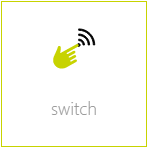
These switches can be found under “all apps” – “switches”.
Configuration

Naming
If you have connected your switch to a light or shading module, then the switch is automatically named according to the light or blind. If you wish to give it a different name, then deactivate the option “same name as blind/light” in the parameter panel and give the switch a new name. If you have connected your switch to a digital module, then you must name it yourself.
Reserve
If you have a switch in your system that you don’t use, then you can hide it by deactivating the option “reserve “hide in display” in the app “ switches”. To unhide it, you can find your switch in the app “hardware”.
Mode
If you want to change the mode, i.e. define the switch as a presence detector or a digital input, then you can do this in the parameter panel under “mode”. Not every module can change the mode however, or not all possibilities are available. This means that the light modules’ switch can only be converted to a presence detector. Switches for a blind element cannot be converted. Switches for digital modules have all three modes.
Simulation

If you have linked a switch to a scene and would now like to simulate this scene, then there is no need to go to the switch and press it every time, you can use simulation to create the switch press. Simply activate the option “simulation” in the operator panel to see 3 buttons that you can use to simulate switch presses.
Warning: If you leave the simulation mode activated, the autonomous functions will not work!
Scene
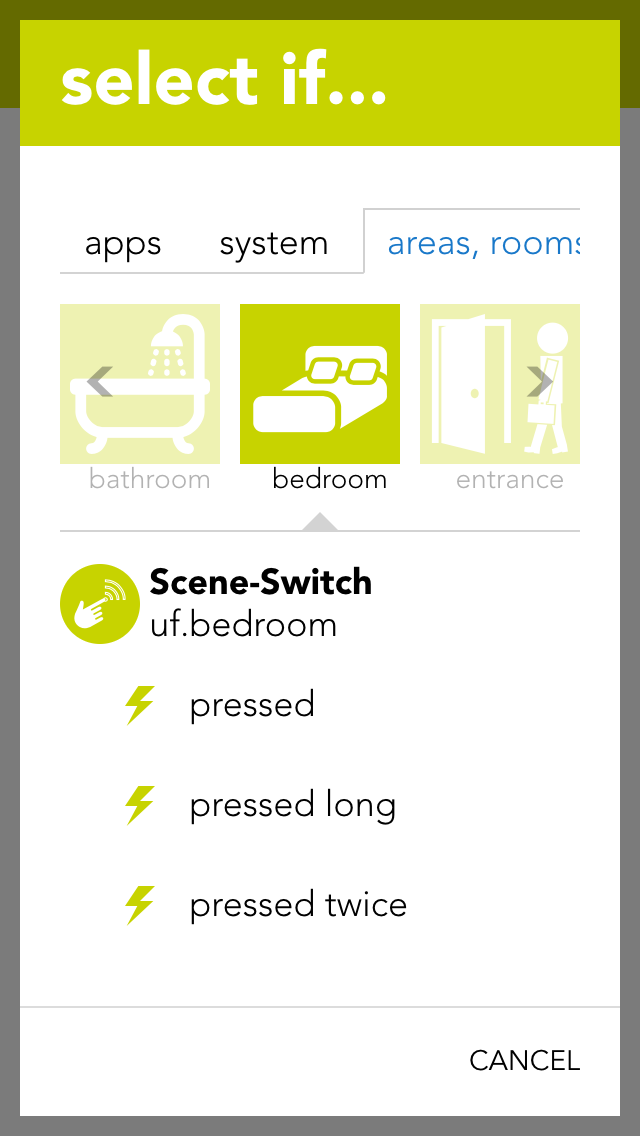
You can use the switches for a scene (assuming it as been named). In the scene “if …” just select the switch and decide if you want the scene to be executed after a single, double or long press.
Settings
Open the switches settings (“all apps” – “settings” – “switches”) if you want to define the times for a press and double-press. Select the desired values and confirm them by clicking the button “use values for all switches”.

Hold time (long button press)
A switch must be pressed for at least thus time to be recognized as a long button press.
Wait time (double-press)
The gap between two switch presses must be as least as big as the defined wait time to be recognized as a double-press.
If you wish to define different values for a switch that is connected to a blind module, then activate the option “use other values for blinds”.
Motion Detector
A motion detector can be connected to a light module or a digital module. The motion detector has a pre-defined function when connected to a light module. Motion detectors can be simulated in evon Smart Home for test purposes.

You can find motion detectors under “all apps” –“motion detectors”.
Configuration

Naming
If you have connected a motion detector to a light module, then it is automatically assigned the same name as the light. If you wish to assign a different name, then deactivate the option “same name as light” in the parameter panel and enter the name you wish. If the motion detector is connected to a digital module, then you must assign it a name yourself.
Invert
If the motion detector is connected to a digital module, you have the possibility to invert the logic by activating the option “invert” in the operator panel.
Reserve
Should you have a motion detector in the system that you do not use, you can hide in from the app “motion detector” by activating the option “reserve (hide in display)” in the parameter panel. To unhide it, you will find your movement detector in the app “hardware”.
Mode
If you wish to change the mode, i.e. convert the motion detector input to a switch or a digital input, you can do this by changing the mode for the motion detector in the parameter panel. Not all modes can be changed in all modules, or not all possibilities are available. This means that a motion detector for a light module can only be changed into a button. All three modes are available for motion detectors for a digital module.
Scenes
You can also use the motion detector for a scene (in as far as it has been named). In the scene, select the motion detector for “if …” and decide if you want the scene to be carried out on the rising or falling edge of the signal.

Rising edge
The electrical contact of the motion detector has been activated.
Falling edge
The electrical contact of the motion detector has been deactivated (after the internal time of the motion detector).
Simulation

For example, if you have linked a motion detector to a scene and you would like to test this scene, then you do not have to go to the motion detector and activate it every time, you can change the state using simulation. Simply activate the option “simulation on” in the operator panel to see the option with which you can change the state.
Warning, if you leave the simulation switched on, the autonomous function will not work!
Digital Input
You can use a digital input for functions not provided by any evon Smart Home function module. You can name each digital input and simulate then for test purposes.

You can find the app “digital inputs” under “all apps” – “digital inputs”.
Configuration

Reserve
If you have a digital input in your system that you are not using, you can activate the option “reserve (hide in visualization) to hide this digital input in the app “digital inputs”. (To unhide this, the digital input can be found in the hardware app)
Mode
If you wish to change the mode, i.e. convert a digital input into a button or a movement detector, this can be done in the parameter panel for the digital input under “mode”.
Simulation

If you have connected a digital input to a scene and would like to test the scene, you do not have to navigate to the digital input and activate it every time, you can change it directly via simulation. To do this, activate “simulation on” in the operator panel to see the option “simulation value” with which you can change the state. Warning, once the simulation has been activated, the autonomous function will no longer work! Any changes in the state of the input “hardware” will be overwritten by the simulation.
Scenes
You can also use a digital input for a scene (in as far as it has been named). Select the digital input in the scene’s “IF ….” and decide whether you want the scene to be carried out on the rising or falling edge.

Rising edge
The electrical contact of the digital input has been closed.
Falling edge
The electrical contact of the digital input has been opened.
Digital Output
The app “digital outputs” provides you with an overview of all digital outputs in your system. This is where you can name them and change the state of the outputs.

The app “digital outputs” is located under “all apps” – “digital outputs”.
You have two possibilities to change the state of a digital output. Either you can click on the power symbol on the left in the object panel or you can click on the button “switch” in the operator panel.
Configuration
You can give a name to a digital output in the parameter panel and optionally allocate it to a room.

Save output if bus fault
If the output is active when the bus connection to the CPU fails (for example if the 24V power supply to the module fails), this option lets you guarantee that the active remains activated even in a fail state. If this option is not activated, then the output is reset after every bus connection failure.
In safety-critical controllers, it should be carefully examined whether this function should be activated, since this output is kept active if the system fails.
Mode
With the mode setting, you can change the behavior of the output once it is active. The following options exist:
-
Standard
This ist the normal setting for a digital output. With this, the output stays active until the signal ends. -
Minimum on duration
With this mode, the output stays active for at least the specified time, even when it is deactivated before. -
Pulse
In this mode, the output will automatically be deactivated after the defined timeframe.
Reserve (hide in visualization)
If you have a digital output in your system that you do not use, then you can hide this digital output in the digital output app by activating the option “reserve (hide in visualization)” (located in the parameter panel). (To unhide, the digital output can be found in the hardware app).
Change mode
If you wish to change the mode, i.e. convert a digital output to a socket, then you can do this by changing the mode for the digital output in the parameter panel.
Scenes
You can also use a digital output for a scene (in as far as it has been named). In the scene’s “if …” simply select the digital output to see the following possibilities:

Switch off
The digital output is switched off.
Switch on
The digital output is switched on.
switch on for
The digital output will be switched on for a defined amount of time.
Toggle
The state of the digital output is toggled.
Socket
The app “sockets” provides an overview of all sockets in your system and allows you to name them and change their state.

The app “sockets” can be found under “all apps” – “sockets”.
You have two possibilities to change the state of a socket. Either you can click on the power symbol on the left in the object panel or you can click on the button “toggle” in the operator panel.
Configuration
The parameter panel lets you give the socket a name and optionally allocate it to a room.

Save output if bus fault
If the socket is currently active and the bus connection to the CPU fails (e.g. the 24V power supply to the module fails), then activating this option will guarantee that the socket remains active even in a fail state. If this option is not activated, then the socket is reset after every bus connection failure.
In safety-critical controllers, it should be carefully examined whether this function should be activated, since this output is kept active if the system fails.
Reserve (hide in visualization)
If you have a socket in your system that you do not user, you can hide this socket in the app “sockets” by activating the option “reserve (hide in visualization) (located in the parameter panel). (To unhide, the socket can be found in the app “hardware”).
Change mode
If you want to change the mode, i.e. convert socket to a digital output, then this can be done by changing the mode in the socket’s parameter panel.
Scenes
The socket can be used for a scene (in as far as it has been named). In the scene’s “if….”, select the socket and one of the following possibilities:

Switch off
The socket is switched off.
Switch on
The socket is switched on.
Switch on for
The socket is switched on for the time you define.
Toggle
The status of the socket is toggled.
Analog Input
An analog input can measure voltage in the range 0-10V. This voltage is then scaled to the range defined by the user. This value can be used by the user for calculations (using logic), or simply to trigger scenes if the value exceeds or falls below certain (definable) limits.

The analog inputs are located under “all apps” – “analog inputs”.
Configuration

Minimum/Maximum
Minimum and maximum limits of the measured value. These inputs must be taken from the description of the sensor used. For example, you wish to measure the humidity in a room and use a sensor with a 0-10V output signal. The sensor documentation tells you that the sensor can measure humidity from 0% to 100%. The minimum limit is hence 0 and the maximum limit is 100.
Number of decimal places
Indicates the number of decimal places used to calculate the value.
Dimension
This is where you define exactly what you wish to measure with this analog input (e.g. temperature °C).
Notification on limit violation
If the value of the analog input falls below the lower limit or exceeds the upper limit, then you will be notified by the system if this checkbox is activated.
Upper limit
Enter the upper limit here. If the value exceed this limit, you can react with a scene by selecting the trigger for “value above upper limit” in the “IF …” statement.
Lower limit
Enter the lower limit here. If the value falls below this limit, you can react with a scene by selecting the trigger for “value below upper limit” in the “IF …” statement.
Szenen
Der Analoge Eingang bietet folgende Auslöser für evon Smart Home Szenen (Wenn...):
- Obere Grenze wurde überschritten: Die parametrierte obere Grenze wurde vom Messwert überschritten
- Untere Grenze wurde unterschritten: Die parametrierte untere Grenze wurde vom Messwert unterschritten
Data Description

Raw value
A raw value is the voltage (0-10V) measured on the input of the module.
Raw value (phys.)
Corresponds to the output of an analog/digital converter and is used for the calculation into the physical measured value.
Value
Corresponds to the scaled value resulting from the raw value, minimum and maximum.
Value = (Raw value phys. / Raw value phys. MAX) * (Maximum – Minimum) + Minimum.

The Operatorpanel of the selected Analog Input also provides you with a chart, which keeps track of the measured values.
Simulation
If you wish to simulate the value for an analog input, this is easily done by activating the option “simulation on” in the operator panel and selecting the desired value in the slider. This can be useful if you have defined a scene you wish to be carried out if a limit is exceed and you wish to test what happens.
Analog Output
An analog output outputs voltages in the range 0-10V. To do this, enter a value in your defined area and this will be output as a voltage between 0-10V.

The analog outputs can be found under “all apps” –“analog output”.
Configuration

Minimum/Maximum
The calculated value is in the range between the minimum and maximum. This means that if 10V are meant to be present on the module output, then the value must be set to the defined maximum value (100%).
Number of decimal places
Defines the number of decimal places for the calculation.
Dimension
Define here what you wish to control with this analog output (e.g. speed: %)
Stored value upon bus error
If the control were to fail, the last value would be stored if you have activated this option. If you did not activate this option, the value present when the control failed will be lost.
Szenen
Der Analoge Ausgang bietet folgende Funktionen für evon Smart Home Szenen (Dann...):
- Wert schreiben: Ein frei definierbarer Wert kann auf den analogen Ausgang geschrieben werden
Data Description

Raw value
The raw value is the voltage 0-10 V that is present (set) on the output of the module.
Raw value (phys.)
This is the digital value sent to the module.
Value
This is the scaled value that has been converted to the defined range between minimum and maximum, with the defined number of decimal places and the defined dimension.
Setting Values
There are two different possibilities to set a value to the analog output. Either you set the value via the operator panel for the analog output, or you select the analog output in a scene for the “if …” statement and then select “write value”. Then you can change the value by clicking on the pencil.
Temperature Sensor
You can view all the module channels to which you can connect temperature sensors (e.g. PT1000) in the app “temperature”.

The temperature sensors can be found under “all apps” – “temperature”.
Configuration

With module A1240, you can only set the temperature limits (as described in the item “scene” above). This module can only accept temperature sensors of type PT1000.
If you posses a module of type A1380, you can connect temperature sensors of type PT1000, KTY81-110 and KTY81-210. To ensure that the modules know which sensor has been connected, you must navigate to the parameter panel for this temperature sensor and select the type under “mode”.
Simulation

If you want to know what happens if the temperature rises above or falls below a certain value, then you don’t need to cool or heat the temperature sensor. You can use the option “simulation” in the operator panel. Simply activate the checkbox “simulation on” and enter the desired temperature in the input field that appears. Warning, do not forget to deactivate the simulation when you have finished testing.
Usage
Hier werden Dir einige Beispiele beschrieben wie Du einen Temperatursensor verwenden kannst.

Outside temperature
If you want a temperature sensor in your system to determine the outside temperature, you need to add it using the button “add” in the global settings under the item “outside temperature” and drag it to the first position. (More information in this in the documentation for global settings).
External current value for room climate zone
If you want to use this temperature sensor as an actual value for a room climate zone, then you must set the mode to “external actual value” in the desired room climate zone under “settings” and then connect the temperature sensor with it (more detail in the chapter “room climate”).
Scene
In order to link a temperature sensor with a scene, you must first allocate a name to it. Then you can set an upper and a lower temperature limit in the parameter panel that you can use in the scene for the “if …” statement. You can create a scene for the temperature falling below the lower limit or rising above the upper limit.
Logic
If you are an expert with the app “logic”, you can also use this temperature sensor here by connecting the input of a logic element with the current temperature reading.
Szenen
Die Temperatur App bietet folgende Auslöser für evon Smart Home Szenen (Wenn...):
- Obere Grenze überschritten: Das konfigurierte obere Temperaturlimit wurde überschritten
- Untere Grenze unterschritten: Das konfigurierte untere Temperaturlimit wurde unterschritten
Lüfter
Durch die Umwandlung von digitalen Ausgängen zu Lüfter können diese beispielsweise für die Ansteuerung von WC Lüfter verwendet werden. Diese Lüfter reagieren automatisch auf Lichter des selben Raums oder optional auf Taster oder Bewegungsmelder.

Sie finden die Lüfter unter „Alle Apps“ – „Lüftung“
Konfiguration
Um einen Lüfter zu erstellen können Sie einen beliebigen digitalen Ausgang verwenden. Öffnen Sie dazu das Operator Panel des gewünschten digitalen Ausgangs und ändern Sie den Typ auf "Lüfter". Der digitale Ausgang wird automatisch zu einem Lüfter umgewandelt und ist unter Lüftung zu finden.

Durch das Auswählen eines Raumes werden automatisch alle im Raum befindlichen Lichter mit der Lüftung verknüpft. Sie haben jedoch jederzeit die Möglichkeit, Lichter zu entfernen oder hinzuzufügen. Zusätzlich haben Sie die Möglichkeit, Bewegungsmelder und Taster zu verknüpfen.
Einschaltverzögerung:
Beim Einschalten des ersten verknüpften Lichtes, bzw. der ersten Betätigung eines verknüpften Tasters oder der ersten Aktivierung eines verknüpften Bewegungsmelders wird die Einschaltverzögerung aktiviert. Nach Ablauf der Einschaltverzögerung wird der Lüfter eingeschaltet.
Ausschaltverzögerung:
Nach dem Ausschalten des letzten verknüpften Lichtes, bzw. der nach der letzten Betätigung eines verknüpften Tasters oder der Deaktivierung des letzten Bewegungsmelders wird die Ausschaltverzögerung aktiviert. Nach Ablauf der Ausschaltverzögerung wird der Lüfter ausgeschaltet.
Bedienung

Im Operator Panel sowie im Object Panel haben Sie die Möglichkeit, den Lüfter zu steuern.
Durch das manuelle Einschalten des Lüfters wird der Lüfter sofort eingeschaltet und die Ausschaltverzögerung aktiviert. Nach Ablauf der Ausschaltverzögerung wird der Lüfter wieder ausgeschaltet.
Durch erneutes Einschalten des Lüfters, während die Ausschaltverzögerung aktiv ist, wird die Ausschaltverzögerung wieder zurückgesetzt.
Durch das manuelle Ausschalten wird der Lüfter sofort ausgeschaltet.
Szenen
Der Lüfter bietet folgende Funktionen für evon Smart Home Szenen (Dann...):
- Einschalten: Der Lüfter wird eingeschaltet
- Ausschalten: Der Lüfter wird ausgeschaltet
- Verzögert einschalten: Die Einschaltverzögerung wird aktiviert und der Lüfter nach dessen Ablauf eingeschaltet
- Verzögert ausschalten: Die Ausschaltverzögerung wird aktiviert und der Lüfter nach dessen Ablauf ausgeschaltet
Settings
The general settings for your evon Smart Home can be found under “all apps” – “settings”.
External access

This is where you determine whether you have Internet access to your evon Smart Home. If external access is active, then you can access your evon Smart Home using your evon Smart Home ID from anywhere.
Global Settings
Global settings let you define what is responsible in your evon Smart Home for activating wind, rain, frost, dusk states. For example, if you have connected a rain sensor, this is where you would find the settings for your system to display whether it is raining or not. The global settings can be found under “all apps” – “settings”.
Rain

You can connect the rain sensor to the appropriate input of the iX800 controller. IF you also have a weather station or Internet weather, then you need to select which element invokes “rain” in the system. Simply drag the box with the text “iX800” in the item rain to the first place (if more than one box is available) to be able to use the controller’s rain sensor input.
If you have connected your rain sensor to a digital input, then you can select it using the button “add” and drag it to the first position.
Twilight

The dusk sensor can be connected to the dusk input on the iX800 controller. If you also have a weather station or Internet weather, then you need to select which element invokes “dawn/dusk” in the system. Simply drag the box with the text “iX800” in the item dusk to the first position (if more than one box is available) to use the dusk input on the controller.
If you have connected your dusk sensor to a digital input, then you can select it via the button “add” and drag it to the first position.
Wind Alarm

Connect your wind contact to the wind input on the iX800 controller. If you also have a weather station or Internet weather, then select which element invokes “wind alarm” in your system. Drag the box with the text “iX800” in the item wind to the first position (if more than one box is available) to use the wind contact on the controller.
If you have connected your wind contact to a digital input, then select it using the button “add” and drag it to the first position.
Outdoor Temperature

You can select the value you wish to use for the outside temperature by dragging the element to the first position in the item outside temperature.
If you wish to measure the outside temperature using a sensor, you can do this by clicking the button “add”.
In addition, you can define a value for the frost and heat warning (in the parameter panel). As soon as the outside temperature rises above or below this value, a scene or a notification will be invoked.
Geo Coordinates

The sunrise and sunset times can be calculated using the geo-coordinates. These times are then used for the dawn/dusk calculations. To make sure that the dawn/dusk calculation is performed using the geo-coordinates, drag it to the first position in the item dawn/dusk.
The geo-coordinates can be entered using the decimal point format. To find out which geo-coordinates your house has, simply go to www.maps.google.at and search for your house. Right-mouse click on your location and select “what is here?” to display your geo-coordinates (the first value is north and the second east).
If you wish to change the calculated times then activate the option “adjust time for dawn/dusk”. This will let you adjust how many minutes earlier or later you wish dawn and dusk to be.
Simulation
If you wish to simulate what happens if it rains, for example, then you can simply simulate the occurrence of rain by activating the option “simulate rain” in the item “rain” and then activate the option “rain on”. This is also true for wind, outside temperature and daylight. Warning, do not forget to end the simulation when you no longer need it (e.g. deactivate “rain simulation”).
Notification

You can define which events for you would like to receive notification of in the parameter panel.
Updates
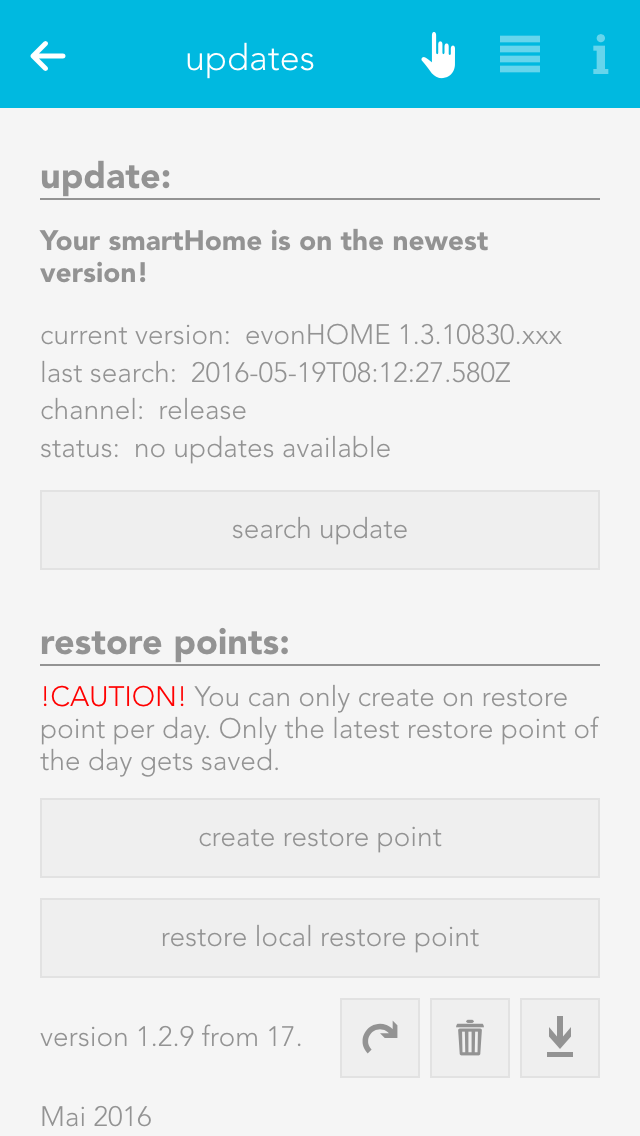
The updates screen lets you make sure your evon Smart Home is up-to-date. Simply click the button “search for updates” and if an update is available, click “execute update”. If you wish your system to automatically search for updates, activate the setting “search for updates automatically” in the operator panel. You can also see the current version and the time of the last update and the update channel here.
Furthermore, you can create recovery points, which allow you to reset your evon Smart Home to an earlier state if you have inadvertently maladjusted parameters. Such recovery points are recommended once you have named all your lights, blinds, etc. and have set them up as you require. Use the button “reset to factory setting” to reset your evon Smart Home to the original factory settings.
Saved recovery points will be shown in a list, where you can delete, recover, or download them at any time.
You can create one recovery point per day. If you create more, only the last one will be saved. In addition, you can also restore your system with a downloaded recovery file by using the button 'restore local restore point'.
A recovery point of your current configuration is created automatically before every update.
System Settings

Project name
You can give your evon Smart Home any name you like in the system settings.
Controller new start
This function restarts your system. Note that while the system is restarting, you do not have a connection to the CPU.
Manifest
This item shows you whether your visualization is up-to-date. The setting “automatic reload” lets you update your visualization automatically if it is not up-to-date.
System Diagnostic
All information pertaining to your system can be found under the item system diagnostics, such as current version, memory used, IP address, etc.

You can also look at cycle times. This is an indication of the load on your evon Smart Home system. You can also see the last five peak values. The cycle time is the time required for a complete run of the program.
Time
“Time” lets you see the current time and date used in your controller (server time), the time zone your controller is in and the time of the device you have used to connect to your evon Smart Home (mobile phone, tablet …).

The time zone lets you allocate the desired time zone to your controller. The item “set time” allows you to set the time in the controller. The button “use client time” allocates the time used by your device (mobile phone, tablet) to the controller. The button “set time manually” lets you set the time and the date for your controller yourself.
Network

This area contains all network settings for the network used by your evon Smart Home. You can also configure whether the IP address and DNS server should be automatically allocated, or whether you wish to define them yourself.
This app lets you send email notifications via an existing email account. The “test mail” function is used to test the configured settings. You will need to obtain the required settings for the SMTP server from your email provider.

You can either send a test email or you can select “send email” in the “system” tab in a scene “if …” statement. Then all you need to do is enter the sender, recipient, subject and text.
If you wish to register with your Gmail account, then you must allow “less secure apps” in your Gmail account. Simply open the link to the Google Config and click “activate”.
Dictionary

You can edit the pre-defined names in the dictionary. These names will be suggested to you when you wish to name a light, a blind, etc. However, you can even select a different name when naming your elements. The names in the dictionary are only a guide.
Devices
The “devices” app shows you all mobile devices that have been registered in your system.

The “devices” app is under “all apps” – “settings” – “devices”.
Information

If you open a device, the display shows you the name and model of the device in the operator panel. The parameter panel shows detailed information concerning the device.
Configuration

If you wish to receive notifications on this device (e.g. window is open), then you need to activate the checkbox “receive push notifications”.
Hardware
The hardware app lists all modules that are connected to your system. If you wish to obtain a list of module channels, then all elements in this module are clearly displayed and in the correct order, the way they are connected to the module. This view can make it much simpler for you to name the individual elements, since you immediately know which module and which channel you wish to name.

The hardware app is located under “all apps” – “hardware”.

Hierarchically above the modules, you can see which line the module is located in (e.g. SC1 – line 1).
Line

If you open the line, the first thing you will see at the top is general information about the line. The item “cycle time” lets you define the cycle time for your bus line (standard is 200 ms). “Required cycle time” shows the time that is required for the operations. “Total cycle time” is the time required by the bus for a cycle. “Peak” is the peak value of the cycle time. This can be reset using the button “reset peak”.
Modules

By opening a module (click on the right-hand area), you will see all necessary information pertaining to this module. The button “display channels” displays the available channels in this module. The button “reset” resets a module, meaning that this module is reset to factors settings.
Module Channels

Click on the left-hand are of the object panel or on the button “displays channels) in the operator panel to see a list of module channels. Taking a light module as an example, you will be able to see the four channels with their corresponding button/movement detector and a light. This is the exact order that the button/movement detector and light are connected to the module, i.e. channel 1 is the light that is connected on the far left of the module.
Scenes
Scenes are an easy-to-use and yet powerful tool to personalize your evon Smart Home and adapt the controller to your requirements. Without programming – directly from the app!

Scenes can help you to customize your evon Smart Home without a single line of code. This is done using the IF THEN principle, i.e. IF a button is pressed, THEN open all the blinds in the room. This principle allows you to combine almost all functions in your controller with each other and to form relationships between them. Creating scenes is not complicated. And if scenes are not sufficient, you can extend your evon Smart Home with logic.
You can find scenes under “all apps” – “scenes”.
Creating Scenes

To create a scene, simply open the app “scenes” and select “create new scene”. Then open the operator panel for this scene. Enter the name and optionally a room. Then you can start with the configuration (described below).

If you want to invoke a scene from the visualization, you can do this via the left-hand area of the object panel or via the operator panel with the button “invoke”. Otherwise the scene is invoked automatically if the condition you selected using the “IF” statement is true.
If
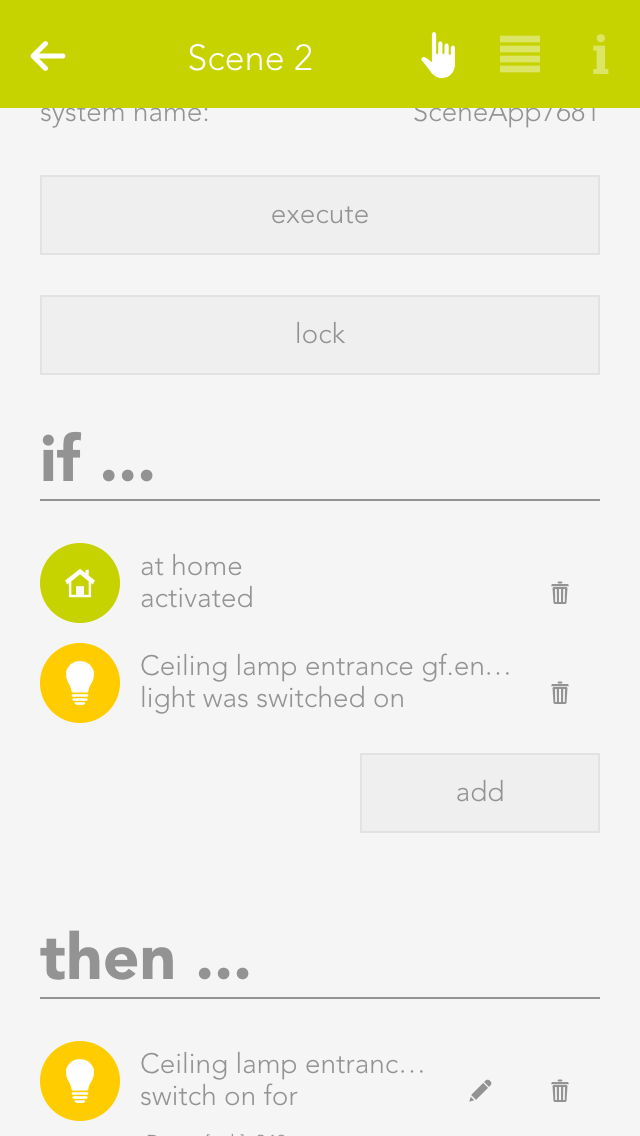
To add a trigger condition, click in the area “IF” on the button “add” and a window will open where you can add a trigger condition.
For example, if you add a button then you have three options:
- Pressed
- More press
- Double press
If you want to invoke a scene only via the app, you do not need a trigger condition.
If you wish to add several “IFs”, the scene can be invoked by each individual trigger condition, independently of each other.
Then

Click on the button “add” in the area “THEN” to select the action you wish to be invoked from the window that opens. For example, you have the possibility to switch lights on or off, to close shading elements or to move them to a specific position, etc.
For example, if you wish to move the blinds to a specific position, then you are offered the opportunity to define the exact position of this blind and the angle of the slats.
Conditions
If you only want a scene to be invoked under certain conditions (for example only if it is raining), then you can do this using conditions.
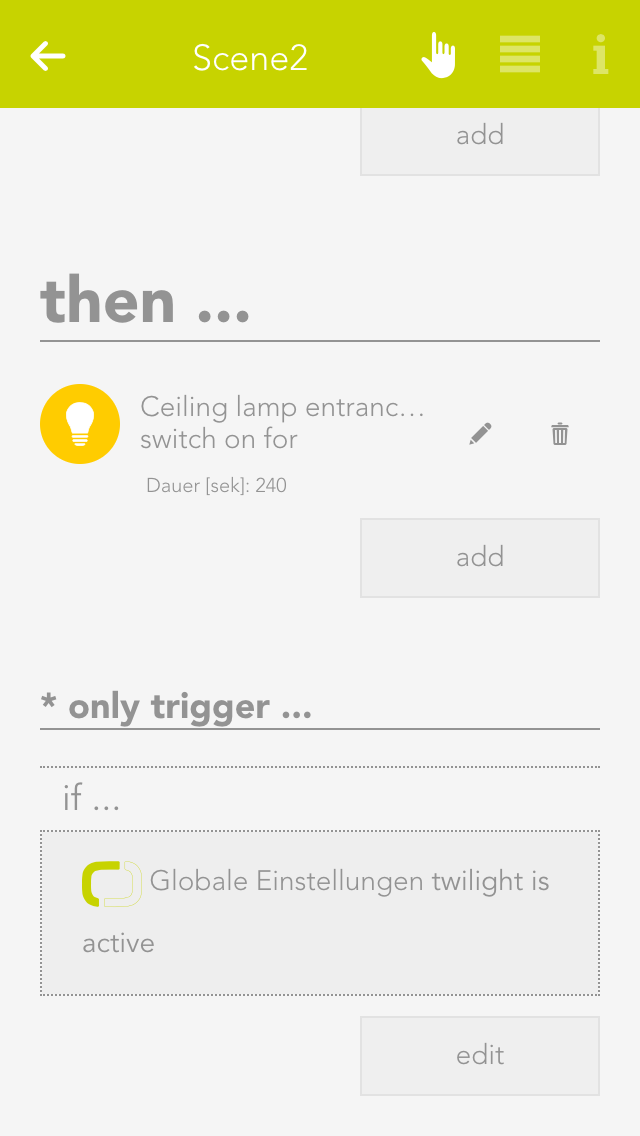
To do this, click at the bottom of the overview on “conditions”. Select here the “only invoke if” and then you can select the corresponding value (e.g. under system – house status the value “rain active”.
After adding this value, you can select others. These are combined using AND or OR logic. If several values are combined via an AND, then all must be active (e.g. “rain active” AND “wind active”) for the scene to be invoked. IF several values are combined via an OR, then at least one of these values must be active (e.g. “rain active” OR “wind active” OR “both active”).
You can edit a condition by clicking on the pencil symbol and delete it by clicking on the trash can symbol.
If a scene is locked due to condition, you can see a padlock in the left-hand area of the object panel, which is also displayed in the operator panel.
Verlauf

Im Parameterpanel haben Sie die Möglichkeit, den Verlauf der Szene einzublenden. Hier werden die letzten 50 Aktionen angezeigt.
Der Verlauf beinhaltet folgende Aktionen:
- Szene wurde ausgelöst
- Szene wurde aufgrund einer Bedingung nicht ausgelöst
- Szene wurde aktiviert
- Szene wurde deaktiviert
Examples
Garden Watering
The following example shows you how to irrigate your garden using a weekly programme and scenes.
You own a garden irrigation system and would like to activate it at defined times. The garden irrigation system is connected to a digital output, i.e. if this output is active, the irrigation system is switched on. If the output is inactive, the irrigation system is switched off.
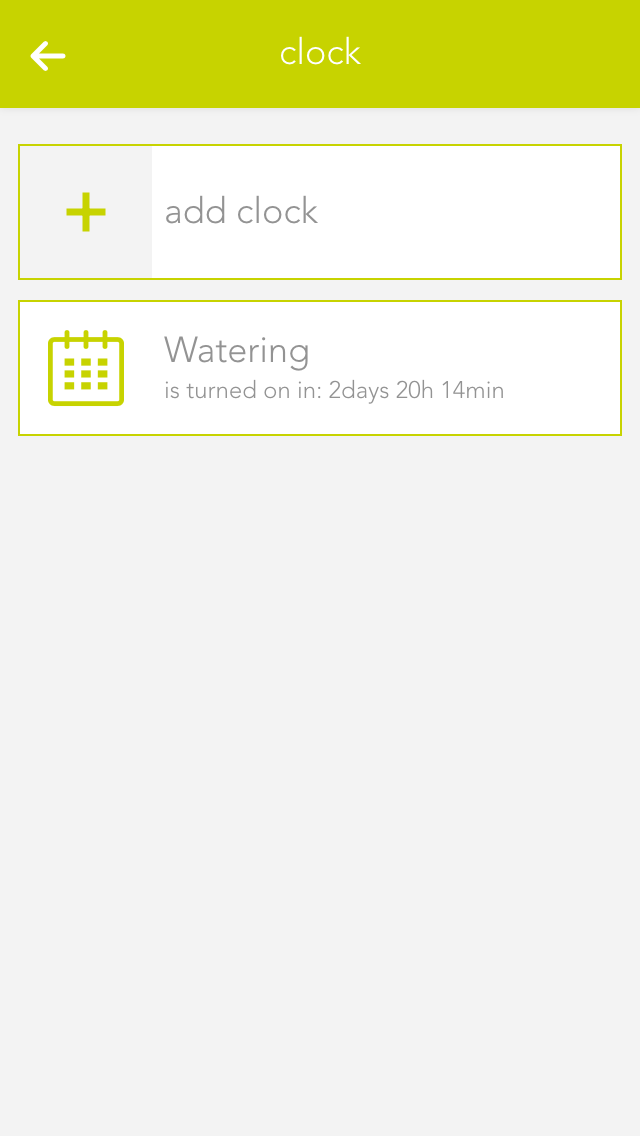
The first thing you need is a weekly programme. Create the weekly programme in the app “clock” and select “add clock”, then “weekly programme”. Next, name your weekly programme in the operator panel (e.g. garden irrigation).
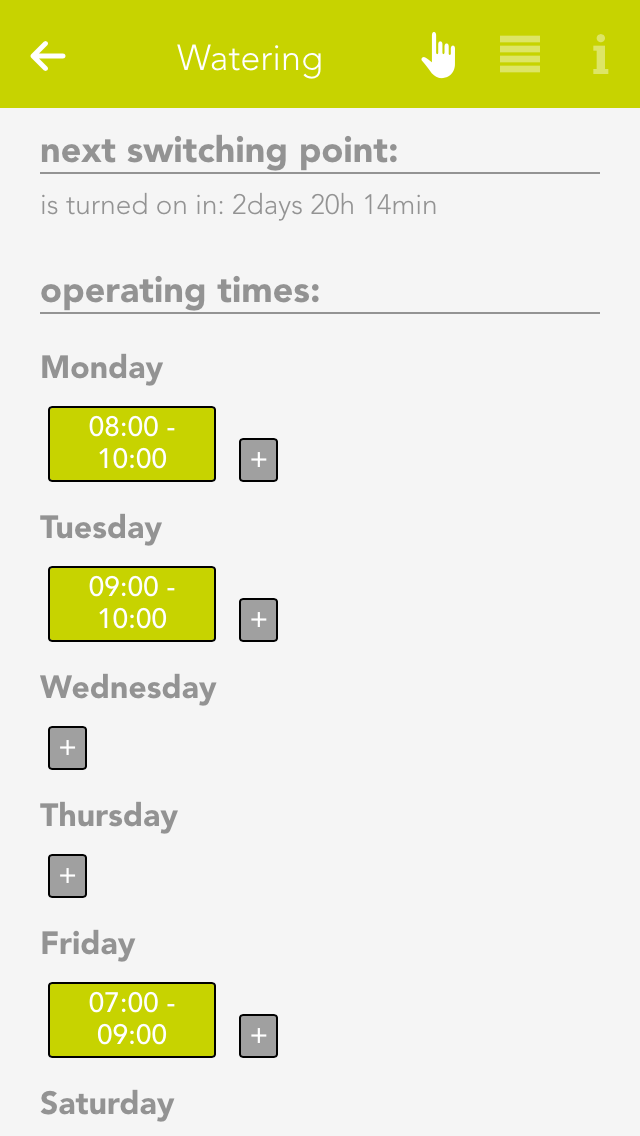
Now select the day the irrigation system should be active via the “+” button. In the window that opens, define the two times “from “ and “to”. This means the irrigation system should be active between these times (e.g. Monday from 8 am to 10 am). When you have done this, you can see the time until the next switch point at the top of the operator panel.
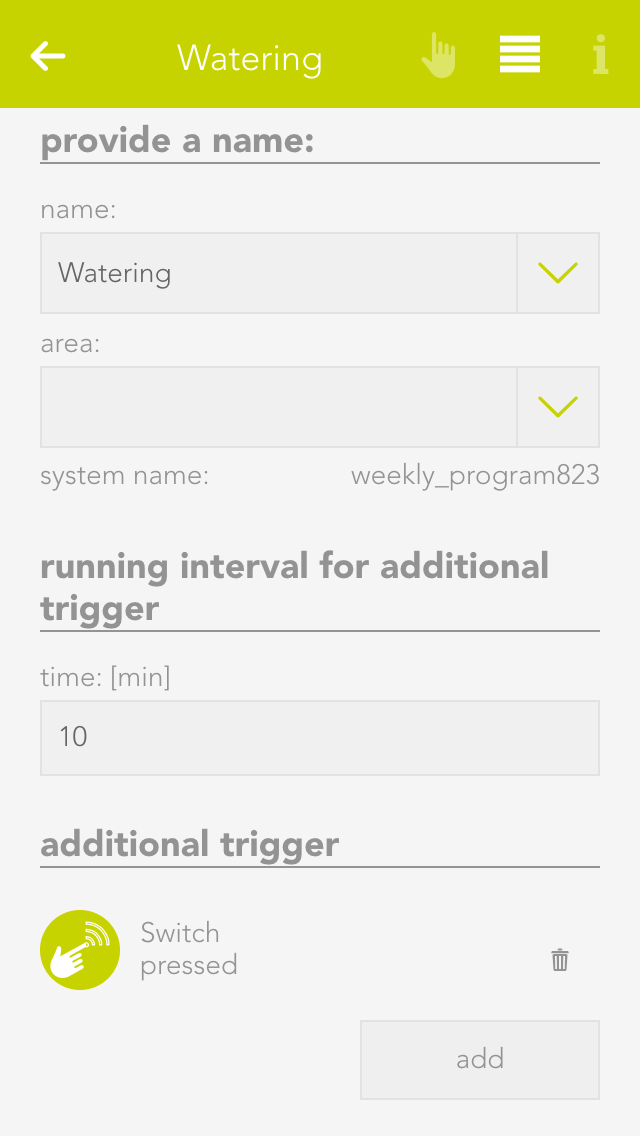
Once you have entered all the times when you want the irrigation system to be active, you can change to the parameter panel. If you wish the irrigation system to be active outside of the defined times, you can select under “additional trigger” the trigger that you want to also activate the irrigation system (e.g. a switch is pressed). In the item “runtime for additional trigger”, you need to define how long the irrigation system should be active if you activate it via a switch.
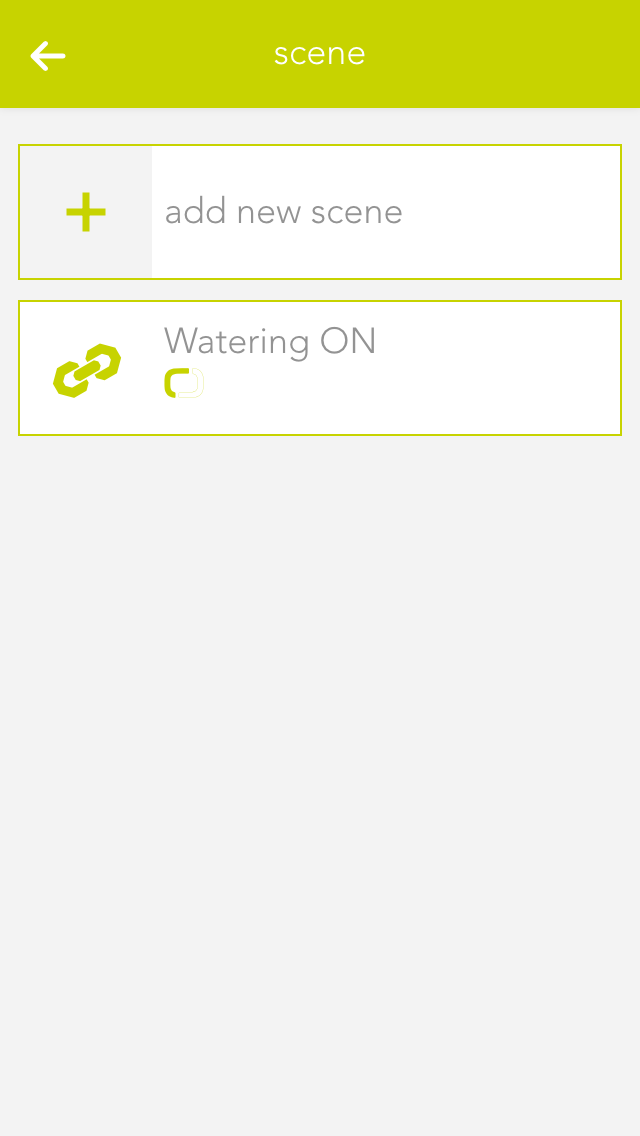
Now all you need to do is link the digital output with the weekly programme. You do this via a scene.
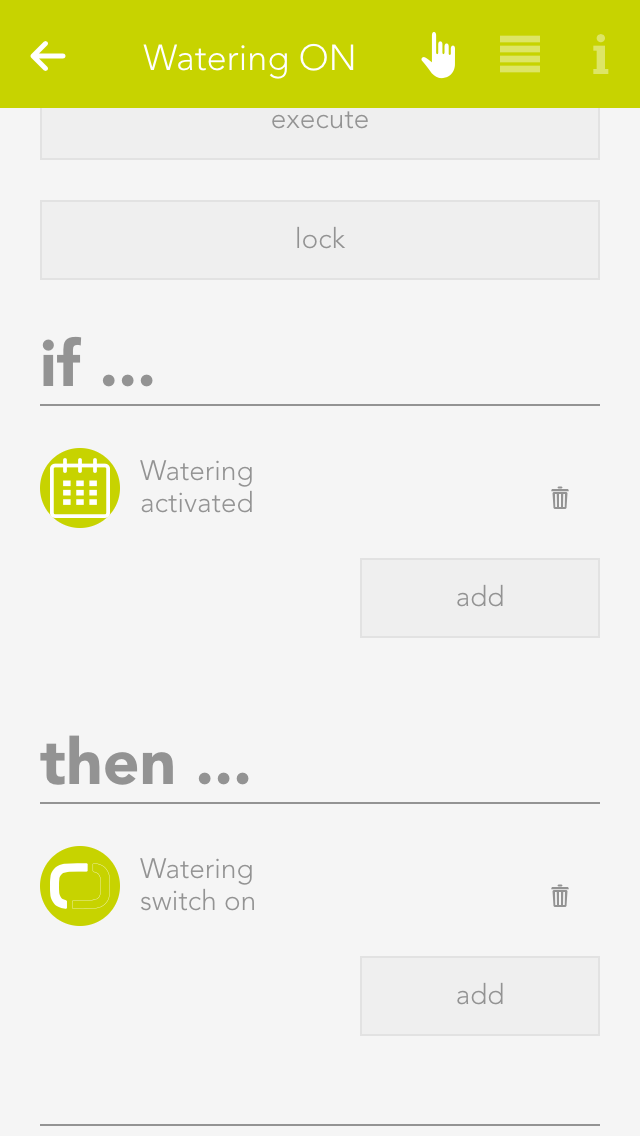
Create a scene, select “add” in the IF section and select your weekly programme, then click on “activate”. Select the digital output under “THEN” and select “ON”. Then create another scene and select the weekly programme for “IF” and select “OFF”
Now your garden irrigation system is ready. Make further adjustments to the weekly programme as required.
Szenen
Erstellte Szenen können Sie auch in andere Szenen im "Dann" Bereich verwenden und diese so z.B. auslösen oder deaktivieren.
Es stehen folgende Funktionen für evon Smart Home Szenen (Dann...) zu Verfügung:
- Aktivieren: Die Szene wird aktiviert (wenn die Szene vorher deaktiviert war)
- Auslösen: Die Szene wird ausgelöst
- Deaktivieren: Die Szene wird deaktiviert und kann damit von keinem Auslöser (Wenn) gestartet werden
Szenengruppen
Über Szenengruppen lassen sich mehrere Szenen gruppieren um die Übersichtlichkeit zu verbessern.

Um eine Szenengruppe zu erstellen klicken Sie auf das Element „Neue Szenengruppe hinzufügen“. Danach öffnet sich ein Panel in dem Sie dieser Gruppe einen Namen (z.B. „Garten“), Farbe und ein Icon zuweist.
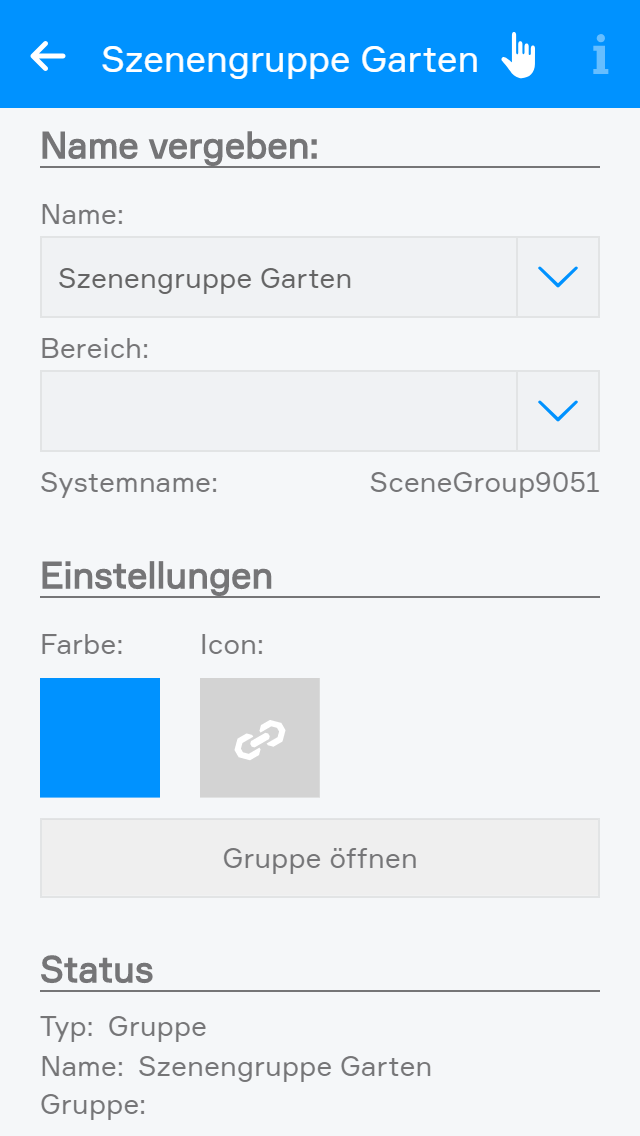
Um eine Szene für diese Gruppe zu erstellen, klicken Sie den Button „Gruppe öffnen“ und wählen dort „Neue Szene erstellen“ aus. Danach öffnet sich das Operatorpanel. Hier geben Sie Name und optional auch einen Raum an.
Auch bestehende Szenen können im Parameterpanel einer Szenengruppe nachträglich zugeordnet werden
Extended Features
If the steps so far are not sufficient, you can adapt your evon Smart Home with further functions.
House Status
The “house status” displays the current status of your house and lets you change it.

The “house status” is located under “all apps” – “house status”.
Create

You can easily add a new status for your evon Smart Home. To add a new house status, click on the element “create status”. The operator panel opens and lets you first allocate a name to your house status. Once named, you can then continue with the configuration (described below).
Each status can be given a name and an icon that is displayed in your evon Smart Home.
Configuration
For each of your created house stati, you can define which button activates it and should happen if the status changes.
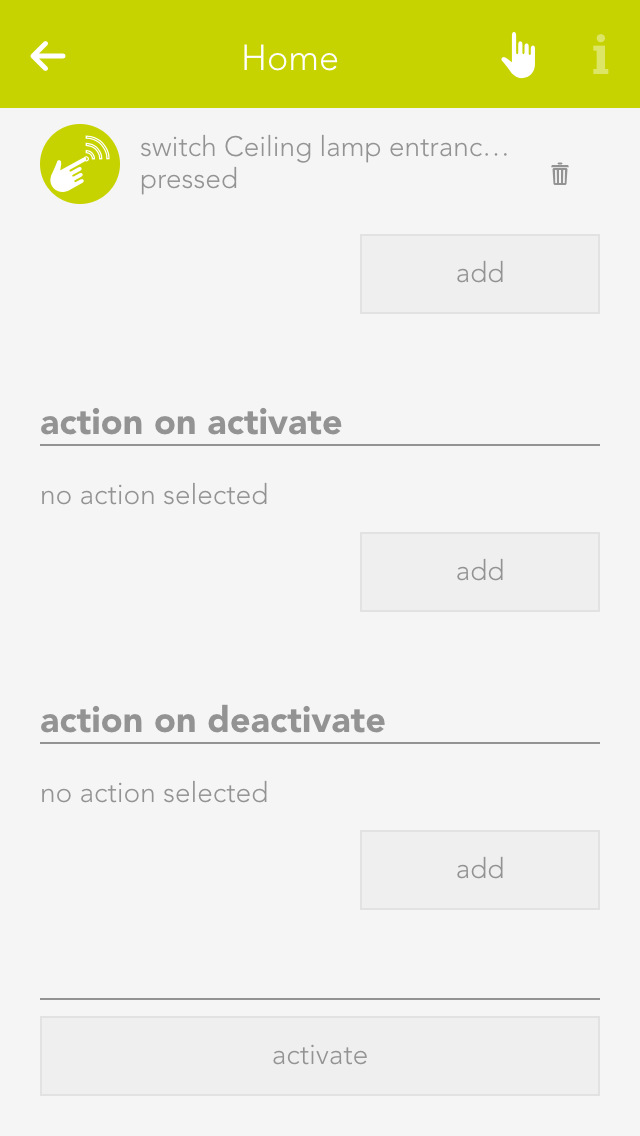
Button to activate this status
Select the button here that allows you to activate the corresponding status
Action when activated
Select here the action that is to be invoked when the corresponding house status is activated.
Action when de-activated
Select here the action that is to be invoked when the corresponding house status is de-activated
Usage
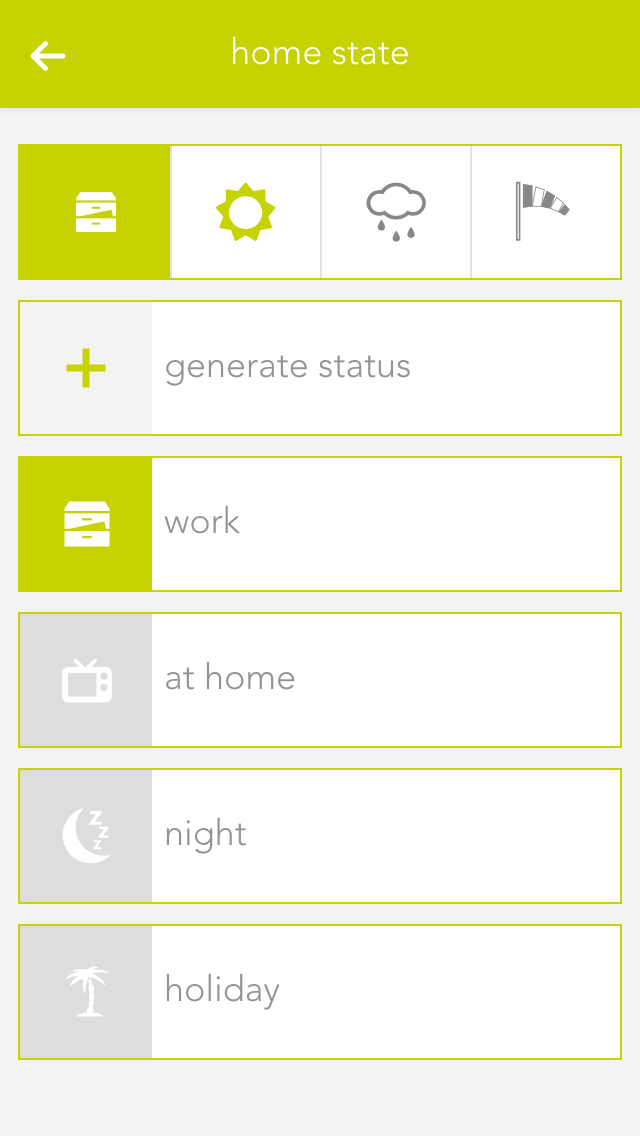
If you want to activate a status via the visualization, you can do this either in the left-hand area of the corresponding object panel or via the operator panel using the button “execute”.
The status that is currently active is displayed both in the object panel and in the house status panel. If you drag the house status to your favourites, then the current active status is displayed there too.
The house status panel not only displays the current status of your house, but also if dawn/dusk, rain or wind are active. You can configure where this information comes from in the “global settings”.
Szenen
Der Hausstatus bietet folgende Auslöser für evon Smart Home Szenen (Wenn...):
- Aktiviert: Der ausgewählte Hausstatus wurde aktiviert
- Deaktiviert: Der ausgewählte Hausstatus wurde deaktiviert
Der Hausstatus bietet folgende Funktionen für evon Smart Home Szenen (Dann...):
- Aktivieren: Der gewählte Hausstatus wird aktiviert
Allergie Assistent
Der Allergie Assistent hilft Ihnen dabei, Ihre nervigen Allergien in den Griff zu bekommen. Anhand Ihrer persönlichen Konfiguration ermittelt der Allergie Assistent die aktuelle Pollenbelastung sowie eine Prognose für die nächsten Tage. Dabei werden Kriterien wie z.B. Ihre Region, Regen und Wind berücksichtigt. Wenn Sie möchten, kann der Allergie Assistent Ihnen über Veränderungen der Belastung, oder geöffnete Fenster bei Pollenbelastung benachrichtigen.

Sie finden Allergy Pro unter "Alle Apps" - "Allergie Assistent"
Konfiguration
Der Allergie Assistent existiert bereits und muss daher nicht mehr erstellt werden. Die Konfiguration können Sie mit wenigen Klicks ganz einfach vornehmen.

Durch Klick auf das ObjectPanel öffnet sich ein Wizard. Mithilfe des Wizards, können Sie den Allergie Assistent ganz einfach konfigurieren.

Nach dem Beginnen der Konfiguration können Sie auswählen, welche Allergien Sie haben. Damit ist der Allergie Assistent auf Ihnen abgestimmt.

Damit Sie nur dann Benachrichtigungen erhalten wenn Sie es auch wollen, können Sie diese im nächsten Schritt konfigurieren.
Zusätzlich können Sie die Region auf Ihren Wohnort einstellen. Dadurch kann der Allergie Assistent Sie noch präziser unterstützen.

Ihre persönliche Konfiguration können Sie ab jetzt im Parameter Panel des Allergie Assistent jederzeit ändern.
Bedienung
Mit dem Allergie Assistent haben Sie die aktuelle Pollenbelastung immer im Blick. Ein Index von 0 bis 3 zeigt Ihnen, wie stark die aktuelle Belastung ist. Ein Index von 0 bedeuted, dass keine Belastung vorliegt, während bei 3 eine maximale Belastung erreicht wurde. Sie können natürrlich die aktuelle Belastung in der Logik vewenden oder mithilfe von Szenen auf Änderungen reagieren.

Die Aktuelle Belastung können Sie beispielsweise rechts im ObjectPanel ablesen.

Im Operator Panel wird Ihnen neben der aktuellen Belastung auch eine Prognose für die nächsten 3 Tage angezeigt.
Jeden Tag haben Sie einmal die Möglichkeit, Ihr aktuelles Empfinden hinsichtlich Ihrer Allergien abzugeben. Dies hilft dabei, den Allergie Assistent zu verbessern und Ihnen in Zukunft noch besser zu unterstützen.
Im unteren Bereich des Operator Panels erhalten Sie hilfreiche Tipps, um Ihnen vor Pollen zu schützen. Durch Klick auf "Nächster Tipp", können Sie weitere Tipps erhalten.

Im Parameter Panel können Sie die Konfiguration jederzeit ändern.
Ganz unten befindet sich ein Button, mit dem Sie den Allergie Assistent wieder komplett zurücksetzen können.
Clock
The clock lets you create an alarm clock, a timer or a weekly programme. The next chapters explain how to use them.

The clock is located under “all apps” – “clock”.

To create an alarm clock, a timer or a weekly programme, simply open the app “clock” and select “add clock”. A window then opens offering you a selection of elements you can create.
Alarm Clock
The app “alarm clock” lets you create an alarm clock that goes off at the time you define and is shut off after a certain time. An alarm clock is intended to be used with a scene to react to the alarm and the end of the alarm.
Using With A Scene

In order to use this alarm with a scene, it must first be named and then you can click on “add” in the scene’s “IF” and select the app “Clock”, unfold the alarm clock and select either “alarm triggered” or “alarm ended”.
Configuration

To define the alarm time, simply click on the currently defined time and select the time you wish for the alarm. You must also activate this alarm via the option “activate”.
The item “repeat” lets you select which on weekdays should the alarm be repeated. If you only want the alarm to go off once, select the option “just once”.

The length of time the alarm is active can be set under “extended” by activating the option “activate extended settings”. You will need the active alarm time if you want the alarm to last for a specific time. For example, if you have activated the alarm for 8pm with an active time of 10 minutes, then the alarm is active from 8 pm till 8:10 pm and then switches itself off. If you haven’t activated this option then the alarm stops directly after the trigger.
Timer
The app “timer” lets you define a countdown that, once the defined time has expired, can invoke a scene. You can also allocate a signal light to this timer that signals when the time has expired.
Operation

To adjust the time, click on the currently defined timer for this timer in the operator panel under “operation” and change it as you require.
The button “start” is used to start the timer and “reset” to reset the start time. The button “pause” stops the timer and you can continue the timer by pressing “start”.
Using With A Scene

In order to be able to use this timer with a scene, it must have a name. Then you can select the trigger “time expired” in the scene under “IF” and the appropriate action to be carried out when the timer has expired. You can also use the timer in the scene for the “THEN”. This lets you start, stop or reset a timer via a scene.
Configuration

Once you have allocated this timer a name and optionally a room, you can begin with the configuration.
You can add as many lights as you want in the item “signal light” using the button “add”. These lights are intended to flash on and off and the number of flashes can be set via the option “number of flashes”. The duration of each flash can be set via the “duration of signal flash”.
Weekly Program
The app “weekly program” lets you define up to 3 time periods per day in which you can execute actions. In order to be able to carry out an action, a scene must react to the activation and de-activation of the weekly program.
Using With A Scene

In order to be able to use this weekly program, you must give it a name. Once done, you can select the triggers “activated” and “de-activated” in the scene’s “IF” statement. For example, if a time from 9 am to 10 am has been defined for each Monday, then “activated” is invoked at 9 am and “de-activated” is invoked at 10 am. Furthermore you can use the weekly program in the scene for “THEN” by selecting “switch on once” (“switch on once” is explained in the chapter “configuration”).
Creating And Editing Entries
To create an entry in the weekly program, click on “+” for the desired day. This opens a window where you can configure the entry. You have the following possibilities:

Day
The weekday for which this entry is to be created.
No end time
If you only want to define a start point then activate this option. If a point has no end time, then the weekly program is activated after the time for the “runtime for additional trigger” has expired (located in the parameter panel).
From
This is the start point for your entry
Until
This is the end point for your entry
To edit an entry, click on the previously created entry (in the operator panel) and then proceed the same as for creating the entry.
Configuration

Runtime for additional trigger
If the weekly program is activated once via the additional trigger, then the weekly program remains active for the defined time. If you have an entry without end point, then the weekly program also remains active for this time after the defined time has expired.
Additional trigger
You can add as many additional triggers as you wish that trigger the weekly program once.
Kalender
Mit der App „Kalender“ können Kalendertage wie Feiertage oder andere Ereignisse verwaltet werden. Kalenderereignisse können dann als Ausnahmebedingungen in Szenen verwendet werden.
Konfiguration

Sie können einen neuen Kalender unter "Alle Apps" - "Zeitprogramme" durch Klick auf "Zeitprogramm hinzufügen" anlegen.
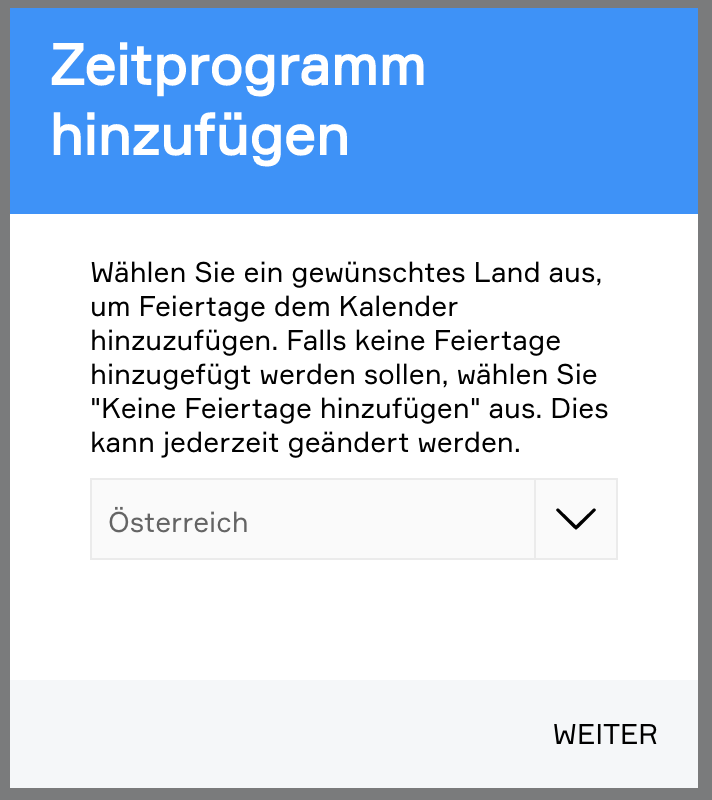
Um länderspezifische Feiertage automatisch dem Kalender hinzuzufügen, muss das Land ausgewählt werden. Wenn keine Feiertage hinzugefügt werden sollen, kann "Keine Feiertage hinzufügen" ausgewählt werden.
Feiertage können später jederzeit neu in den Kalender importiert werden.

Wenn die Wochenendtage Samstag oder Sonntag als Kalenderereignis verwendet werden soll, können Sie dies auswählen.
Achtung: Diese Tage werden aus Gründen der Übersichtlichkeit nicht im Kalender aufgelistet.

Nach erfolgreicher Erstellung eines Kalenders kann dieser im Parameter Panel konfiguriert werden. Dabei kann dieser wie gewohnt benannt und einem Bereich hinzugefügt werden.
Durch Deaktivieren des Kalenders werden alle Kalenderereignisse inaktiv.
Zusätzlich können die Einstellungen wie Land oder Wochenendereignisse geändert werden, sowie Feiertage importiert werden.
Bedienung

Im Object Panel des Kalenders ist ersichtlich, ob dieser aktiviert (blau) oder deaktiviert ist (grau). Aktuelle Kalenderereignisse werden unterhalb des Namen aufgelistet.

Im Operator Panel werden alle Kalenderereignisse dargestellt. Dabei können Sie erkennen, ob es sich um einen Feiertag oder ein selbst hinzugefügtes Ereignis handelt. (Selbst hinzugefügte Ereignisse werden mit einem seitlichen blauen Balken dargestellt). Wiederholende Ereignissen werden mithilfe eines Kreises dargestellt.
Im unteren Bereich können Sie einen neuen Kalendereintrag hinzufügen oder bestehende bearbeiten. Dabei können einzelne Einträge gelöscht oder ignoriert werden.
Szenen
Die konfigurierten Kalender-Ereignisse können als "Bedingungen" bei den evon Smart Home Szenen verwendet werden. Als einfaches Beispiel kann die morgendliche Weckfunktion genannt werden. Die Szenen wird über einen Wecker im "Wenn-Bereich" aktiviert und schaltet im "Dann-Bereich" bestimmte Lichter und Beschattungselmente. Diese Funktion ist jedoch an Feiertagen nicht gewünscht, hierzu kann nun der Kalender als "Bedingung" gesetzt werden.
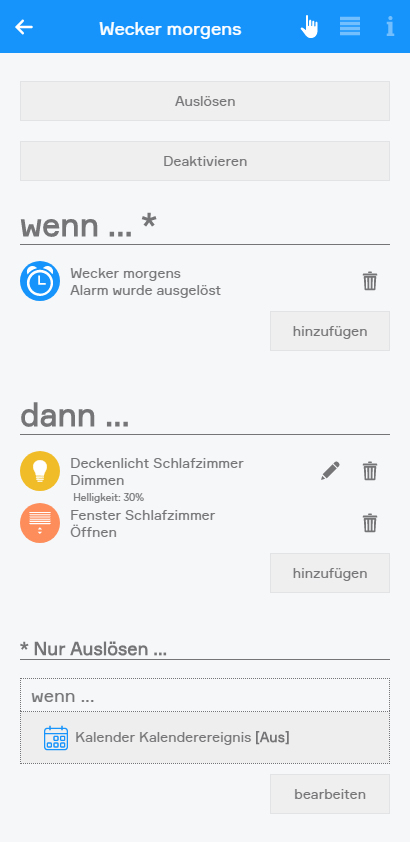
Szenen
Die Zeitprogramme bieten folgende Auslöser für evon Smart Home Szenen (Wenn...):
- (Wecker) Alarm wurde ausgelöst: Der konfigurierte Alarm wurde ausgelöst
- (Wecker) Alarm wurde beendet: Der Alarm wurde beendet
- (Timer) Zeit abgelaufen: Die konfigurierte Timer-Zeit ist abgelaufen
- (Wochenprogramm) Aktiviert: Eine der konfigurierten Zeiten des Wochenprogramms wurde aktiv
- (Wochenprogramm) Deaktiviert: Eine der konfigurierten Zeiten des Wochenprogramms wurde inaktiv
Die Zeitprogramme bieten folgende Funktionen für evon Smart Home Szenen (Dann...):
- (Timer) Neu starten: Der Timer wird zurückgesetzt und neu gestartet
- (Timer) Reset: Der Timer wird zurückgesetzt
- (Timer) Start: Der Timer wird gestartet
- (Timer) Stop: Der Timer wird gestoppt
- (Wochenprogramm) Einmalig einschalten: Einmalig einschalten: Das Wochenprogramm wird einmalig aktiviert
Die Einträge des Jahreskalender können als "Bedingungen" in Szenen verwendet werden. Die Szene soll zum Beispiel nur auslösen, wenn kein Feiertag ist (Bedingung).
Weather Station
The evon Smart Home weather station is a simple way to receive local weather data and use it in your evon Smart Home.

The app “weather station” is located under “all apps” – “weather station”.
In order to use this weather station, open the global settings (“all apps” –“settings” – “global settings”) and drag the weather station to the first position for wind, rain, outside temperature and daylight (it is also possible to only use the weather station for wind).
Create
To use the evon Smart Home weather station, follow the following steps:

Mounting
Mount the weather station following the documentation (follow the instructions concerning the direction and distances carefully)
Connecting
Connect the evon Smart Home weather station 2-wire bus cable to the evon Smart Home CPU iX800 – ensure the polarity is correct (A-B) (recommended cable J-Y(ST)Y 2 x 2 x 0,8).
Power supply
Supply the evon Smart Home weather station with power (see documentation).
Add
Add a new weather station. If you have done everything correctly, a connection is established and your weather data are updated every second.
Note: Only one weather station can be operated by the CPU iX800.
Configuration
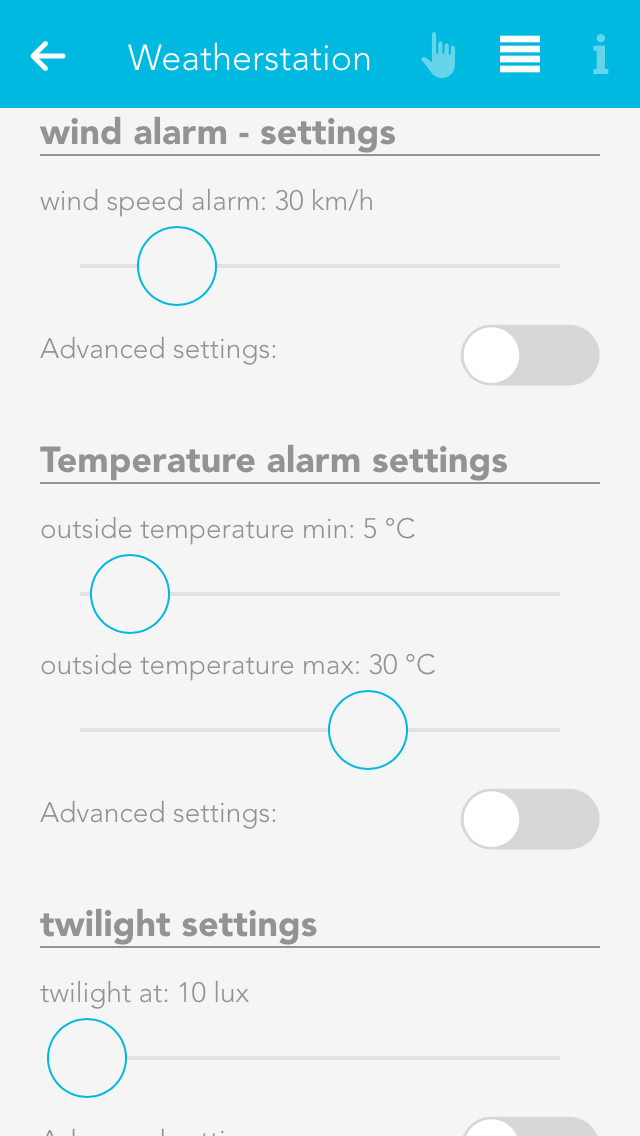
Wind alarm settings
The wind alarm settings let you define a wind speed above which an alarm is triggered. You can also define hysteresis so that the wind alarm does not trigger and end continuously should the wind speed oscillate around the alarm value. If you want that the wind alarm is active only after a certain time, then you need to enter a delay. This means that this time must be longer than the time set for “wind speed alarm”, so that a wind alarm is triggered.
Dawn/dusk settings
These settings let you define the light levels when dusk/dawn is active and inactive. Hysteresis and delay have the same functions as described previously.
Operation
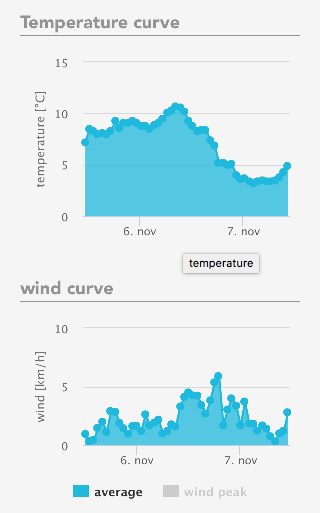
In the Operatorpanel of the Weather Station, you will find several statistics and charts, which provide you with an insight on the measured values.
Szenen
Die Wetterstation bietet folgende Auslöser für evon Smart Home Szenen (Wenn...):
- Aufgehört zu regnen: Das Ende des Niederschlags wurde erkannt
- Außentemperatur Max-Limit überschritten: Das konfigurierte Max-Limit der Außentemperatur wurde überschritten
- Außentemperatur Min-Limit unterschritten: Das konfigurierte Min-Limit der Außentemperatur wurde unterschritten
- Regen (Niederschlag) erkannt: Der Beginn des Niederschlags wurde erkannt
- Sonnenaufgang: Der Sonnenaufgang wurde erkannt
- Sonneneinstrahlung-Ost Max-Limit überschritten: Das konfigurierte Sonnenstrahlung Max-Limit im Osten wurde überschritten
- Sonneneinstrahlung-Ost Min-Limit unterschritten: Das konfigurierte Sonnenstrahlung Min-Limit im Osten wurde unterschritten
- Sonneneinstrahlung-Süd Max-Limit überschritten: Das konfigurierte Sonnenstrahlung Max-Limit im Süden wurde überschritten
- Sonneneinstrahlung-Süd Min-Limit unterschritten: Das konfigurierte Sonnenstrahlung Min-Limit im Süden wurde unterschritten
- Sonneneinstrahlung-West Max-Limit überschritten: Das konfigurierte Sonnenstrahlung Max-Limit im Westen wurde überschritten
- Sonneneinstrahlung-West Min-Limit unterschritten: Das konfigurierte Sonnenstrahlung Min-Limit im Westen wurde unterschritten
- Sonnenuntergang: Der Sonnenuntergang wurde erkannt
- Sturm erkannt: Das konfigurierte Wind-Limit wurde überschritten
- Sturm vorbei: Das konfigurierte Wind-Limit wurde unterschritten
- Windalarm Grenze 1 überschritten: Das konfigurierte Wind-Limit für Grenze 1 wurde überschritten
- Windalarm Grenze 1 unterschritten: Das konfigurierte Wind-Limit für Grenze 1 wurde unterschritten
- Windalarm Grenze 2 überschritten: Das konfigurierte Wind-Limit für Grenze 2 wurde überschritten
- Windalarm Grenze 2 unterschritten: Das konfigurierte Wind-Limit für Grenze 2 wurde unterschritten
Shading Control
shading control let automatically control your blinds based on the sun. Now you have always enough brightness, without dazzling yourself. You can decide on yourself, how much light you want.
In summer, your blinds can close automatically at high outside temperatures while you can use the energy of the sun in winter. Of course you have the possibility to control your blinds via app or switch as usual.

You can find shading control under „settings“ - „shadingcontrol“.
Create
To use the shading control, you have to add facades. A facade is an own control unit with controls its assigned blinds by cardinal directions.

You can add as many facades as you want under „settings“ - „shading control“. Preferably you add as many facades as outside walls you have. Usually there are 4 facades, which are configured with north, east, south, west or if the building is arranged diagonally the sun with northeast, southeast, southwest, northwest.

In the parameter panel of the facade, the direction can be set. Choose the best fitting of the 8 available directions. Assign your facade a name to order it easier later.
In addition to the direction you can choose a type. You can always add only blinds of the same type.
Configuration
To control your blinds automatically you have to assign them to a facade. you can do that in the parameter panel of an existing facade under „elements“.
ATTENTION! Blinds should not be assigned to several facades. Take care of blind groups too.

If you also want to use the shading control to use heat of the sun, you can add the inside temperature under „thermostats“. You can also leave this area empty, if you do not want to enable heat using.

On the bottom of the parameter panel you can see a table with control positions. This table is the base of the shading control. You can set blind positions to a specific sun height and also the angle at jalousies.
With the „submit“ button you can accept the set values to the facade. You can also set the values to all facades or reset it to default values.

On the bottom of the parameter panel you can set additional parameter. The minimal brightness must be above to control the blinds by the table. Among this value the blinds keeps open.
If the heat protection is active, all blinds will close completely, if the outside temperature is above the setting.
On using a thermostat and heat using is active, all blinds will open completely, if the outside temperature and inside temperature is among the setting.
Control
The shading control helps you to reduce manual interactions with blinds. After the configuration of the shading control no more manual control is needed anymore. Anyhow you have always the possibility to deactivate or activate the control or to monitor it.

The static panel of the shading control provides summary information of the control. Values like sun height and lighted facades are listed.
Beside this, you can disable or enable the whole control with one click. The function „reactivate automatically“ activates facades at a specific time, if they were deactivate by manual interaction for example. If you want to exclude a facade from this function, you can do this with „lock facade“ in the parameter panel of a facade.

The Object Panel shows the configured direction. The icon is colored orange, if the facade is lighted by the sun. On the right side the current blind state is shown. If the facade is disabled, the whole panel is greyed out.

The operator panel of a facade provides its main information. Sun height, light state and outside brightness from your weather station are some of listet values.
Assigned blinds are listet too.
On the bottom side of the operator panel the control table is listet. The line with the current sun height is marked. If the facade is active, lighted and the min brightness is reached, the marker gets orange and the position of this line will be controlled . If heat using or heat protection is active, they have priority.
Scenes
Shading control provides following functions for evon Smart Home scenes (then..):
- Activate all: All facades will be activated, except locked ones.
- Activate facade: Facade will be activated, except it is locked.
- Deactivate facade: Facade will be deactiavted.
Door
The app “door” lets you create a door for your evon Smart Home. You can link a camera, a bellring button, a bellring and a door opener contact to such a door.

The app “door” is located under “all apps” – “door”.
Configuration

Intercom
Choose a connected intercom. "Camera" and "Bellpush" will automatically be assigned.
Camera
This field lets you select a camera for this door. The camera image is then always displayed on the operator panel.
Bellpush
Use the button “add” to add one or more buttons you wish to use to ring the doorbell.
Doorbell
Select the digital output that is connected with the doorbell.
Door opener
Select the digital output connected to the door opener using the button “add”.
Signal light
If you in a room where it is not possible to hear the doorbell, you can select a light in this room that will flash when someone rings the doorbell

Number of flashes
Define the number of times the signal light is to flash when someone rings the doorbell.
Signal light on time
Defines how long the signal flash is to be.
Door open time
Defines how long the door remains open, if you open it via the app.
Doorbell time
Defines how long the digital output for the doorbell is to remain active.
Melody
If you want a melody to play on your smartphone, or tablet etc. when someone rings the doorbell, then you can choose here between two melodies.
Simulate
You can simulate the doorbell button press using the button “ring” to test whether you have satisfactorily configured all options according to your requirements. This has the same effect as if someone had really pressed the doorbell.
If you want to be able to use the built in microphone and speaker of your intercom to talk to visitors, we recommended to download and use the following apps:
iOS - https://itunes.apple.com/at/app/mobotix/id527836206?mt=8
Android - https://play.google.com/store/apps/details?id=org.abionix.axviewer&hl=de
Operation
If you open the operator panel for your door, then you can see the camera image (if a camera is linked to this door) and a button “open door” that lets you open this door (if a door open contact has been selected).
As soon as someone rings the bell for this door, you will receive a notification and a photo is taken of the moment the bell was rung that you can see when you open the notification.
Szenen
Die Tür bietet folgende Auslöser für evon Smart Home Szenen (Wenn...):
- Klingel läutet: Die Klingeltaste wurde betätigt
- Tür wird geöffnet: Der elektrische Kontakte zum Türöffnen (z.B.: Motorschloss) wurde betätigt
Die Tür bietet folgende Funktionen für evon Smart Home Szenen (Dann...):
- Aktuelles Kamerabild speichern: Das aktuelle Kamerabild der zugewiesenen Kamera wird gespeichert
- Öffnen: Der elektrische Kontakte zum Türöffnen (z.B.: Motorschloss) wird aktiviert
- Türklingel aktivieren: Die Türklingel wird aktiviert (wenn diese vorher deaktiviert war)
- Türklingel auslösen: Die konfigurierte Türklingel wird ausgelöst
- Türklingel deaktivieren: ** Die Türklingel wird deaktiviert
Window
The app “windows” lets you operate and configure all windows in your system. You also have pre-defined central functions such as “open all windows” and “close all windows”.
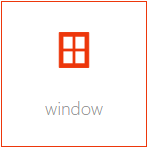
The windows app is located under “all apps”.
Window Settings
You can configure general settings for all windows in the window settings area located under “all apps” – “settings”.

Notifications of open windows and rain/wind
If you wish to receive a notification if a window is open and it is raining or is windy, then you must activate this option.
The item “open windows” shows you a list of all open windows. The button “update” reloads the list of all open windows.
Szenen
Das Fenster bietet folgende Funktionen für evon Smart Home Szenen (Dann...):
- Auf Position fahren: Das Fenster wird auf eine frei wählbare Position gestellt
- Öffnen: Das Fenster wird vollständig geöffnet
- Schließen: Das Fenster wird vollständig geschlossen
- Stoppen: Die aktuelle Fahrbewegung des Fensters wird gestoppt
Types Of Window
You have the possibility of integrating two types of window into your system, by window contacts or electric windows.
If you have simply just one window contact connected to a digital input, then you must create a “window contact”. However, if you have an electric window that you wish to integrate into your system, then you must create an “electric window”. Electrical windows are connected to blind modules, since they work according to the same principle.
Window Contact
Create

To create a window contact, open the window app under “all apps” and select “create window contact”. This opens the operator panel and the newly created window contact. It is important to first give the contact a name and optionally the location of the window.
Configuration
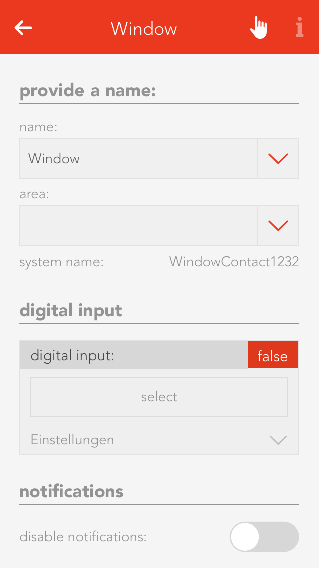
Select the digital input the window contact is connected to in the item “digital input”.
The object panel for this window contact will display whether this window is open or closed. If “open” and “closed” are reversed, i.e. the object panel shows a window to be open although it is actually closed, then activate the option “invert” in the operator panel.
You can de-activate notifications for wind and rain in the tem “notifications”.
Using With A Scene

A scene lets you react to the opening and closing of a window by selecting the triggers “has been opened” or “has been closed” in the “IF…” statement and then selecting what should happen in the “THEN ..” statement.
Electric Window
Create
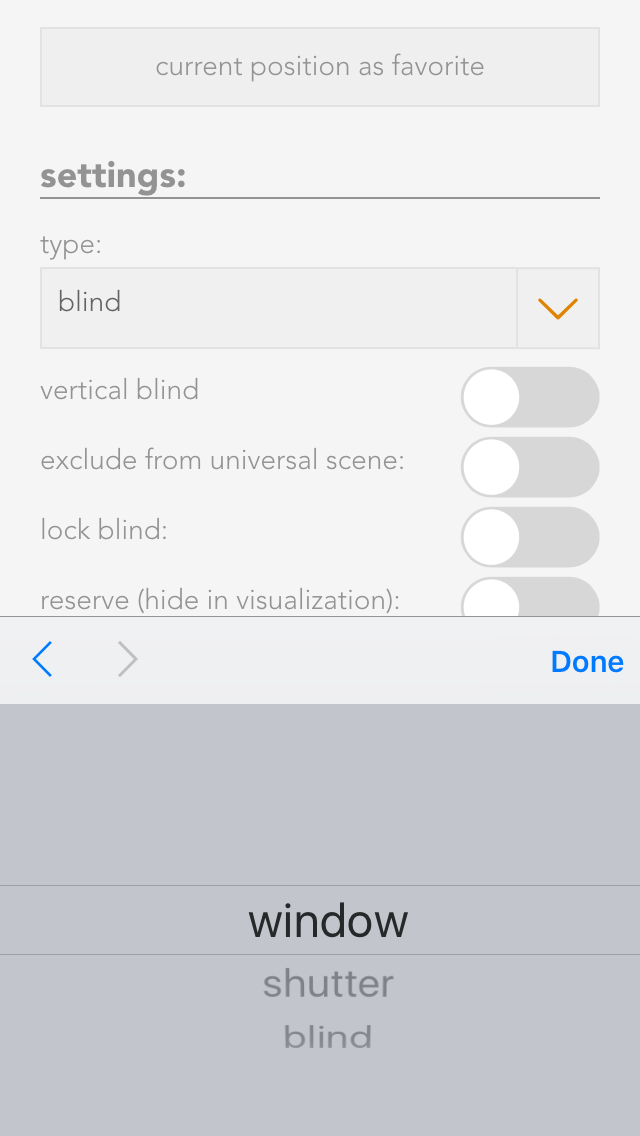
To create an electric window, open the app “shading” and select the blind the window is connected to. Navigate to the parameter panel and select the “type” “window”.
Operation
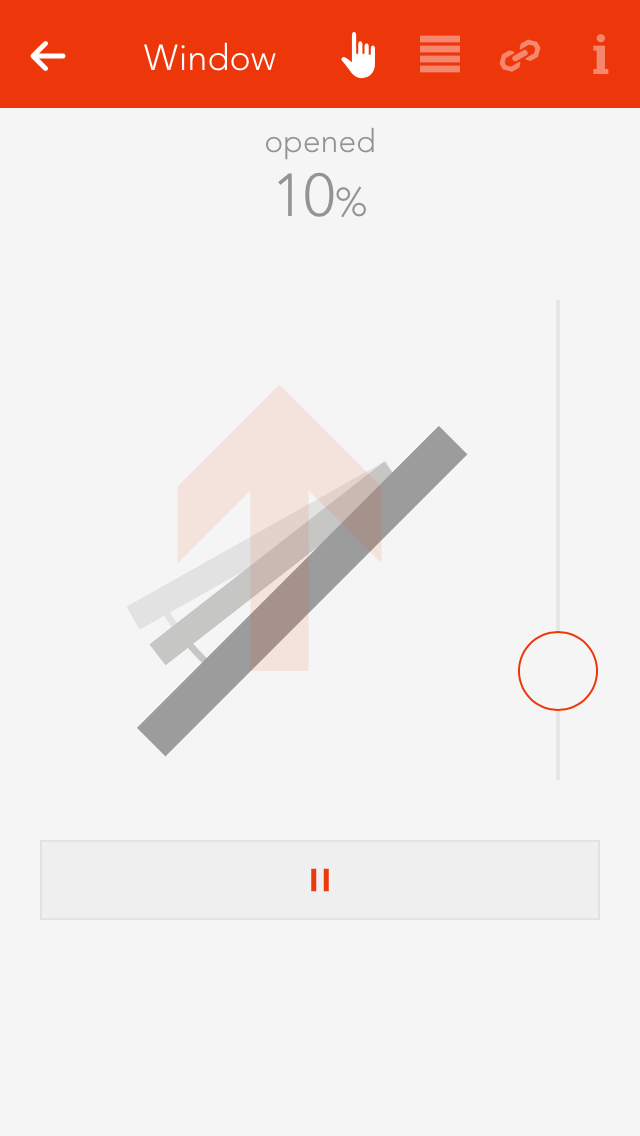
You can operate an electric window either via the object panel using the arrows on the left-hand side or via the operator panel using the buttons and the slider.
Adjust Opening Times

If you know exactly how long your window takes to open and close, then enter the times directly into the fields “closing time” and “opening time”, then click on the button “use values and run reference”.
If you do not know the times, simply use the wizard to determine the opening and closing times. Follow the wizard’s instructions and the times will be automatically entered and a reference activity carried out.
Configuration

Type
If you want to convert this electric window back into a blind, then you can easily do this by selecting the type “blind”.
Except from universal scene
A universal scene “open all windows”, for example, would open all windows. However, if you wish a window to be excepted from this universal scene, then activate this option.
Lock window
This option lets you lock a window, i.e. the position cannot be changed, neither via the visualization nor via a button.
Deactivate notifications
If you do not wish to receive notifications for this window, then activate this option.
Reserve (hide in visualization)
“Reserve” lets you hide unused channels. You can unhide them via the app “hardware” and the corresponding module.
Couple With

If you want two windows to always have the same position, this can be done by coupling them. Simply select the button “select” in the item “couple with” and choose the window you wish to couple this window with.
Using With A Scene

A scene lets you react to the opening and closing of a window in that you select “has been opened” or “has been closed” in the “IF” statement and then select what should happen as a consequence in the “THEN …” statement.
You can also select the actions “go to position” (go to a window position you have defined), “open” and “close” in the “THEN” statement of a scene.
Alarm System
The app “alarm system” lets you create a personal alarm system for your evon Smart Home. The alarm system is divided into a central alarm system and one or more alarm groups. Alarm groups divide the alarm system into several areas.

The app “alarm system” is located under “all apps” – “alarm system”.
Configuration
Duration of silent alarm
Enter the time for silent alarm here.
Automatically deactivate alarm after
Automatically deactivates the alarm after expiration of this time. This is important if you are holiday and something triggers the alarm. If this option was not available, the alarm would never switch off and your neighbours would not be too pleased with you.
Duration of patrol
This is the time the alarm should be deactivated for while you make a patrol.
Button to activate the alarm system
Select a button to activate the alarm system.
Button to deactivate the alarm system
Use the button “add” to select a button to deactivate the alarm system. Warning! This button can deactivate the alarm system without a password. Consider the use of such a button carefully.
Button to start patrol
Select a button to let you start a patrol.
Button to end patrol
Select a button to tell the system you have completed your patrol.
Status light
Select a light that will flash twice when the alarm system has been activated and once when deactivated.
Actions when alarm triggers
Use the button “add” to select all the actions you wish to happen when an alarm is triggered (e.g. switch lights on, activate siren, etc.).
Actions when alarm stops
Select what should happen when the alarm is deactivated. Caution! Do not forget to deactivate the actions started when the alarm was triggered.
Change password
Change the password to deactivate your alarm system.
Operate
The initial password for the Alarm System is set to "1234".
It is highly recommended to change it on initial setup. You can find the related options in the SettingsPanel (See section configuration).
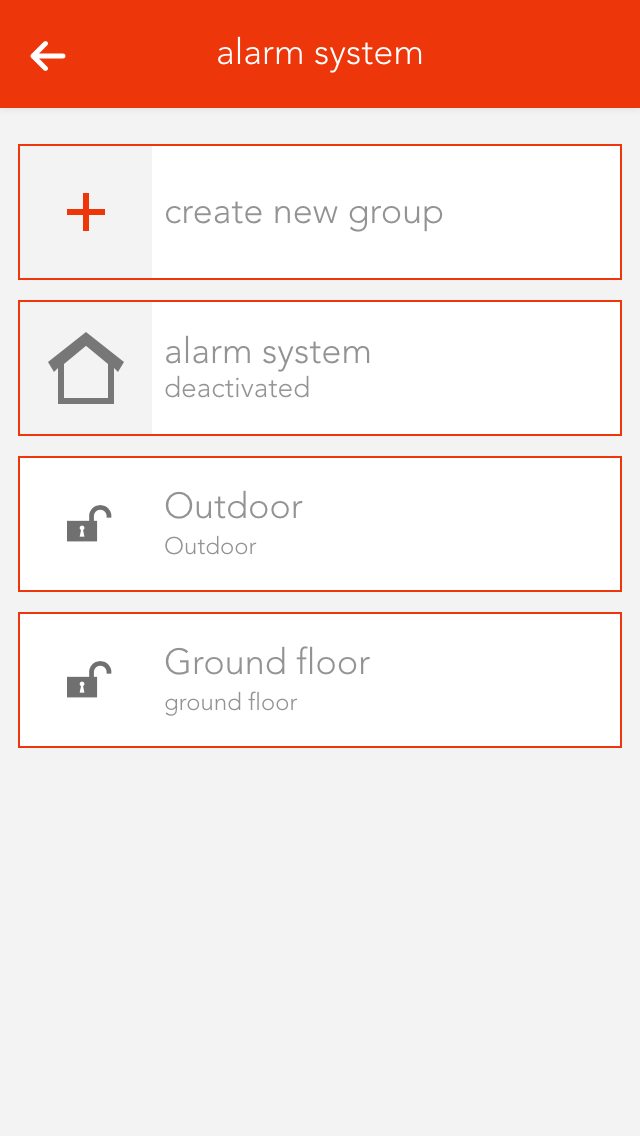
If the alarm system or one or more alarm groups have been activated, the defined activation delay for each alarm group must first expire before the alarm can be triggered. Once the activation delay has expired, if a movement detector is triggered then a trigger delay is activated. During this time, the alarm system can be de-activated without an alarm being triggered. Once the trigger delay has expired, the silent alarm is triggered and a notification is sent. Once the silent alarm time has expired, the actual alarm is triggered and a further notification is sent and the outputs linked to the alarm system are switched.
Activation time is necessary for the following situation: you want to leave the house and activate the alarm before you go. To make sure that you do not inadvertently trigger the alarm yourself, you need the activation delay.
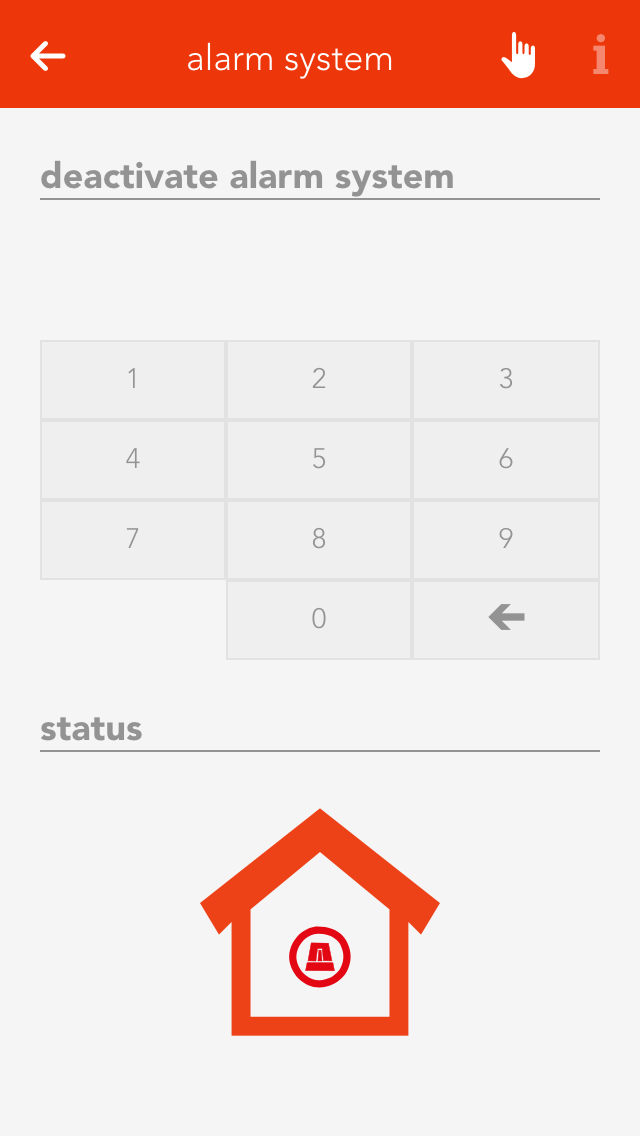
If you want to activate the alarm system, you can either do this via the app by opening the alarm system (“all apps” –“alarm system”) and select the button “activate” in the operator panel for the alarm system, or you define a button to activate the alarm and you use this button (how you do this is described in the chapter configuration). Deactivating the alarm is done the same way via the app, only that you have to enter a password. Deactivation via a button works identically to activation.
You can also find a history of past events in the OperatorPanel of the alarm system which gives you detailed records about the dates and times when it got triggered, activated or deactivated.
Warning, since the alarm system can be deactivated without a password using a button, you need to select a button that is not immediately visible!
Szenen
Die Alarmanlage bietet folgende Auslöser für evon Smart Home Szenen (Wenn...):
- Alarm wurde ausgelöst: Der Alarm wurde durch einen konfigurierten Auslöser aktiviert
- Alarm wurde gestoppt: Der Alarm wurde gestoppt
- Alarm wurde still ausgelöst: Der stille Alarm wurde ausgelöst
- Alarmanlage ist aktiviert: Die Alarmanlage wurde aktiviert
- Alarmanlage wurde deaktiviert: Die Alarmanlage wurde deaktiviert
Die Alarmanlage bietet folgende Funktionen für evon Smart Home Szenen (Dann...):
- Aktivieren: Die Alarmanlage wird aktiviert (Achtung: die Alarmgruppe muss zusätzlich aktiviert werden).
- Deaktivieren: Die Alarmanlage wird deaktiviert (Die Alarmgruppe bleibt aktiviert)
- Kontrollgang beenden: Die Funktion "Kontrollgang" wird beendet, die Alarmanlage wird wieder scharf geschaltet.
- Kontrollgang starten: Die Funktion "Kontrollgang" wird für die eingestellte Dauer aktiviert.
- Alarmgruppe aktivieren: Die ausgewählte Gruppe wird scharf geschaltet.
- Alarmgruppe deaktivieren: Die ausgewählte Gruppe wird unscharf geschaltet.
Alarm Group

An "Alarm Group" represents a section of your alarm system which you want to secure. You can create an unlimited number of groups and use them to arrange your house into various segments. This makes it possible to create different settings for each group and only activate the ones you need.
You can, for example, create a new alarm group for each floor and by using a scene, only secure the ones which are not occupied at the moment.
Operation

The OperatorPanel shows you the current state of the group. If the lock is closed, the group is currently active and will be taken into account when you activate the alarm system.
To change the state of the group, you can click on the small lock in the ObjectPanel of the group or use the button in the OperatorPanel.
Be aware that once the alarm system is activated, you can not change the state of each alarm group. If you want to activate or deactivate a group, you will have to deactivate the alarm system first.
Configuration

Activation delay
If the alarm system and this group have been activated, then the alarm in this group can only be triggered after this time has expired. (Important if you wish to leave the house without triggering an alarm yourself).
Trigger delay
The silent alarm is triggered after this time has expired.
Trigger if
Select all the triggers that you wish to be able to set off this alarm.

camera
Select one or more cameras which will capture up to 6 images if the alarm goes off. You can change the interval for the captured images by using the provided slider. For example: If you set the interval to 2 seconds, each camera will try to capture an image every 2 seconds until 6 images are recorded. You can view the captured images in the "pictures" section below this setting.
Test alarm
The button “test alarm” lets you trigger an alarm in this group. The group and the central alarm system are activated, the panel is closed and an alarm is triggered. Use this to test your alarm system.
Bathroom Heating
“Bathroom heating” lets you configure suitable heating systems and control their times.
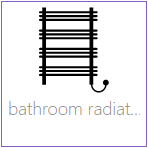
These functions are located under “all apps” – “bathroom heating”.
Operation

To add a new bathroom heater, click on the element “add”. First allocate a name to your bathroom heater in the parameter panel, then you can continue with the configuration (described below).
Szenen
Der Badheizkörper bietet folgende Auslöser für evon Smart Home Szenen (Wenn...):
- Wurde Ausgeschaltet: Der Badheizkörper wurde ausgeschaltet
- Wurde Eingeschaltet: Der Badheizkörper wurde eingeschaltet
Der Badheizkörper bietet folgende Funktionen für evon Smart Home Szenen (Dann...):
- Einmalig einschalten: Der Badheizköper wird für die Zeit des zusätzlichen Auslösers eingeschaltet
Configuration
You can determine what time each of your bathroom heaters should be on. You do this by defining the operating times in the operator panel. You can define one or more time intervals where your heater should heat for each weekday.
Apart from the operating times, you can also define a button to activate each bathroom heater, where it is connected and whether it should be switched into maintenance mode.

Additional trigger
Select the trigger and the duration for which the bathroom heater should additionally be activated for a short period of time.
Select socket
This lets you define which socket your bathroom heater is connected to.
Maintenance mode
This lets you permanently switch the maintenance mode for the bathroom heater on or off.
Circulation Pump
“Circulation pump” lets you configure and control the times for suitable pump systems.

These functions are located under “all apps” – “circulation pump”.
Configuration
You can define the operation times for each one of your circulation pumps. This is done by defining the operating times in the operator panel. You can define one or more time intervals for each weekday when you wish the circulation pump to be in operation.
In addition to the operating times, you can also define intervals within the operating times, which trigger activates them, where they are connected and whether they should be put into maintenance mode.

Active interval during operating time
Define the intervals within the operating time you wish to circulation pump to be active.
Additional trigger
Select the trigger and the duration for which the circulation pump should be additional active for a short period of time.
Select socket
Define which socket the circulation pump is connected to.
Maintenance
Switch the circulation pump permanently on or off for maintenance purposes.
Operation

To add a new circulation pump, click on the element “add circulation pump”. The next step is to allocate a name for your circulation pump in the parameter panel. Then you can continue with the configuration (described below).
Szenen
Die Zierkulationspumpe bietet folgende Auslöser für evon Smart Home Szenen (Wenn...):
- Ausgeschaltet: Die Zirkulationspumpe wurde ausgeschaltet
- Eingeschaltet: Die Zirkulationspumpe wurde eingeschaltet
Die Zierkulationspumpe bietet folgende Funktionen für evon Smart Home Szenen (Dann...):
- Einmalig einschalten: Die Zirkulationspumpe wird zusätzlich einmalig eingeschaltet
my-PV
Die my-PV Geräte AC-ELWA und AC-THOR ermöglichen Ihnen mit evon Smart Home Ihre überschüssig erzeugte Energie (z.B.: aus einem Photovoltaik-System) für die Warmwassererzeugung zu nutzen. In wenigen Schritten können Sie nun Ihr Geräte zum Betrieb mit evon Smart Home konfigurieren.

Sie finden myPV unter "Alle Apps" - "My Pv"
Erstellen
Um Ihre myPV Geräte zu integrieren, müssen Sie diese vorbereiten. Dazu sollten Sie die IP Adresse Ihres Gerätes kennen.
Das Gerät muss sich im Modus "Modbus TCP" befinden. Wie Sie diesen Modus aktivieren, können Sie in der Anleitung Ihres Gerätes nachlesen.
Zudem sollte die IP-Adresse des Gerätes auf eine freie statische IP-Adresse gesetzt werden.

Nach der Inbetriebnahme können Sie durch Klick auf "Gerät hinzufügen" Ihr Gerät integrieren.

Durch Klick auf „Weiter“ werden die nächsten Schritte der Integration geladen. Es besteht jederzeit die Möglichkeit mittels „Abbrechen“ die Integration abzubrechen.

Im ersten Schritt ist es notwendig, das my-PV Gerät so zu konfigurieren, dass es für eine evon Smart Home Integration bereit ist (siehe Punkt 1).

Im nächsten Schritt ist die Eingabe der Geräte IP-Adresse erforderlich.

Im Regelfall wird der Typ des Gerätes automatisch erkannt und der Schritt 3 übersprungen. Sollte dies jedoch nicht der Fall sein, muss der Typ manuell ausgewählt werden.

In Schritt 4 muss der Name und die Örtlichkeit vergeben werden. Dieser kann jederzeit verändert werden.

Als nächstes muss die Quelle der externen Leistungsvorgabe ausgewählt werden. Dies gibt die Soll-Heizleistung des my-PV Gerätes vor. Im abgebildeten Beispiel wird der vom des Smart Meter gemessene Leistungsüberschuss, der in das Stromnetz eingespeist wird, verwendet.

Abschließend kann die Leistungsvorgabe konfiguriert werden. Dies ist insbesondere dann interessant, wenn mehrere my-PV Geräte verwendet werden.

Im letzten Schritt wird bestätigt, dass das Gerät erfolgreich integriert wurde.

Ist die Konfiguration abgeschlossen, erscheint das neue Gerät in der Übersicht von evon Smart Home.
Im Object Panel des Gerätes wird die aktuell gemessene Temperatur sowie die aktuell verwendete Leistung angezeigt.
Ein rotes "X" signalisiert ein Verbindungsverlust zum Gerät. In diesem Fall sollte die Netzwerkverbindung überprüft werden.
Konfiguration

Das Parameterpanel erlaubt Ihnen jederzeit die Konfiguration zu prüfen und zu adaptieren.
Hier kann die Leistungsvorgabe geändert werden oder deren Parameter eingestellt werden.
Bei my-PV Geräten ohne Drehknopf zur Einstellung der Abschalttemperatur kann diese im Parameter Panel eingestellt werden.
Bedienung

Am Operatorpanel werden Ihnen der aktuelle Status und die wichtigsten Informationen des Gerätes dargestellt.
Durch aktivierung von "Manuelle Steuerung" wird die externe Leistungsvorgabe gesperrt. Die Leistung kann dann mithilfe des erscheinenden Sliders festgelegt werden.
Ist im my-PV Gerät der Sicherstellungsmodus aktiviert, wird ein Button "Sicherstellung einmalig starten" sichtbar. Durch Klick auf diesen Button wird die Sicherstellung am Gerät gestartet und bleibt bis zur Erreichung der Zieltemperatur aktiv.
Verwendung der Leistungsvorgabe:
Der Wert der externen Leistungsvorgabe wird aus technischen Gründen geglättet. Die Glättung erfolgt über ein gleitendes Durchschnittsverfahren welches die Leistungsvorgabe über 120 Werte der letzten Minute berücksichtigt.
Die aktuell geglättete Leistungsvorgabe wird anschließend überprüft und begrenzt. Dabei muss dieser Wert größer als die eingestellte "Mindestleistung" sein und wird auf die "Maximalleistung" begrenzt. Der daraus resultiere Wert wird mit dem Faktor "Verwendeter Anteil" multipliziert. Die errechnete Leistung wird anschließend dem my-PV Gerät zur Wärmegewinnung übergeben.
Mixer Circuit Control
The “mixer circuit control” app is an external temperature heating control loop. The “mixer circuit control” is used to configure and control 3-way heating mixer valves.

These functions are located under “all apps” – “mixer circuit control”.
Operation

Click on the element “add mixer control” to create a new mixer circuit controller. The next step is to give your mixer circuit control a name, and then you can continue with the configuration.
The operator panel displays a schematic of the control. This diagram shows you whether the pump is on (screw in the pump is green and rotates) or off. Displayed adjacently is the current temperature of the feed line and to the right the current position of the mixer valve and whether it is open or closed.
All relevant values pertaining to your mixer circuit control are displayed below this.
If your mixer valve is unreferenced, i.e. the current position of the valve is unknown, then the button “execute reference” is displayed. Clicking on it closes the valve completely; hence the current position is known. The mixer circuit control must be fully configured before a reference can be executed.
Heating Curve

The heating curve allows you to adjust the desired temperature of the feed line as a function of the outside temperature.
There are pre-defined curves you can select from using “select curve type”. If there is no pre-defined curve that entirely suits your needs, then you can edit the pre-defined curves by clicking on “edit”. The selection then jumps to “user-defined”. If you wish to save your curve, click on “save”. Saved curves can be deleted using “delete”. When selecting points, you are limited on the one hand by the minimum and maximum feed line temperature, and on the other by the previous and subsequent point. For example, the point at 10 °C outside temperature cannot have a lower feed line temperature than the point at 15°C and a higher temperature than the point at 5°C.
If the outside temperature reaches a value outside of the curve, then the curve is continued horizontally. This means if the curve were to end on the left-hand side at an outside temperature of +20°C with a corresponding feed line temperature of +22°C, then the feed line temperature for outside temperatures higher than +20°C will remain +22°C.
To be able to process outside temperatures higher than +20°C, the cooling operation must be activated under “all apps” – “settings” – “room climate”. Warning! Cooling operation may only be activated if the heating is really able to cool, since in cooling mode, the mixer outputs are switched exactly the opposite way.
Feed Line Temperature Limitation
You can define your minimum and maximum feed line temperatures here.
Rücklauftemperatur Begrenzung

Über diese Einstellung können Sie die maximale Temperatur, die im Rücklauf vorhanden sein darf, regulieren. Wird die eingestellte Temperatur überschritten, wird das Ventil geschlossen bis die Temperatur wieder unter dem vorgegebenen Wert liegt.
Mixer Parameters

Enter the runtime for the mixer valve in seconds according to the manufacturer in “manufacturer mixer valve runtime [s]”. If the value you entered was correct, then you must now click on the button “execute reference run”. Please note that you must have previously correctly set the inputs and outputs.
The field “overrun time” lets you how much longer in percent the mixer output remains switched on when completely open or closed. This guarantees that the mixer is subsequently really completely open or closed.
Since a mixer valve normally requires longer to close than to open, you can use the “multiplier mixer closed” to define how much longer the valve needs to close than open.
Calibration Run

Since there is always a certain error when opening and closing the valve, a calibration run must be run daily. All you have to do is set the desired time for this to occur and the rest is done automatically.
Inputs

Feed line actual temperature
Select the input here that measures the actual temperature of the feed line.
Outside temperature
Select here the input used to measure the outside temperature. The standard setting is located in “system” – “house status” – “outside temperature”.
Release
Select the main switch for the mixer control. This input is used to activate or deactivate the entire control.
Outputs

Valve Type
The used valve type is chosen here. The options are analog with "0-10V signal" and digital "open/close signal".
Valve
(With valve type "0-10V signal")
Select the analog output, which will be used for the valve control.
Mixer open
(With valve type "Auf/Zu signal")
Select here the output used to open the mixer valve.
Mixer closed
(With valve type "Auf/Zu signal")
Select here the output used to close the mixer valve.
Pump
Select the output used to connect the mixer pump.
Fault
Select an output to be switched if there is a fault.
Pumpe deaktivieren

In diesem Abschnitt können Sie die automatische Abschaltung der Pumpe einstellen, wenn von Ihnen festgelegte Temperaturen über- oder unterschritten werden.
Absenkbetrieb

Hier kann der Absenkbetrieb konfiguriert werden. Bei aktiviertem Absenkbetrieb wird die Vorlauftemperatur der Heizkurve um den eingestellten oder verknüpften Wert korrigiert. Im Heizbetrieb wird der Wert subtrahiert, im Kühlbetrieb addiert. Der Absenkbetrieb kann zum Beispiel mit dem Hausstatus verknüpft werden, dadurch wird die Heizkurve automatisch an die Hausbelegung angepasst.
Extended Configuration
The extended configuration allows you to configure all the components of your mixer control extra. Simply click on “edit”. Exercise caution, particularly when adjusting the controller parameters.
Below this, you can adjust the sample time and minimum error.

Sample time
This is the time period when a new position of the valve is calculated (standard 10s).
Minimum error
The position of the valve is only adjusted if there is a difference between desired and actual temperature of the feed line. If the difference (error) is larger than this value, then the position of the valve is changed.
Activate notification
If you wish to receive a notification of a fault condition, then activate this option.
Logic
The logic app enables you to execute complex operations for which there is no app. For example, this could be controlling the ventilation of the WC, controlling a light transformer etc. If you wish to use logic, then you should already have a basic understanding. If you are new to the area of logic, exercise caution when using this feature.

The logic app is located under “all apps” – “logic”.
Logic Program
To create a logic sequence, you first need a logic program. This is comparable to a network in PLC programming. A program contains logic elements that you can use for your controller. For example, if you have a controller for the WC ventilation and one for a light transformer, then you can create an individual program for every controller.
Create

To create a logic program, open “logic” and select “add program”. This opens the operator panel for the logic program. You must first allocate a name to your program and optionally a room for it.
Parameter

The operator panel for the logic program contains an item “parameter” where all parameters available to rapidly configure the program are listed (parameters are described in the chapter data elements). The values of these parameters are not lost if a controller fails.
Status
The item “status” displays a diagram that shows you the time required to execute this program.
Control Command And Status Text

Every logic program can contain a control command and a status text. You can select a data element of type bool for the control command and a data element of type string (text). To do this, go to the parameter panel and select “choose control command and status text”.
The control command is intended to activate and deactivate the logic program via the object panel. You can toggle the control command via the icon on the left-hand side of the object panel.
The status text is displayed in the object panel under the name of the program. An example would be “ventilation will be switched off in 2 mins”.
Edit Logic

If you want to edit the logic in this program, click on the button “edit” in the parameter panel under the item “logic”.
Input und Output

Each logic program allows you to define in- and outputs, which are shown in the linkpanel of a program. Defined in- and outputs can then be linked to values of other evon Smart Home apps.
This makes it possible to create interfaces for your logic program which make it easy for you to integrate it without the need to modify or edit the underlying logic construct. It is also very useful if you want to reuse it for different purposes as you only have to adapt the linked values.

To define an in- or output for your logic program, select a data element and change the type to "Input" or "Output".
It will then be listed in the linkpanel of your logic program and can be connected to other apps/values.
Import/export
If you wish to save the logic program, you can do this via the button “export” in the parameter panel under the item “import/export”.
To import a logic program, click on the button “import” (directly under the “export” button). Note that any existing logic is overwritten by the logic in the imported program. Furthermore, if logic elements were linked across programs prior to export, after importing, the links no longer exist.
Color And Icon
You can allocate a colour and icon to your logic program. Do this in the parameter panel under the item “settings” by clicking on the current colour or icon.
Szenen
Die Logik bietet folgende Auslöser für evon Smart Home Szenen (Wenn...):
- (Datenbaustein Zahl) Zählerstand wurde vergrößert: Der Wert im Datenbaustein wurde erhöht
- (Datenbaustein Zahl) Zählerstand wurde verkleinert: Der Wert im Datenbaustein wurde verringert
- (Datenbaustein Text): Text wurde geändert: Der Text im Datenbaustein wurde geändert
- (Datenbaustein Bool): Steigende Flanke: Der Wert wurde auf logisch 1 (true) gesetzt
- (Datenbaustein Bool): Fallende Flanke: Der Wert wurde auf logisch 0 (false) gesetzt
Die Logik bietet folgende Funktionen für evon Smart Home Szenen (Dann...):
- (Datenbaustein Zahl) Wert setzen: Der Wert im Datenbaustein kann beliebig manipuliert werden
- (Datenbaustein Text): Wert setzen: Der Text im Datenbaustein kann beliebig manipuliert werden
- (Datenbaustein Bool): Aktivieren: Der Wert wird auf logisch 1 (true) gesetzt
- (Datenbaustein Bool): Deaktivieren: Der Wert wird auf logisch 0 (false) gesetzt
Logic Elements
Elements are all logic elements that you can add to a logic program (AND, OR, etc.)
Create

To create a logic element, you must first be located in the logic program. If not, open the logic program and select the item “edit logic” in the parameter panel. Then add new logic elements to the program using “add function”. To do this, click on the corresponding element.
Element Colour
If a logic element has an error, or if it is simply not activated, then you can recognize this due to the colour of the element.
Green
The element is working fine.
Orange
The output of this element is being simulated.
Grey
The element does not have a fault, but it is deactivated.
Red
The element has a fault: either an input has no value, or the output it is linked to no longer exists.
Connecting Elements
The operator panels for each logic element (except for data elements) are all constructed using the same principle. The first item is the setting (if available), then the inputs, then the output.

This shows you the selection of an input.
The button “select” lets you select the output of a different logic element that you wish to connect to this input.
The checkbox under “invert” lets you invert the input (if it is of type bool).
The checkbox under “fixed value” lets you allocate a fixed value to the input. This means that if you activate this checkbox, the type bool displays a checkbox in the centre with the text “value”. The state of the input can be controlled using this value. If you activate this checkbox for an input of data type number or string, then an input field appears where you can enter the desired value.
Data Elements
Data elements are intermediate stores for values. This means that data elements can be described by other logic elements by selecting this data element at the output (however only if both are of the same type). Data elements can also be linked with inputs of other logic elements. Every data element has the option “parameter” in the operator panel. If you have activated this option, then you can see this data element in the operator panel of the corresponding logic group and you can change it from there. This has the advantage that you do not always have to have the logic program open to change a value. Parameters also means that the value of a data element remains even if the controller were to fail.
You can change the value of any data element via the object panel. You can do this on the left-hand side of the object panel for types bool and number, and on the right-hand side via the input field for type string.
AND

The element “AND” is a classical AND operator. This means the output is set to true as soon as ALL inputs are true. This element can have between 2 and 6 inputs. The number of inputs can be changed via the operator panel using the buttons “add pin” and “remove pin”.
OR

The element “OR” is a classical OR operator. This means the output is true as soon as at least one input is true. This element can have between 2 and 6 inputs. The number of inputs can be changed in the operator panel using the buttons “add pin” and “remove pin”.
Compare
The compare function works by comparing the values present at the two inputs and switches the output accordingly.
You can change the following settings in the operator panel:

Type
Select the type of comparison
Hysteresis
If you require hysteresis, you can define it here.
Sample time
This is the time for which the comparison must be fulfilled for the output to be switched to true.
Time Relay
The time relay lets you delay an output switching on or off, or leave it switched on for a certain time.
The time relay has two types that you can configure under “select used times”.

Delay switching on/off
If the input is true, the output is only set to true after the selected ON time delay. If the input jumps from true to false, the output is set to false after the selected OFF time delay.
Switch on delay and duration
This enables the option “input as flank”. If you have not activated this option, then the input must be true for at least the switch on delay time in order for the output to be set true for the defined duration and after this duration (independently of the input) reset to false. If you have activated this option then a flank is sufficient on the input and the output is set to true for the defined duration and then reset to false.
Time Measurement
Time measurement is represented by a stopwatch. Time measurement can be started, stopped and reset via inputs “activated” and “reset”.

If the input “activated” moves from false to true, the stopwatch starts. If the input “activated” moves from true to false, the stopwatch stops, if “auto reset” was NOT activated.
If “auto reset” is activated, then the stopwatch is reset when the input “activated” moves from true to false.
The input “reset” resets the stopwatch. This only works if “auto reset” has not been activated.
Value Allocation
Mit der Wertzuweisung kann ein beliebiger Wert dem Ausgang zugewiesen werden.

The value on the input E1 is written unchanged to the output if “activated” is true.
Counter
The counter can increase, decrease or reset a numerical value to 0.

The input “up” increments the counter by one when the input changes from false to true, the input “down” decrements the counter by one and “reset” resets the counter to 0.
Flank Recognition
Flank recognition allows rising and falling edges to be evaluated. This means that if the selected flank appears on the input, then the output is set to true for one cycle and then reset to false.

The type of flank can be selected in the operator panel under the item “settings”.
Function Generator
The function generator enables periodic square wave signals to be generated.

As soon as the input “activated” is true, the function generator is started and generates a periodic square wave signal on the output.
“TOn” can be used to adjust how long the square wave signal is true and “TOff” how long it is false.
Function
A function element is used to carry out mathematical calculations. “A1” must contain the desired calculation.

The variables E1 to E6 can be used for the calculation, e.g. A1 = 2*E1 + E2.
As soon as the input “activated” is active, the calculation will be carried out. The buttons “add pin” and “remove pin” can be used to add up to 6 inputs. The following shows link shows you which operations are possible:
Documentation- Functions(https://developer.mozilla.org/de/docs/Web/JavaScript/Reference/Global_Objects/Math)
Reset

For as long as the input is true, the output of the reset element will be set to false.
Set

For as long as the input is true, the output of the set element will be set to true.
SR Flip Flop
The SR flip flop is used to set and reset an output. If the input “set” is true, then the output is true. If the input “reset” is true, the output is false. If both inputs are true, then the output is false. If both inputs are false, the output is stored, meaning it remains in this state until the input is true again.
Text Block
The text block is used to create any text string you want.

1 to 6 inputs (E1 – E6) can be created using the buttons “add pin” and “remove pin” and the text from these inputs are then strung together.
For example, if the text for E1 is “It is now ” and the text for E2 is the current time (use the button “select” and under “system” then “time”), then the following text string will be created “It is now 17:00”.
PI Controller
This is a clocked PI controller where you supply demand value, actual value and clock.
The settings for the PI controller are located in the parameter panel.
Examples
WC Ventilation
Task
If the light in the WC is switched on, then the ventilation should be switched on 15 seconds later (the ventilator must be connected to a digital output) and run for one minute after the light has been switched off. If the light is switched off before the ventilator is switched on, the ventilator should not be activated.
Solution
First open the app “logic” and create a logic program via “add program”.
Give the logic program the name WC-ventilation and select the room WC.
Open the logic program via the button “edit”. Use the “add function” to add the function time relay. This relay is red, meaning that it isn’t yet working, because there are no inputs.
Now open the time relay. Since the output should be switched on after 15 seconds, you will need a delay of 15 seconds. Change the switch on delay to a fixed value and enter the value 15. Do the same for the switch off delay, except instead of 15, use the value 60, since the ventilation is only meant to run for 1 minute (= 60 seconds) after the light has been switched off.
Now you need to link inputs and outputs. Select input E1 using the button “select” and navigate to the lights, select the WC light and select “light on”. In the object panel of the time delay, you can now see the current value of the light and how it changes when the light is switched on and off. Now all you need to do is connect the output of the time relay with the digital output. To do this, click on “select” under “output” and navigate to the digital outputs. Once there, select the desired output and click on “set value”.
Now you can test your WC ventilation and see if everything is working fine.
Light Transformer
Task
There are 4 lights and 1 light transformer available. The light transformer is connected to a digital input. As soon as at least one light is switched on, the light transformer must be switched on. If no lights are switched on, the light transformer must also be switched off.
Solution
The first thing to do is open the app “logic” and create a logic program via “add program”.
Give this logic program a name “light-trans”.
Next, open the logic program using the button “edit”. Use the button “add function” to add an OR. This OR is red meaning that it is not currently functioning, because it has no inputs.
Now open the OR and add two inputs using the button “add pin”. These four inputs must now be linked with the four lights via the button “select” by selecting “light switched on” for each light. The OR is now green, because all inputs are linked. Finally, you need to connect the digital output of the transformer with the OR. Do this by clicking on “select” under “output”, open the digital output there and select “set value” for the desired digital output.
The logic should now work as desired.
Ventilation Control
Task
You measure humidity in a room and want to switch on the ventilation as soon as the humidity has reached a certain value.
Solution
To do this, the humidity sensor must be connected to an analog input of an analog module and configured accordingly (to do this, see chapter “Analog Input”). The ventilation must be connected to the output of a digital module.
Next, create a logic program in the app “logic” using “add program”. Give the program a meaningful name (e.g. fan control) and if wish, allocate a room. Then open the parameter panel and select “edit” under “edit logic”. Insert a compare function via “add function”.
Now open the operator panel of the compare function. Under the item “settings”, first select for “type” the value “greater than” (since the fan is to be switched on when the humidity is GREATER than a certain value). You can configure the hysteresis for the compare function as you feel is necessary. In this example, select 5 for the hysteresis. The sample time can be left at 0. Now the compare function is correctly configured.
The inputs and output now need to be connected. Select the analog input you connected the humidity sensor to under “inputs” for “E1”. For “E2” enter the value above which the fan is to be switched on. In this example select 80. Now select the digital output you connected the fan to using the button “select” under “output”.
The ventilation control is now complete. If you want, you can change the hysteresis and the sample time as you require.
Daikin
Über die Daikin App lassen sich kompatible Daikin Klimageräte in evon Smart Home einbinden, über die Visualisierung steuern und über Szenen mit anderen Funktionen verknüpfen.
Kompatible Geräte können Sie unter dieser Adresse einsehen:
daikin.at/de_at/produktgruppen/regelung/online-controller/anschliessbare-geraete.html

Sie finden die Anwendung unter 'Alle Apps' - 'Daikin'.

Daikin liefert zwei Typen von Online-Controller zum Anschluss an die Klimageräte BRP069Axx oder BRP069Bxx. Die Artikelnummer ist hinten am Controller ersichtlich (Unterschied in der drittletzten Stelle: Type A oder Type B). Beide Typen wurden erfolgreich mit evon Smart Home getestet, wichtig ist jedoch die entsprechende FW-Version:
Online-Controller BRP069Bxx:
- Bitte stellen Sie sicher, dass am Daikin-Onlinecontroller eine Firmwareversion >= 1.2.51 installiert ist. Die Installation erfolgt automatisch über die Smartphone-App Oberfläche. Bei iOS-Geräten kann es vorkommen, dass die Daikin-App neu installiert werden muss, um ein Update des Daikin-Onlinecontrollers zu ermöglichen.
Online-Controller BRP069Axx:
- Bitte stellen Sie sicher, dass am Daikin-Onlinecontroller eine Firmwareversion >= 1.4.3 installiert ist. Die Installation erfolgt automatisch über die Smartphone-App Oberfläche. Bei iOS-Geräten kann es vorkommen, dass die Daikin-App neu installiert werden muss, um ein Update des Daikin-Onlinecontrollers zu ermöglichen.
Erstellen
Um Ihr Daikin Klimagerät mit evon Smart Home verbinden zu können, benötigen Sie einen Daikin Online Controller. Informationen darüber finden Sie unter folgender Adresse: daikin.at/de_at/produktgruppen/regelung/online-controller.html

Um ein in Ihr Netzwerk eingebundenes Daikin Klimagerät hinzuzufügen wählen Sie "Daikin hinzufügen" .

Im nun erscheinenden Popup werden automatisch alle gefundenen Daikin Geräte gelistet. Sobald Ihr Klimagerät in der Liste erscheint, können Sie es direkt auswählen. Es wird nun im System hinzugefügt und kann sofort verwendet werden.
Sollte Ihr Klimagerät nicht im Netzwerk gefunden werden haben Sie ausserdem die Möglichkeit die Suche erneut zu starten, oder die Konfiguration manuell vorzunehmen. In diesem Fall wird eine Daikin Gerät hinzugefügt, bei dem Sie die IP Adresse selbst eintragen müssen.
Szenen
Die Daikin App bietet folgende Auslöser für evon Smart Home Szenen (Wenn...):
- Wurde ausgeschaltet: Das Klimagerät wurde über evon Smart Home ausgeschaltet
- Wurde eingeschaltet: Das Klimagerät wurde über evon Smart Home eingeschaltet
Die Daikin App bietet folgende Funktionen für evon Smart Home Szenen (Dann...):
- Ausschalten: Das Klimagerät wird ausgeschaltet
- Betriebsmodus setzen: Ein frei auswählbarer Betriebsmodus (Heizen, Kühlen,...) wird als Vorgabe an das Gerät gesendet
- Einschalten: Das Klimagerät wird eingeschaltet
- Einschalten mit Optionen: Das Klimagerät wird mit verschiedenen frei wählbaren Parametern eingeschaltet
- Luftstromrichtung setzen: Eine frei auswählbare Luftstromrichtung wird als Vorgabe an das Gerät gesendet
- Lüftungsstufe setzen: Eine frei auswählbare Lüftungsstufe wird als Vorgabe an das Gerät gesendet
- Soll Temperatur setzen: Ein frei wählbare Soll-Temperatur wird an das Gerät gesendet
Konfiguration

Neben der Vergabe eines Namens und der Zuordnung zu einem Raum, können Sie hier auch die IP Adresse eingeben. Sollten Sie Ihr Daikin Klimagerät manuell hinzugefügt haben oder sich die IP Adresse später ändern, müssen Sie diese hier eintragen bzw. aktualisieren.
Bedienung

Wurde das Daikin Klimagerät erfolgreich in Ihr evon Smart Home eingebunden, stehen Ihnen mehrere Bedienelemente zur Verfügung.
Sie können die Temperatur einstellen, das Gerät ein-/ausschalten und den Betriebsmodus umschalten.
Außerdem lässt sich der Lüftungsmodus von "Automatisch" auf "Manuell" oder "Silent" (falls Ihr Daikin Gerät dies unterstützt) ändern. Im manuellen Modus können Sie die Lüfterstufe einstellen.
Zusätzlich lässt sich noch die Luftstromrichtung anpassen.
Alle Einstellungen lassen sich auch über Szenen steuern. So können Sie z.B.: die Lüftungsstufe oder Temperatur ändern, sobald Ihre festgelegten "Wenn"-Bedingungen erfüllt sind.
Camera
The app “Camera” lets you integrate your evonCAM into your system.

The Camera app is located under “all apps” – “Camera”.
Create

In order to create a camera, click on the box “add new evonCAM” inside the app.

All found evonCams including a preview image will now be listed in the popup which appears. Once your camera shows up on this list you can select it and it will be added to your system and is ready to be used.
If your camera ist not immediately found in your network, you have the option to restart the search or to configure it yourself. In this case a camera will be added for which you have to add the required settings (IP address, username, password).
Configuration
To correctly configure the camera, enter the IP address of the camera into your browser.

If you followed the steps to integrate your evonCAM and the camera was found and added to your system, no further configuration is required.
In case you chose the manual configuration (e.g. because the camera was not automatically found in your network), you can change or adapt the required settings at any time in the ParameterPanel of the camera.
This can also be necessary, when you make changes to the standard username/password or the IP address.
If you change the settings (username/password) of the camera (via its webinterface) the app or browser may ask you to enter the new credentials.
After you did this, it is important to go to the ParameterPanel of the camera and update those settings there, otherwise you will regularly be asked to enter the new credentials.

You can also change the IP of your camera to a specific static address. Changing settings here will write the new network configuration to the camera which will then restart with the new settings applied.
If you change the IP address, other required network settings (gateway and subnetmask) will automatically be taken from the current evon Smart Home controller network configuration. If you want more control over this settings there is also an extended form available under the additional parameter button.
Operation

The camera panel supports two different sizes. If you hold down your finger (cursor+left mouse button) on the panel for some seconds a bar will appear on the bottom of your screen, which gives you the ability to change the size from small to large.
The large size supports displaying the current camera video inside the panel. Like most other panels, you can add this to your favorites on the start screen which will allow you to always see the current camera image.
With the icon located on the top right corner of the camera image, you can open a popup with bigger view of the video stream, which is well suited for bigger screen sizes like tablets.

The camera OperatorPanel displays the current video/image if the correct credentials are added in the settings. You can also open a popup containing a bigger sized version of the camera image by clicking the icon in the top right corner of the image.
If you did not enter a name for the camera yet, the associated input field will also appear here.
Trending
Mit der App "Trending" können Sie verschiedene Werte Ihres evon Smart Homes aufzeichnen und diese in einem Diagramm darstellen.

Sie finden die Trending App unter Alle Apps.
Erstellen

Um ein neues Trending Panel zu erstellen, navigieren Sie zur App und wählen Sie 'Trending hinzufügen'.
Konfiguration
In den Einstellungen können Sie konfigurieren welche Werte aufgezeichnet werden sollen, wie lange diese aufgezeichnet werden sollen und wie diese im Diagramm dargestellt werden sollen.

Einstellungen
Diagramm Typ
Der Diagramm Typ entscheidet ob das Diagramm als Flächen- oder Liniendiagramm angezeigt wird.
Werte dauerhaft speichern
Wenn diese Option aktiviert wird werden die aufgezeichneten Werte über den Neustart hinweg gespeichert.
Aufzeichnungsintervall
Das Aufzeichnungsintervall bestimmt in welchen Abständen ein neuer Wert vom Trend aufgezeichnet wird. Gemeinsam mit der Anzahl an Aufzeichnungspunkten ergibt sich der Zeitraum über den aufgezeichnet wird.
Maximale Anzahl an Aufzeichnungspunkten
Die maximale Anzahl an Aufzeichnungspunkten entscheidet wie viele Punkte maximal aufgezeichnet werden können. Wenn diese Anzahl überschritten wird werden ältere Punkte gelöscht. Der Wert kann von 1 - 10.000 eingestellt werden. Gemeinsam mit dem Aufzeichnungsintervall ergibt sich der Zeitraum über den aufgezeichnet wird.
Damit die Einstellungen übernommen werden muss der Button "Einstellungen übernehmen" betätigt werden.

Variablen
Es können insgesamt 8 Werte ausgewählt werden welche vom Trend aufgezeichnet werden sollen. Durch den Button "hinzufügen" können neue Werte hinzugefügt werden.
Werte in Diagramm anzeigen
Wenn diese Option aktiviert ist wird der Wert im Diagramm angezeigt.
Alias
Wenn diese Option aktiviert ist können Sie einen eigenen Namen für den Wert angeben, welcher dann im Diagramm angezeigt wird.
Farbe
Hier können Sie eine eigene Farbe auswählen, in welcher dann der Wert im Diagramm angezeigt wird.
Bedienung
Die Ansicht der Trending App unterstützt drei verschiedene Größen. Wenn Sie für einige Sekunden die Auswahl auf der Trending App (mit dem Mauszeiger Linksklick oder mit dem Finger gedrückt halten) erscheint am unteren Bildschirmrand ein Panel, bei dem Sie unter anderem die Möglichkeit haben die Größe zu ändern.

In der kleinsten Ansicht wird Ihnen nur der Name und der Raum des Trends angezeigt. Bei klick auf die Ansicht öffnet sich die Bedienung und die Einstellungen.

In der weiten Ansicht wird Ihnen zusätzlich das Diagramm angezeigt.

In der größten Ansicht haben Sie zusätzlich die Möglichkeit das Diagramm in einer größeren Ansicht zu betrachten indem Sie auf das Pfeil Symbol am rechten oberen Rand klicken.
Durch einen Klick auf den Namen des Trends öffnet sich die erweiterte Bedienung.

In der Bedienung des Trends sehen Sie das Diagramm mit den aufgezeichneten Werten. Zusätzlich können Sie eine größere Ansicht über das Pfeil Symbol in der rechten oberen Ecke öffnen. Im unteren Bereich des Diagramms wird Ihnen die Legende angezeigt, hier können Sie temporär einzelne Werte ausblenden.
Export
Sie können auch Ihre Trenddaten bequem als CSV-Dateien (comma-separated values) exportieren um diese anschließend in einem anderen Programm (z.B.: Excel) weiterzuverarbeiten. Dazu müssen Sie die Checkbox "Werte dauerhaft speichern" anhaken, danach erscheint im Bedienpanel ein Button welcher den Download der Daten erlaubt.
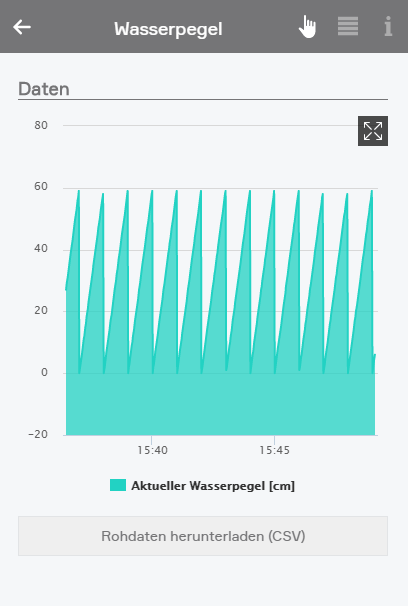

Das nachfolgende Beispiel soll den Import der Dateien in MS-Excel veranschaulichen. Öffnen Sie dazu zunächst MS-Excel mit einer leeren Arbeitsmappe.

Navigieren Sie auf den Reiter "Daten" und klicken Sie auf das Feld "Aus Text/CSV".

Wählen Sie nun die zuvor heruntergeladene Datei aus. Prüfen Sie ob die Felder und deren Typen (Zeit, Datum) korrekt erkannt werden. Sollten die Typen falsch angezeigt werden, so wie in diesem Beispiel das Datum, können Sie über Bearbeiten den Typ jeder Spalte anpassen.

Die Änderung des Datentypes erfolgt durch Klicken auf das Symbol in der Kopfzeile jeder Spalte. Klicken Sie anschließend auf "Schließen&Laden".

Durch Hinzufügen eines Liniendiagramms können Sie nun sehr einfach eigene Diagramme aus den Rohdaten erstellen.
Denon
This section contains information on using connected DENON devices.
Denon lets you play music throughout your house, whether from a USB stick, music server, Internet radio, iPod, AUX or online music.

The Denon app is located under “all apps” -“Denon”.
Currently, only the DENON DRA-N4 amplifier is supported by evon Smart Home.
Operation
Volume
You can change the volume via the “+” and “-“ buttons, or use the slider.
Source
Use this to determine where your music is to come from and see the Denon display below it. Navigate around your Denon using the 4 arrows and the enter button.
Favourites
Add the current programme to your favourites list using the button “add to favourites” so that you can find it again quickly. All your favourites are displayed in a list below this.
ON/OFF
Switch your Denon on an off.
Status
Shows which music source is currently active, Internet music, iPod etc. and shows the current IP address.
In the parameter panel, you can also define whether this Denon is to be switched with the universal scenes or not “remove from universal scene”) and how loud the Denon can be allowed to be.
Szenen
Die Denon App bietet folgende Auslöser für evon Smart Home Szenen (Wenn...):
- Play: Die Wiedergabe wurde mit Play gestartet
- Pause: Das Wiedergabe wurde mit Pause gestoppt
Die Denon App bietet folgende Funktionen für evon Smart Home Szenen (Dann...):
- Ausschalten: Das Gerät wird ausgeschaltet
- Einschalten: Das Gerät wird eingeschaltet
- Play: Die aktuelle Wiedergabe wird gestartet
Fronius
The "Fronius" app allows you to integrate your Fronius system into your evon Smart Home.

The Fronius app ist located under 'all apps' - 'Fronius'.
All limits, which can be configured in the Fronius app, can also be used as triggers for scenes.
Create
To integrate your Fronius system, please follow the steps below.
(You will need the IP Adress of your PV-system for this)
Open the Fronius app an choose 'add'.

Enter the IP address of your PV system in the now appearing popup.
Confirm it with the button 'add'.

Once entered successfully, all installed elements of your PV system will be shown.
Szenen
Die Fronius App bietet folgende Auslöser für evon Smart Home Szenen (Wenn...):
-
(Inverter) Leistungslimit 1 überschritten: Das konfigurierte Leistungslimit 1 wurde überschritten
-
(Inverter) Leistungslimit 2 überschritten: Das konfigurierte Leistungslimit 2 wurde überschritten
-
(Inverter) Leistungslimit 3 überschritten: Das konfigurierte Leistungslimit 3 wurde überschritten
-
(Inverter) Leistungslimit 1 unterschritten: Das konfigurierte Leistungslimit 1 wurde unterschritten
-
(Inverter) Leistungslimit 2 unterschritten: Das konfigurierte Leistungslimit 2 wurde unterschritten
-
(Inverter) Leistungslimit 3 unterschritten: Das konfigurierte Leistungslimit 3 wurde unterschritten
-
(Smart Meter) Bezug vom Netz begonnen: Der Strombezug vom Energieversorger-Netz hat begonnen (Es wird aktuell mehr Energie verbraucht als erzeugt)
-
(Smart Meter) Einspeisung ins Netz begonnen: Die Stromeinspeisung in das Energieversorger-Netz hat gestartet (Es wird aktuell mehr Energie erzeugt als verbraucht)
-
(Smart Meter) Netzbezugs Grenzwert 1 überschritten: Der konfigurierte Grenzwert 1 für den Netzbezug wurde überschritten
-
(Smart Meter) Netzbezugs Grenzwert 2 überschritten: Der konfigurierte Grenzwert 2 für den Netzbezug wurde überschritten
-
(Smart Meter) Netzbezugs Grenzwert 3 überschritten: Der konfigurierte Grenzwert 3 für den Netzbezug wurde überschritten
-
(Smart Meter) Netzbezugs Grenzwert 1 unterschritten : Der konfigurierte Grenzwert 1 für den Netzbezug wurde unterschritten
-
(Smart Meter) Netzbezugs Grenzwert 2 unterschritten : Der konfigurierte Grenzwert 2 für den Netzbezug wurde unterschritten
-
(Smart Meter) Netzbezugs Grenzwert 3 unterschritten : Der konfigurierte Grenzwert 3 für den Netzbezug wurde unterschritten
-
(Smart Meter) Netzeinspeisungs Grenzwert 1 überschritten: Der konfigurierte Grenzwert 1 für die Netzeinspeisung wurde überschritten
-
(Smart Meter) Netzeinspeisungs Grenzwert 2 überschritten: Der konfigurierte Grenzwert 2 für die Netzeinspeisung wurde überschritten
-
(Smart Meter) Netzeinspeisungs Grenzwert 3 überschritten: Der konfigurierte Grenzwert 3 für die Netzeinspeisung wurde überschritten
-
(Smart Meter) Netzeinspeisungs Grenzwert 1 unterschritten: Der konfigurierte Grenzwert 1 für die Netzeinspeisung wurde unterschritten
-
(Smart Meter) Netzeinspeisungs Grenzwert 2 unterschritten: Der konfigurierte Grenzwert 2 für die Netzeinspeisung wurde unterschritten
-
(Smart Meter) Netzeinspeisungs Grenzwert 3 unterschritten: Der konfigurierte Grenzwert 3 für die Netzeinspeisung wurde unterschritten
-
(Batterie) Mindestladung 1 überschritten: Der konfigurierte Wert der Mindestladung 1 wurde überschritten
-
(Batterie) Mindestladung 2 überschritten: Der konfigurierte Wert der Mindestladung 2 wurde überschritten
-
(Batterie) Mindestladung 3 überschritten: Der konfigurierte Wert der Mindestladung 3 wurde überschritten
-
(Batterie) Mindestladung 1 unterschritten: Der konfigurierte Wert der Mindestladung 1 wurde unterschritten
-
(Batterie) Mindestladung 2 unterschritten: Der konfigurierte Wert der Mindestladung 2 wurde unterschritten
-
(Batterie) Mindestladung 3 unterschritten: Der konfigurierte Wert der Mindestladung 3 wurde unterschritten
Beachten Sie, dass es sich bei den Auslösern von Szenen nur um Ereignisse handelt. Ein Ereignis wird nur zu einem kurzen Zeitpunkt aktiv (z.B.: Bezug vom Netz hat begonnen) und kann zu diesem Zeitpunkt verwendet werden um andere Funktionen auszulösen (z.B: Heizstab Boiler ausschalten). Zum Erstellen von komplexeren Abläufen bietet sich die evon Smart Home Logik an.
Elements
If you integrate a Fronius system, every installed element (which is supported by evon Smart Home) of your PV system will be displayed.
Additionally the Dashboard of the Fronius app can be extended with more panels.
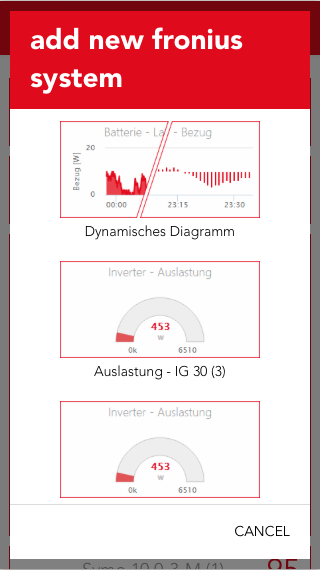
Once a PV system is integrated, you can choose to add additional panels by using the 'add' button.
You can choose between 'My Fronius', an overview about the current energy flow in your system, "Efficiency" (of the inverter), “Energy“, "Supply" and "Phase Distribution".

There is also a dynamic diagram available, which can be customized by the user. It allows you to choose between different values and diagram types.
All panels can be added to the home screen by selecting them with a long click/press.
Inverter

Operation
The most important values are displayed in the first part of the detail view (Operator Panel).
Additionally, the utilization and energy values for year, month and week will be shown in a diagram.
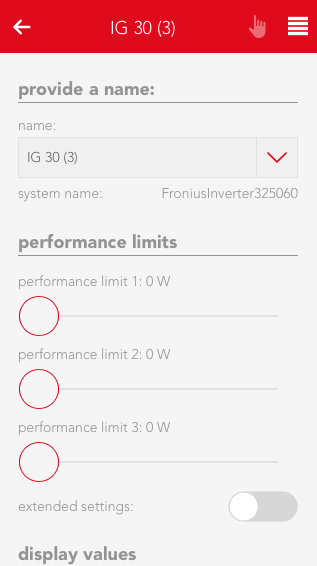
Configuration
The second part of the detail view (Parameter Panel) allows you to view detailed values and and adjust limits. Three power limits can be set which will trigger an event once exceeded or below the set value.
Detail values
Lists values which can be used by an inverter in the system.
Scenes
The inverter offers an event for the power limits 1,2 and 3 in case they are exceeded (above/below).
Smart Meter

Operation
The operator panel of the Smart Meter displays the current feed-in/supply to or from the power grid and presents them in an area diagram.

Configuration
The parameter panel displays the phase distribution in a bar chart and allows you to adjust feed-in/supply limits for he power grid, which will throw an event once exceed (below/above). In addition, all detail values of the Smart Meter are displayed.
Detail values
Shows values which can be used by a Smart Meter in the system.
Scenes
The Smart Meter offers events for feed-in/supply to or from the power grid in case they are exceeded (above/below).
Battery

Operation
The operator panel displays the current charging/discharging rate (in watt) and the current battery power level.
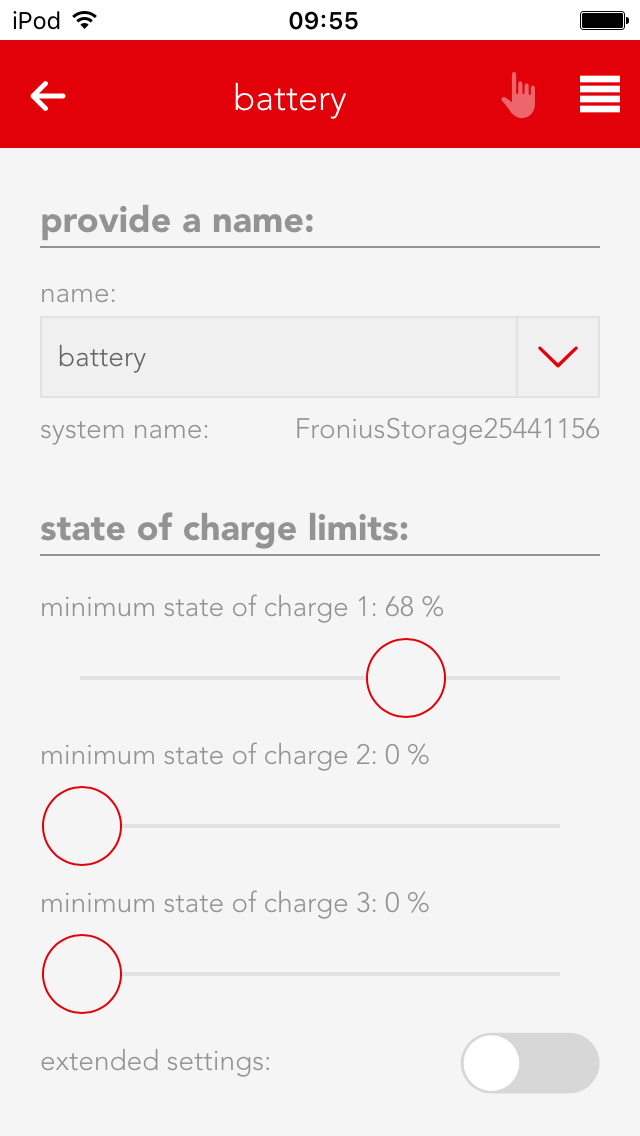
Configuration
The parameter panel allows you to adjust the minimum charging level, which will trigger an event in case it is exceed (above/below), and to view the detail values of the battery.
Detail values
Shows values which can be used by a battery in the system.
Scenes
The battery offers events for exceeding (above/below) the minimum charging limit.
TCP Client
The TCP Client app allows you to communicate with TCP-compatible devices (TCP clients). Among them are devices like beamers, TVs and many more. Additionally, you can use a gateway (TCP to serial port) to send commands to different devices with a serial port.
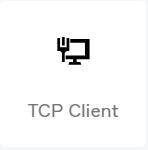
The TCP Client app is located under “all apps” – “TCP Client”.
Create

To create a new TCP Client, navigate to the app and choose 'add TCP client'.

On every TCP Client, there is a symbol which shows you if there ist a working connection to the desired device. As you have to configure every new TCP Client first, the symbol will display a red X.
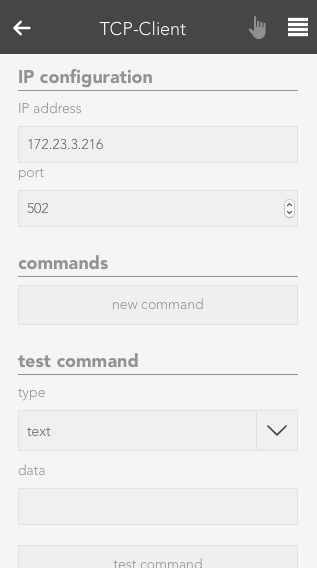
Before the TCP Client can communicate, you have to enter a valid IP address in the settings. To do so, open the Parameter panel of your newly created TCP Clients and enter the IP address and the port of the desired device.

If the IP address and port are correct and a successful connection could be established, you will see a green checkmark in the display of the TCP Client after some seconds.
Configuration
The settings of the TCP Client allow you to configure new commands and events, which can be linked in scenes.

IP configuration
The IP address and port of the device for which you want your TCP Client to establish a connection to should be entered here. This settings should be the first configuration you make after creating a new TCP Client. The Operator Panel will then tell you if your connection is working.
Commands
If you want to create a new command, you can do this here by using the 'new command' button. Choose a name and the data which should be send. You can decide between simple text or hex values. Additionally, you can also decide whether you expect a specific answer and choose between text or hex values.
Test command
If you just want to test a command, you can do this here. The result will then be displayed beneath the 'test command' button.

Events
There are some devices, which may frequently send data, without the need for a explicit request (e.g. via a command). For such use cases, every TCP Client has 3 events. For each event, you can set what data you are expecting and their type (text or hex). If an expected event occurs this event will be triggered and can be linked to when creating a Scene.
Operation
The Operator Panel of the TCP Client displays the current status of the client, allows you to send preconfigured commands and shows you a list of recently received data.

State
The current status of the TCP Client will be shown here.In case there are any problems with the connection to the desired device or you haven't entered a correct IP address yet, a red X will be displayed.
Events
Every TCP Client allows you to create 3 events, which are triggered when the conditions meets. You can then link to those events in created scenes (inside the Scene app) and use them as triggers. Configured events will be displayed in this list.
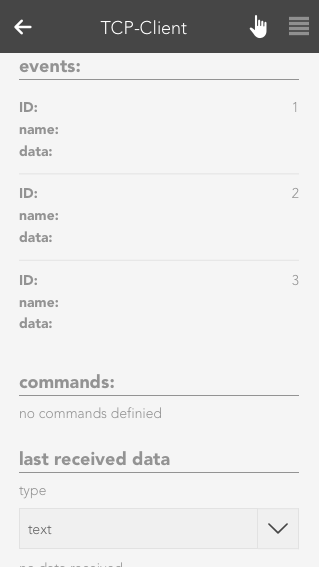
Commands
All commands you have created are listed here. You can trigger or delete each one.
Last received data
This list will display recently received data. You can switch between a 'text' or 'hex' view.
Szenen
Der TCP Client bietet folgende Auslöser für evon Smart Home Szenen (Wenn...):
- Ereignis 1 ausgelöst: Das konfigurierte Ereignis 1 wurde ausgelöst
- Ereignis 2 ausgelöst: Das konfigurierte Ereignis 2 wurde ausgelöst
- Ereignis 3 ausgelöst: Das konfigurierte Ereignis 3 wurde ausgelöst
- Erwartete Daten vom Befehl empfangen: Die konfigurierten erwarteten Daten nach Absetzen des Befehls wurden empfangen
Detector
The Detector app allows you to use a digital input for alarms/notifications. This can be useful in cases like when you want to connect a fire alarm to your evon Smart Home.

The Detector app is located under “all apps” – “Detector”.
Create
To create a Detector, you will need a digital module ("evon Smart Home Digital 1180" or "evon Smart Home Digital 1344") with an digital input. Then, follow these steps:

Navigate to the app 'Digital Inputs', which you can find under 'All Apps'.
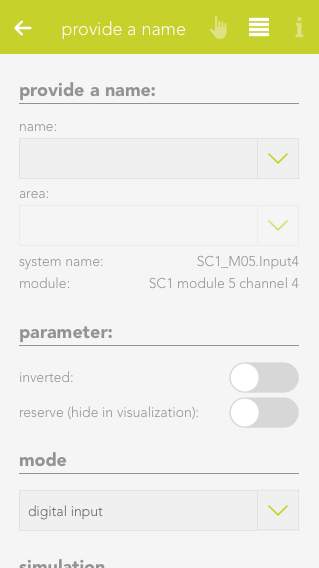
Select the desired digital input, which you want to use as a Detector.

Navigate to the settings of the chosen digital input and change its mode to 'Detector'.

The Digital Input changed into a Detector and can now be found in the 'Detector' app.
Configuration
Each Detector allows you to configure the triggered alarms. Here you will find the description about all available options.

Type
This are pre configured settings for different use cases. Each one comes with a predefined notification text, settings and specific icon.
Alarm after
Defines the timespan for which a signal has to be active on the digital input to trigger an alarm.
Notification
Here you can choose to receive a notification once an alarm gets triggered.
Notification text
Set the text you want to see in the notification.
Alarm must be acknowledged
If this option is active, an active alarm has to be manually terminated instead of ending once the input signal stops.
Reserve (hide in visualization)
Once active, the Detector will be hidden in the visualization.

Icon
Defines which image should be used for this Detector.
Alarm Output
You can choose a digital output, which will be triggered in case of an alarm, here.
Mode
Here, the Digital Input which is used for this Detector can be switched back to another mode.
Simulation on
Activates the simulation and allows you to set a value via the setting 'Simulation Value'. Attention: If the simulation is active, real values are ignored!
Simulation Value
Change the simulated value with this setting.
Operation

After you changed a Digital Input into a Detector, it will react to incoming signals and trigger an alarm, depending on its configuration.
A detector will display if his input is currently active and if it is triggering an alarm.
Szenen
Der Melder bietet folgende Auslöser für evon Smart Home Szenen (Wenn...):
- Alarm wurde ausgelöst: Der Alarm des Melders wurde ausgelöst
- Alarm wurde beendet: Der Alarm des Melders wurde beendet
Counter
This app is used when you connect a counter to a digital input. With it's help you can react to the signals send form the counter unit and evaluate them. For example, you can record a power consumption in kW, set various value limits and react to them later in scenes.

The Counter ist located under “all apps” – “Counter”.
The minimum pulse length for a counter connected to a digital module is 100ms. For faster counters, please use the input located on the cpu module.
Create
To use a counter in combination with the corresponding app, you will have to connect it to a digital input of your evon Smart Home (DI1 - DI4 on the CPU or 'evon Smart Home Digital 1180' or 'evon Smart Home Digital 1344'). Then follow these steps:

If you find not create a counter in your evon Smart Home system yet, you have to convert a digital input into one.

Navigate to te digital inputs in 'All Apps' - 'Digital Inputs', select the desired input and open the ParameterPanel.

In the settings for mode, choose 'Counter'. The digital input will now be converted into a Counter an will be listed in the Counter app.
Configuration
Every Counter allow you to change certain settings, which determine what will be counted (e.g. kWh) and what limits exists.

Pulse value
Choose the significance of the impulse which gets received by the counter. The necessary settings for this are usually listed on the counter device.
Settings
Inverted
If this option is activated, only falling edges will be counted instead of rising edges.
Reserve
Hides this counter from the visualization.
Color
Changes the color of the visible graphs.
Edit count
Here, you can set the current count to a desired value

Show statistics
Choose the graph/chart, which will be displayed in the OperatorPanel.
Limits
You can choose various limits (and according delays) here, which you can then link in scenes. Linkable values are: 'current consumption - upper limit', 'current consumption - lower limit' and 'daily consumption - limit'.

Mode
With this setting you can convert/revert a counter to a digital input or switch
Operation

Once a Counter has been created, you can add additional visual panels. Those grant you an overview about the evaluated values.
To add such a panel, use the button "add panel".

In the popup which will appear, you can choose between several graphs/charts. To do so, you have to select the corresponding Counter under 'choose counter' and then one of the desired charts.

The OperatorPanel gives you an overview about the measured values. The following sections exist:
Status
Gives you information about the total, daily and current consumption. In addition, you can also reset the counter.
Statistic
The graphs/charts which you can activate in the ParamterPanel will be shown here. The statistics which are shown here can also be reset with the corresponding button.
Szenen
Der Zähler bietet folgende Auslöser für evon Smart Home Szenen (Wenn...):
- Grenzwert Gesamtverbrauch überschritten: Der Grenzwerte für den Gesamtverbrauch wurde überschritten
- Grenzwert Tagesverbrauch überschritten: Der Grenzwert für den Tagesverbrauch wurde überschritten
- Oberer Grenzwert aktueller Verbrauch überschritten: Der obere Grenzwert für den aktuellen Verbrauch wurde überschritten
- Unterer Grenzwert aktueller Verbrauch unterschritten: Der untere Grenzwert für den aktuellen Verbrauch wurde unterschritten
Der Zähler bietet folgende Funktionen für evon Smart Home Szenen (Dann...):
- Gesamtverbrauch zurücksetzen: Der Gesamtverbrauchszähler wird zurückgesetzt
- Tagesverbrauch zurücksetzen: Der Tagesverbrauch wird zurückgesetzt
REST API
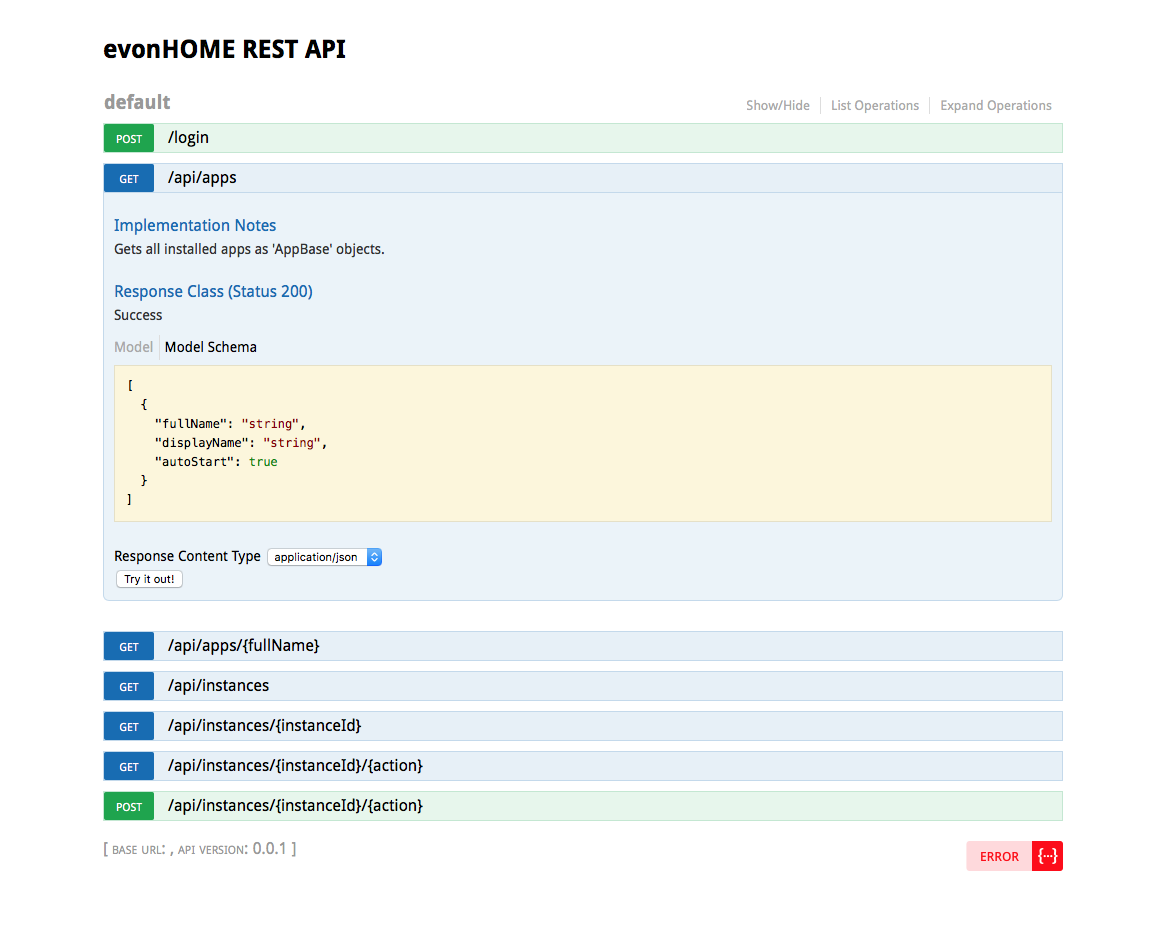
Starting with version 1.4, your evon Smart Home offers you a REST API Service at "http://[evon Smart Home_IP]/api". The following steps are required to use it.
Preparation
- Navigate to 'Alle Apps' - 'Settings' - 'Rest Service' in the user interface of your evon Smart Home system.
- Enter your evon Smart Home credentials and generate a hash (You should save the hash value as it is needed for the following step).
Authentication
To send requests to the REST API, you must authenticate yourself. A token is used for this purpose, which you will receive once you make a successful login attempt via the REST API.
- Send a POST request to the following address:
"http://[evon Smart Home_IP]/login", with this header parameters:- x-elocs-username: [Username]
- x-elocs-password: [Hash]
You will receive a token 'x-elocs-token' as a response, which will automatically be set as a cookie. This token will now be used as an authentification for all further requests.
Depending on from where you are sending your requests, the cookie will automatically be used. Otherwise, you will have to add the token to the header of every request 'Cookie:token=[Token]'.
Requests
The evon Smart Home REST API allows you check the status of the components in your system and to control them. The following requests are available to you:
GET: apps
"http://[evon Smart Home_IP]/api/apps"
Returns a list of all apps.
GET: apps/{fullName}
Returns detailed information about the requested app.
GET: instances
Returns a list of all instances.
GET: instances/{instanceId}
Returns detailed informations about the requested instance.
GET: instances/{instanceId}/{action}
Returns the current value of the requested property of a specific instance. For example, the current state of a light.
POST: instances/{instanceId}/{action}
Calls a method of the specific instance.
You can find a test interface at "http://[evon Smart Home_IP]/api", which allows you to try out all listed requests.
Examples
In the following example, we want to switch a light by using the REST API.
Before we can start, we have to make sure that the preparations for authentification are done (see topic "Preparation" and "Authentification"). With the received token, we are now able to send all requests and commands.
At first we send a GET request to `"http://[evon Smart Home_IP]/api/instances" and receive a list with all instances, which are currently active in the evon Smart Home system.
"statusCode": 200,
"statusText": "success",
"data": [
{
"ID": "SC1_M04.Light1",
"ClassName": "SmartCOM.Light.Light",
"Name": "Roomlight",
Group": "AreaOutdoor
},
...
]
}```
As we want to switch a light, we choose the 'Roomlight' and use its "ClassName": "SmartCOM.Light.Light" to send a GET request to `"http://[evon Smart Home_IP]/api/apps/SmartCOM.Light.Light"` and receive the available methods and properties.
```{
"statusCode": 200,
"statusText": "success",
"data": {
"methods": [
{
"parameter": [],
"name": "SwitchOn",
"type": 0,
"derived": false,
"tags": [
linkable
],
"returnType": "void",
"description": "switch light on",
"isStatic": false
},
...
],
"properties": [
{
"name": "IsOn",
"type": "boolean",
"remark": "light switched on",
"declaration": "2",
"derived": true,
"parameter": false,
"tags": [
linkable
],
"isStatic": false
},
...
],
"fullName": "SmartCOM.Light.Light",
"displayName": "Light",
"autoStart": false
}
}```
We are now sending a POST request to `"http://[evon Smart Home_IP]/api/instances/SC1_M04.Light1/SwitchOn"` with the following parameters in the header:
- instanceId: SC1_M04.Light1
- action: SwitchOn
- body: [ ]
This will call the specified method of the light and switch it on. We can also check the current status by sending a GET request to `"http://[evon Smart Home_IP]/api/instances/SC1_M04.Light1/IsOn"` and receive a response containing the current status, in this case 'true'.
```{
"statusCode": 200,
"statusText": "success",
"data": true
}```uLux
The app allows you to configure the evon Smart Home uLux switch.

The uLux app is located under “all apps” – “uLux”.
Important: To integrate the uLux switch into evon Smart Home, the required uLux design-template must be present on it. In delivery state, all evon Smart Home uLux switches already contain this template. Further configuration with the uLux software is not required.
Create

To create a new uLux room, click on the add symbol, after which a search for uLux switches in your network is started. If the switch is not immediately found, you can just restart the search. Once the uLux is found, you just have to select it to add it to your system.
Configuration
After the uLux switch has been found, you only need to add a name, a room and an IP-address.
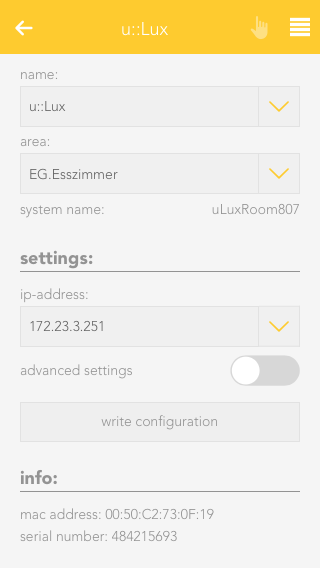
Settings
Here, you can change the network address of your uLux switch.
If you edit this settings, you will have to press the button 'write configuration' to transfer them to your uLux switch. The switch will then restart and boot up with your new configuration after some seconds.
Operation
The uLux switch works like a room control. This makes it easy to add all elements from a room (lights, blinds, heating, scenes) to it.

Just add a name and room to your uLux switch and once you finish the configuration every element from this room will automatically be displayed on the switch.
If an uLux extension module is connected, your can find all measured values in the 'extension' section. Those values can also be linked in the Logic app.
Szenen
Der u::LUX Schalter bietet folgende Auslöser für evon Smart Home Szenen (Wenn...):
- Bewegung erkannt (Erweiterungsmodul): Am u::LUX wurde eine Bewegung erkannt (Nur mit Erweiterungsmodul möglich)
Access Control
Erstellen

Nachdem der Fingerscanner an das passende "evon Smart Home Auxiliary – RS485" Modul angeschlossen wurde, können Sie diesen im evon Smart Home System hinzufügen.
Legen Sie dazu ein neues Zutrittssystem über den entsprechenden Button an.

Im nun erscheinenden Popup werden alle erkannten Zutrittssysteme gelistet. Sie können das gewünschte System über einen Klick auf den Namen oder das Plus Symbol hinzufügen.
Wenn Sie mehrere Zutrittssysteme besitzen, können Sie den zweiten Button benutzen um die LEDs des verlinkten Systems aufblinken zu lassen und es dadurch identifizieren.

Wurde ein System ausgewählt, können Sie diesem im zweiten Schritt einen Namen geben.

Haben Sie Ihre Eingabe bestätigt, wird das Zutrittssystem erstellt und Sie können mit der Konfiguration beginnen.
Konfiguration

Klicken Sie zur Konfiguration Ihres Fingerscanners einmal auf das neue erstellte Zutrittsystem und navigieren Sie zu den Einstellungen in das ParameterPanel.
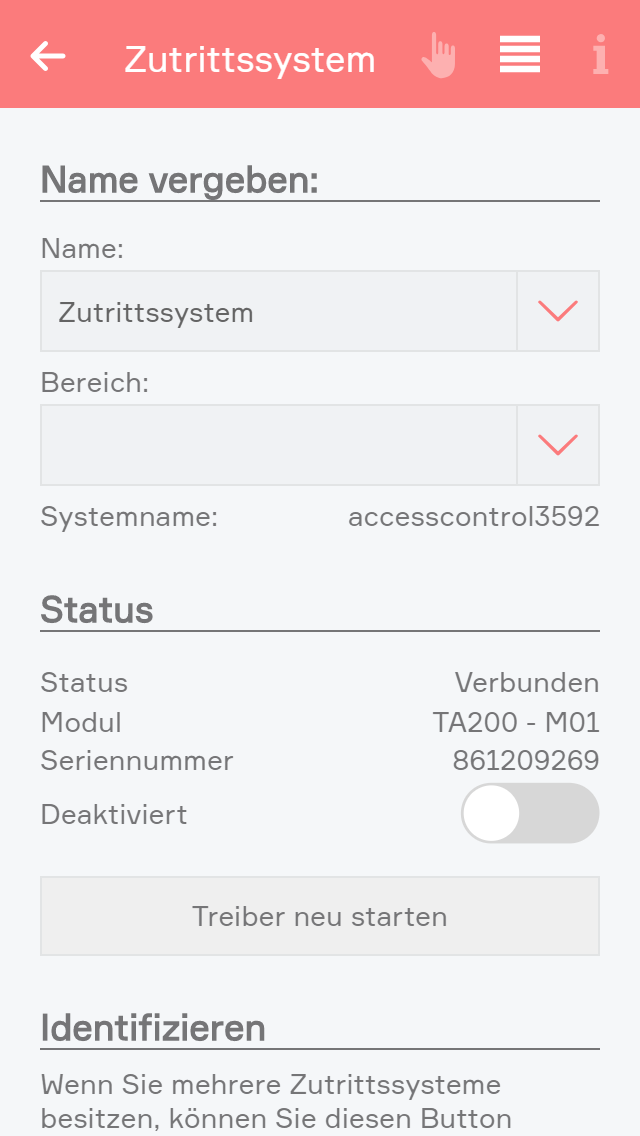
Im Bereich "Status" werden Ihnen Informationen über die Verbindung zu Ihrem Zutrittssystem angezeigt.
Wenn Sie mehrere Zutrittssysteme besitzen, können Sie den Button "Identifizieren" benutzen um die LEDs des verlinkten Systems aufblinken zu lassen und es dadurch zu finden.
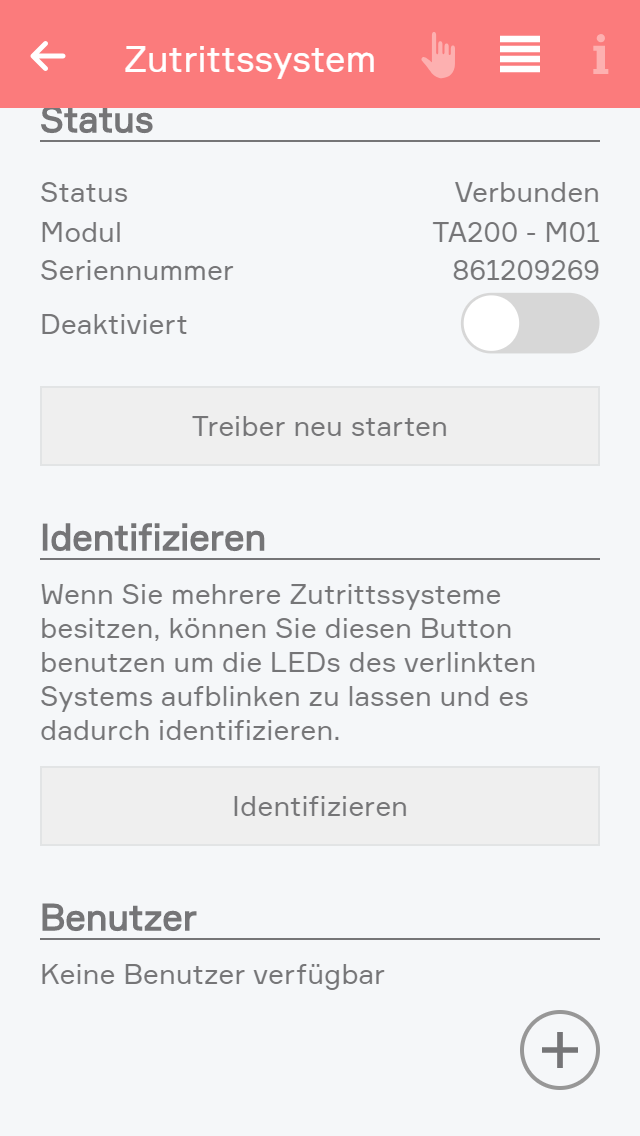
Nun können Sie damit beginnen Nutzer anzulegen, für die Sie anschließend Finger oder RFID Chips einlernen können.
Klicken Sie hierzu auf das Plus Symbol.
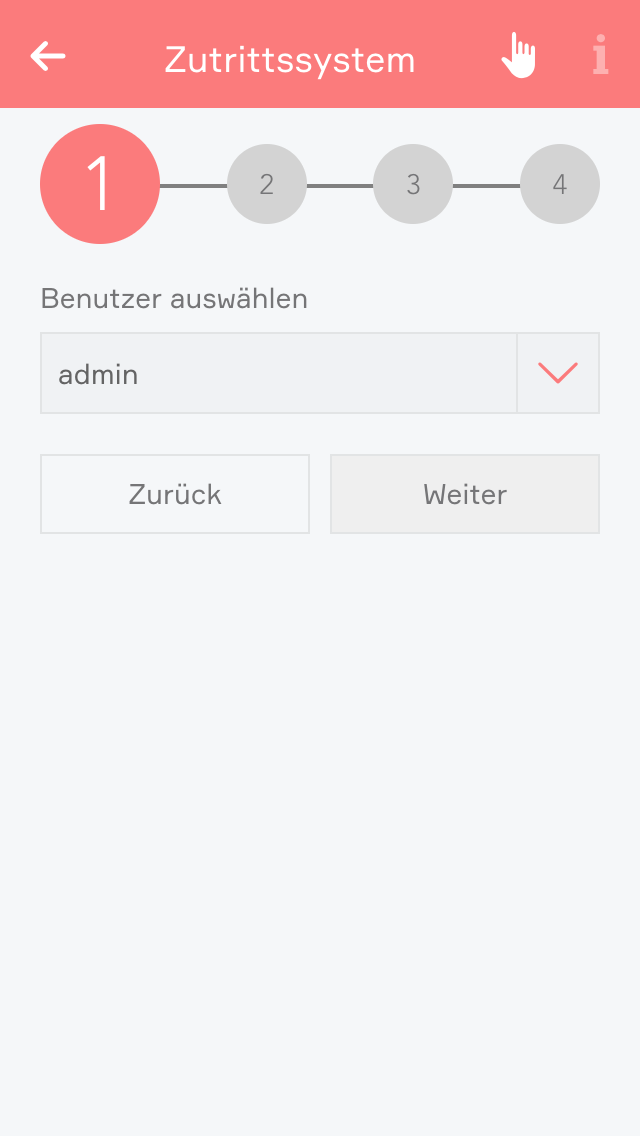
Sie werden nun durch die einzelnen Schritte geleitet, die für das Anlegen eines Benutzers und dem Einlernvorgang notwendig sind.
Wählen Sie zuerst den evon Smart Home Benutzer aus für den Sie Finger oder RFID Chips einlernen wollen.
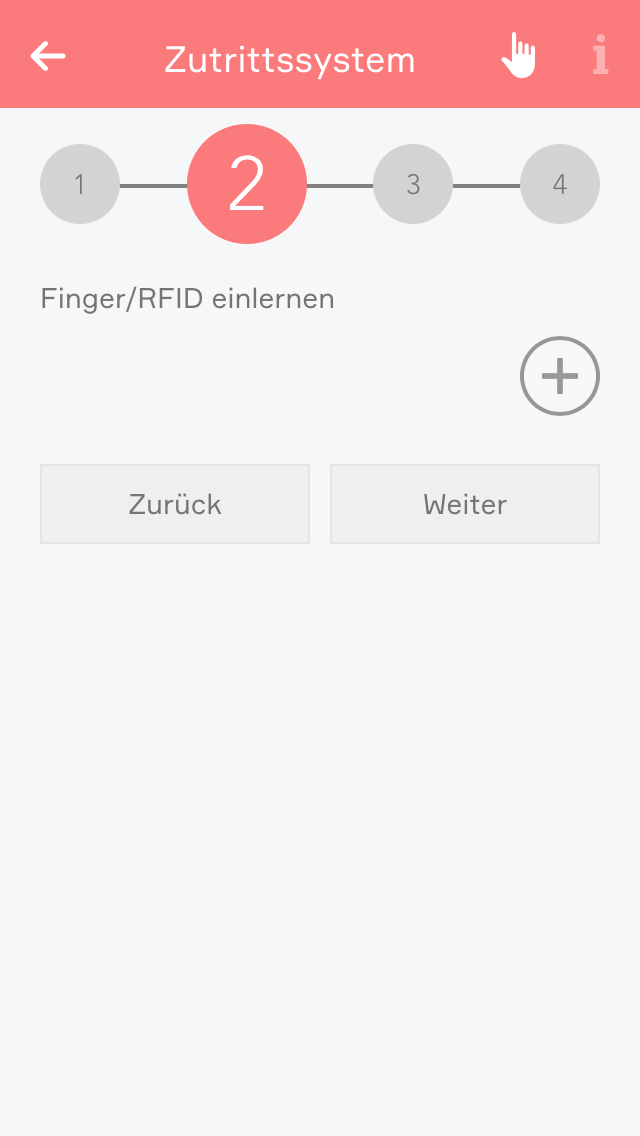
Als nächstes sehen Sie eine Übersicht der bereits eingelernten Finger/Chips. Klicken Sie auf das Plus Symbol um weitere hinzuzufügen.

Wählen Sie nun den gewünschten Finger oder RFID Chip aus und klicken Sie auf "Einlernen".
Der Einlernvorgang wird nun gestartet und Ihr Fingerscanner blinkt orange. Ziehe nun den betreffenden Finger mehrmals langsam über den Scanner, bis dieser blau leuchtet. Der Finger wurde nun erfolgreich eingelernt.
Sie können nun weitere Finger oder einen RFID Chip einlernen. Sobald Sie fertig sind klicken Sie auf "weiter".

Wenn Sie eine Tür mit Türöffner besitzen können Sie diese im nächsten Schritt mit Ihrem ausgewählten Benutzer verknüpfen. Dadurch wird die Tür entsperrt, sobald der Finger oder RFID Chip des Benutzers erkannt wird.

Sobald Sie auf "Weiter" klicken, ist die Konfiguration abgeschlossen und Sie können Ihre Änderungen über einen Klick auf "Fertig" bestätigen. Alternativ können Sie auch ein paar Schritte zurück gehen und noch weitere Finger/RFID Chips hinzufügen.

Alle erstellten Benutzer erscheinen nun in der Liste des Zutrittsystems. Neben jedem befindet sich ein kleines Schloss, über das der betreffende Benutzer gesperrt werden kann, wodurch er keine Zutrittsberechtigung mehr hat.
Außerdem können Benutzer über das X-Symbol gelöscht oder bei Klick auf den Namen angepasst werden.
Der Schalter "Deaktiviert" ermöglicht das manuelle temporäre deaktivieren des Zutrittsystems im Falle eines Defekts etc. Ein konfiguriertes Zutrittsystem wird außerdem automatisch deaktiviert, wenn dieses für eine gewisse Dauer nicht erreichbar ist.
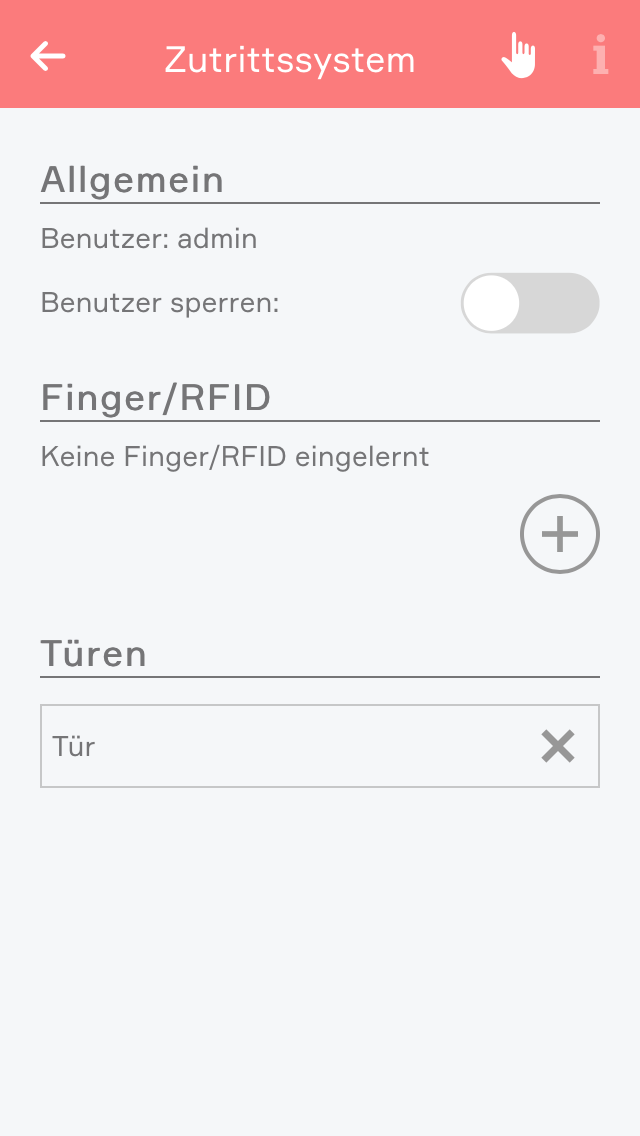
Falls Sie später weitere Finger/RFID Chips zu einem bereits angelegten Benutzer hinzufügen möchten, müssen Sie nur auf den betreffenden Namen in der Liste klicken.
In der sich öffnenden Ansicht sehen Sie nun alle bisher eingelernten Finger/RFID Chips, können diese löschen oder (über das Tür-Symbol) für den Türöffner deaktivieren. Außerdem können Sie verknüpfte Türen zu diesem Benutzer hinzufügen und entfernen.
Ihr Zutrittssystem steht Ihnen auch bei der Erstellung von Szenen zur Verfügung. Da viele Funktionen jedoch an einen Nutzer gekoppelt sind, finden Sie alle Auslöser, die einen bestimmen Nutzer betreffen unter "Benutzer".
Beispiel:
Wenn Sie eine Szene erstellen wollen, die ausgelöst wird, sobald irgendein beliebiger Finger erkannt wird, finden Sie die betreffenden Funktionen unter "Wenn"-"Apps"-"Zutrittssystem".
Möchten Sie eine Szene auslösen, wenn ein bestimmter Benutzer oder damit verknüpfter Finger erkannt wird, befinden sich diese Auslöser unter "Wenn"-"System"-"Benutzer".
Szenen
Das Zutrittssystem bietet folgende Auslöser für evon Smart Home Szenen (Wenn...):
- Finger/RFID erkannt: Ein eingelernter Finger, RFID-Token oder RFID-Karte wurde erkannte
- Finger/RFID nicht erkannt: Der benutze Finger bzw. die RFID -Karte wurden nicht erkannt
Musik
Wenn Sie ein angeschlossenes Audiomodul besitzen, können Sie es mit Hilfe der App "Musik" steuern. Jedes Audiomodul, bietet 4 einzelne Ausgänge an denen Sie Lautsprecher anschließen können, welche dann über die "Musik" App konfiguriert werden können. Außerdem ermöglicht Ihnen dieses Modul die Wiedergabe von Musik aus bis zu 4 verschiedenen Quellen.

Sie finden die Anwendung unter 'Alle Apps' - 'Musik'.
Konfiguration
Sobald ein neues Audiomodul an Ihr evon Smart Home System angeschlossen wurde, können Sie bereits mit der Konfiguration Ihrer Lautsprecher und Quellen beginnen. Befolgen Sie dazu folgende Schritte:

Bevor Sie die einzelnen Quellen und Lautsprecher an Ihre Wünsche anpassen können, sollten Sie zuerst ein paar grundlegende Einstellungen für Ihr Audiomodul vornehmen.
Navigieren Sie dazu nach 'Alle Apps' - 'Hardware', wo Ihr neues Audiomodul gelistet wird.

Öffnen Sie nun die zugehörigen Einstellungen durch einen Klick auf den Namen des Moduls.
Hier sollten Sie zu allererst festlegen, wie Sie Ihre Lautsprecher verwenden wollen. Sie haben die Auswahl zwischen Mono oder Stereogruppen, können aber auch alle 4 Lautsprecherausgänge als gemeinsame Gruppe zusammenfassen.
Je nachdem, welche Auswahl Sie hier treffen, erscheinen betreffende Lautsprecher in der Musik-App.

Einige Lautsprecher sollten nur mit einer gewissen maximalen Lautstärke betrieben werden um diese nicht zu beschädigen. Daher haben Sie hier die Möglichkeit sowohl die maximale als auch die minimale Lautstärke für alle angeschlossenen Lautsprecher einzustellen.
Bedienung

Haben Sie alle Einstellungen durchgeführt können Sie bereits zu 'Alle Apps' - 'Musik' navigieren, wo Sie nun alle verfügbaren Quellen sowie Lautsprecher wiederfinden.
Quellen

Jedes Audiomodul verfügt über vier verschiedene Quellen, welche Ihren Lautsprechern zugewiesen werden können. Während "FM-Radio" und "Aux" fest vorgegeben sind, können Sie für die übrigen zwei zwischen mehreren Optionen wählen.
Zur Auswahl stehen:
- "Lokale Dateien"
- "Internet Radio"
- "Airplay"
- "Medienserver(UPnP)"
Sie sollten hier eine Auswahl treffen, damit Sie diese Quellen verwenden können.

Je nach gewählter Option stehen Ihnen verschiedene Möglichkeiten zur Bedienung zur Verfügung. So können Sie bei "Internet Radio", "Medienserver" sowie bei den "Lokale Dateien" durch die Liste an verfügbaren Medien/Sendern navigieren und Favoriten setzen. Im Falle von Airplay lässt sich der Name ändern, der bei einer Suche auf Ihrem Endgerät angezeigt wird.

In den Einstellungen jeder Quelle haben Sie außerdem die Möglichkeit einen oder mehrere Lautsprecher für die Ausgabe zuzuweisen sowie die aktuelle Ausgabe zu überprüfen und mittels entsprechender Buttons zu steuern.

Multiroom Mode:
Sollten Sie mehr als ein Soundmodul verbaut haben, steht Ihnen die Funktion Multiroom zur Verfügung. Im Master-Modus werden dann für jeden Lautsprecher die beiden Quellen des ersten Soundmoduls verwendet. Die Gesamtanzahl der verschiedenen Quellen reduziert sich somit auf 2, jedoch erfolgt die Musikausgabe vollständig synchron in den einzelnen Räumen.
Equalizer:
Zur erweiterten Anpassung der Musikqualität, steht Ihnen im Parameterpanel der anpassbaren Quellen noch ein Equalizer mit Voreinstellungen für diverse Musikrichtungen zur Verfügung.
Zum Streamen von Spotify Musik über Android-Geräte kann das App HiFy vom Google Play Store verwendet werden (https://play.google.com/store/apps/details?id=eu.hify.pro&hl=de_AT). Einfach die Quelle auf AirPlay umstellen und in der App als Empfänger (Receiver) auswählen.
FM-Radio
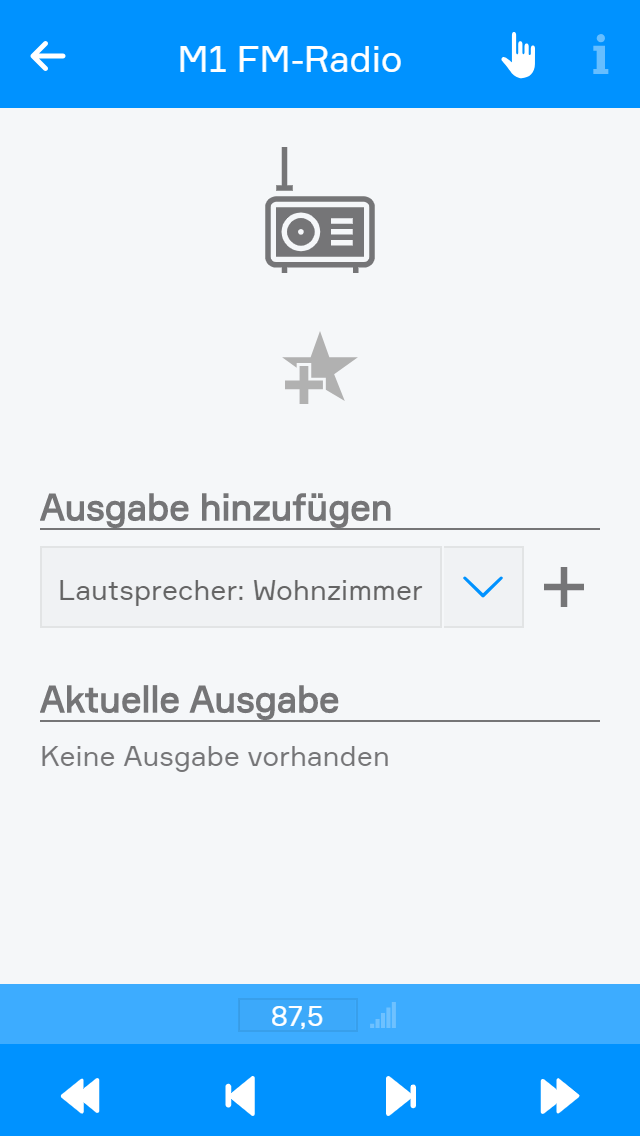
Der FM-Radio ermöglicht zusätzlich zu den 2 dynamisch verwendbaren Quellen die Musikausgabe auf den Lautsprechern. In der Fußzeile können beliebige UKW-Radiosender gespeichert werden. Die Vor/Zurück-Icons ermöglichen das manuelle Einstellen der Frequenz bzw. einen automatischen Sendersuchlauf. Das Anzeigefeld der aktuellen Frequenz kann auch zur direkten Frequenz-Vorgabe verwendet werden.
Für den optimalen Empfang wird die Verwendung einer externen Wurfantenne empfohlen.
Lautsprecher

Je nachdem, welche Einstellungen (Stereo und Mono Gruppen) Sie bei der Konfiguration Ihres Audiomoduls vorgenommen haben , werden Ihnen zwischen 1 und 4 Lautsprecher angezeigt.

Im ObjectPanel Ihres Lautsprechers werden die Informationen über die aktuelle Medienwiedergabe angezeigt. Darüber hinaus können Sie hier auch die Lautstärke verändern, wenn Sie die passende Panelgröße eingestellt haben.

Sie können jedem Lautsprecher eine von den verfügbaren 4 Quellen zuweisen. Wurde eine Quelle ausgewählt, sehen Sie im unterem Bereich der Anzeige was gerade gespielt wird und können die Lautstärke anpassen.
Bei der Verwendung von Airplay als Quelle kann die Lautstärke der Wiedergabe zusätzlich über das verbundene Gerät gesteuert werden.
Es empfiehlt sich daher die Lautstärke des Lautsprechers etwas höher zu stellen oder anzupassen.

In den Einstellungen des Lautsprechers können Sie wie gewohnt den Namen und den zugewiesenen Raum anpassen. Außerdem sehen Sie Informationen über den einzelnen Lautsprecher.

Darüber hinaus können Sie Ihrem Lautsprecher einen Taster zuweisen, über den die Wiedergabe gesteuert werden kann.
Die Geschwindigkeit, mit der die Lautstärke bei einem langen Tastendruck verändert wird, kann mit einem Schieberegler angepasst werden.
Möchten Sie, dass die Wiedergabe nach einer festgelegten Zeitspanne automatisch stoppt, können Sie den "Sleep Timer" aktivieren und nach Ihren Wünschen anpassen.
Szenen
Die Musik App bietet folgende Funktionen für evon Smart Home Szenen (Dann...):
- Internet Radio abspielen: Die Quelle wird mit dem Internet -Radio belegt
- Lokale Dateien - Favoriten abspielen: Ein beliebiger Favorit der lokalen Dateien wird auf der Quelle abgespielt
- Medienserver - Favoriten abspielen: Ein beliebiger Favorit vom Medienserver(NAS) wird auf der Quelle abgespielt
- Nächster Titel/Stream: Auf den nächsten Titel/Stream wird gewechselt
- Voriger Titel/Stream: Auf den vorherigen Titel/Stream wird gewechselt
- (UKW) Frequenz einstellen: Eine beliebige Frequenz kann für den UKW-Radio vorgegeben werden
- (UKW) Sender suchen: Der Sendersuchlauf für den UKW-Radio wird gestartet
Modbus
Erstellen
Bevor die Kommunikation zwischen evon Smart Home und Ihrem Modbus Gerät hergestellt werden kann, muss dieses zuerst in Ihr Netzwerk integriert werden. Lesen Sie dazu am besten die Anleitung des betreffenden Geräts, welche auch Informationen über die möglichen schreib-/lesbaren Werte enthalten sollte sowie über betreffende Modbus Register.

Haben Sie Ihr Modbus Gerät erfolgreich in Betrieb genommen, können Sie damit beginnen, es in Ihr evon Smart Home System zu integrieren.
Wählen Sie hierzu "Neues Gerät hinzufügen".

Dadurch wird ein neues Modbus Gerät im System angelegt und kann konfiguriert werden.
Konfiguration

In den Einstellungen des neu erstellten Modbus Gerätes sollten Sie als erstes einen Namen und einen Raum vergeben.
Anschließend müssen Sie die Netzwerk Adresse (IP, Port) sowie SlaveID des Modbus Geräts eingeben.
Wurde die Verbindung erfolgreich hergestellt, ändert sich der angezeigte Status von "Nicht Verbunden" auf "Verbunden".

Als Nächstes benötigen Sie die gerätespezifischen Informationen über les-/schreibbare Register, auf die Sie mit der evon Smart Home Modbus Schnittstelle zugreifen können.
Diese müssen Sie den Unterlagen Ihres Modbus Gerätes entnehmen.
Haben Sie alle benötigten Informationen gesammelt, ist es an der Zeit, die passenden Register anzulegen. Navigieren Sie zu dem Bereich "Register editieren" und wählen Sie "Editieren".

Sie befinden sich nun in der Registeransicht, in der Sie neue Register hinzufügen oder anpassen können.
Es stehen Ihnen hier 4 verschiedene Registerarten zu Verfügung:
Coil Status (1 Bit, Lesen-Schreiben: FC=01)
Einzelner Ein-/Ausgang.
Holding Register (16-Bit, Lesen-Schreiben: FC=03)
Analoger Ein-/Ausgang.
Input Register (16-Bit, Nur Lesen: FC=04)
Analoger Eingang.
Input Status (1 Bit, Nur Lesen: FC=02)
Einzelner Eingang.
Welche Register für Ihr Modbus Gerät verwendbar sind, sowie deren Konfigurationsdaten (Adresse, Datentyp, Lese-/Schreibzugriff) müssen Sie den Informationen entnehmen, die Ihrem Gerät beiliegen.
In den Einstellungen jedes angelegten Registers müssen diese anschließend eingetragen werden.
Neben den spezifischen Konfigurationsmöglichkeiten für jedes Register, kann auch festgelegt werden, ob der Zugriff "Lesend" oder "Schreibend" erfolgt. Bei Schreibzugriff erscheinen in der Bedienoberfläche des Registers sowie des angelegten Modbus Gerätes in evon Smart Home zusätzliche Bedienelemente über die die geschriebenen Werte verändert werden können.

In den Einstellungen des im evon Smart Home System angelegten Modbus Gerätes können Sie die Konfiguration Ihrer Register exportieren und damit sichern, um sie später wieder importieren zu können (auch in ein anderes evon Smart Home System).
Zusätzlich lässt sich einer der Register als Anzeigewert auswählen, welcher im ObjectPanel Ihres Modbus Gerätes sichtbar ist und Farbe sowie Icon ändern.
Bedienung

Die Statuswerte und Bedienelemente aller angelegten Register erscheinen im OperatorPanel des Modbus Gerätes. Nach der Konfiguration kann das Gerät hier gesteuert und ausgelesene Werte kontrolliert werden.
Neben der Bedienung über diese Ansicht, kann auch innerhalb der evon Smart Home Logik App auf alle Register zugegriffen werden.
Dadurch lassen sich komplexe Abläufe umsetzen.
Szenen
Die Modbus App bietet folgende Auslöser für evon Smart Home Szenen (Wenn...):
- Getrennt: Das Modbus Gerät wurde getrennt
- Verbunden: Das Modbus Gerät wurde verbunden
Intercom
Erstellen
Um die Türsprechanlage im evon Smart Home einbinden zu können, muss sich diese im selben Netzwerk wie Ihr evon Smart Home System befinden.

Sobald Ihre Türsprechanlage montiert und an Ihr Netzwerk angeschlossen wurde, können Sie diese in Ihr evon Smart Home System einbinden.
Legen Sie dazu eine neue Sprechanlage über den entsprechenden Button an. Im nun erscheinenden Popup wird automatisch nach der Türsprechanlage gesucht. Sobald sie gelistet wird können Sie sie auswählen und hinzufügen.
Sollte Ihre Türsprechanlage nicht automatisch gefunden werden, können Sie diese auch über den Button "Manuell" selbst anlegen. In diesem Fall müssen Sie die IP Adresse der Anlage kennen und sie in den Einstellungen eintragen.

Eine neue Sprechanlage ist nun angelegt and kann konfiguriert werden.
Konfiguration

Wurde Deine Sprechanlage automatisch im Netzwerk gefunden und hinzugefügt musst Du die IP Adresse in den Einstellungen nicht mehr angeben.
Deine Sprechanlage wird sofort nach dem Anlegen vom System konfiguriert und startet von selbst neu. Es kann 1-2 Minuten dauern, bis der Vorgang abgeschlossen wurde und die Sprechanlage wieder verbunden ist.

Wurde die Sprechanlage manuell von Dir angelegt, musst Du in die Einstellungen gehen und die IP Adresse eintragen. Nutzername und Passwort sind bereits ausgefüllt, können aber jederzeit geändert werden, falls Du diese in der Türsprechanlage angepasst hast.

Wenn die Sprechanlage manuell hinzugefügt wurde, wird sie nach dem Eintragen nicht automatisch konfiguriert und startet daher nicht von selbst neu. Dadurch kannst Du auch bereits konfigurierte Sprechanlagen in das System einfügen, ohne das die Einstellungen erneut übertragen werden müssen.
Wenn Du eine neue Sprechanlage manuell hinzufügst, musst Du daher nach dem Eintragen der IP Adresse in den Abschnitt "Erweiterte Parameter" navigieren und den Punkt "Sprechanlage Konfiguration zurücksetzen". Nach dem anschliessenden Neustart der Türsprechanlage ist diese betriebsbereit.
Es ist wichtig, dass die Konfiguration der Sprechanlage durchgeführt wird, da erweiterte Funktionen wie die Erkennung der Klingel- und Licht-Tasten sonst nicht funktionieren.
If you want to be able to use the built in microphone and speaker of your intercom to talk to visitors, we recommended to download and use the following apps:
iOS - https://itunes.apple.com/at/app/mobotix/id527836206?mt=8
Android - https://play.google.com/store/apps/details?id=org.abionix.axviewer&hl=de
Bedienung

Wurde die Verbindung mit der Sprechanlage erfolgreich hergestellt sehen Sie im OperatorPanel das aktuelle Videobild.
Über das Pfeilsymbol auf dem Bild können Sie Ihnen auch eine vergrößerte Version der Übertragung ansehen.
Falls die Sprechanlage manuell hinzugefügt wurde und Sie noch die IP Adresse eintragen müssen, erscheinen hier statt der Videoübertragung die betreffenden Eingabefelder.
Da die Türsprechanlage auch über eine Klingeltaste verfügt, können Sie sie mit einer Tür verknüpfen. Navigieren Sie dazu in die Tür App und wählen Sie eine passende Tür aus. In den Einstellungen können Sie nun die Sprechanlage hinzufügen. Wird die Klingeltaste betätigt, erhalten Sie eine Benachrichtigung mit dem aktuellen Videobild. Außerdem wird eine Aufnahme des Kamerabilds gespeichert. Wenn Sie einen Türöffner besitzen, können Sie diesen in dem im evon Smart Home System erscheinenden Popup bedienen.
Sie können die Klingel und Lichttaste der Sprechanlage auch als Auslöser für das Erstellen von Szenen in der betreffenden App verwenden.

Das ObjectPanel der Sprechanlage kann auch über das Menü, das erscheint, wenn Sie mit Ihrem Finger bzw. der Maustaste länger auf dem Element bleiben/gedrückt halten, vergrößert werden. Dadurch wird hier ebenfalls das Kamerabild eingeblendet.
Sie können die Sprechanlage auch auf Ihren Startbildschirm legen um so das Kamerabild immer sichtbar zu haben.
Szenen
Die Sprechanlage bietet folgende Auslöser für evon Smart Home Szenen (Wenn...):
- Klingeltaste wurde gedrückt: Die Klingeltaste an der Außenstelle wurde betätigt
- Lichttaste gedrückt: Die Lichttaste an der Außenstelle wurde betätigt
- Tastenfeld Zugang gewährt: Der korrekte Code wurde an der Tastenfeld -Erweiterung eingegeben
- Tastenfeld Zugang verweigert: Ein falscher Code wurde an der Tastenfeld -Erweiterung eingegeben
- Türöffner aktiviert: Über das Mobotix Interface oder App wurde der Türöffner aktiviert
Fehlersuche
Sollte es zu Problemen mit der Sprechverbindung kommen, sind nachfolgend die häufigsten Problemlösungspunkte beschrieben:
1. Prüfen Sie korrekten Netzwerkeinstellung der Sprechanlage
Führen Sie dazu als erstes einen Verbindungstest im Bereich "Einstellungen->Netzwerk" durch. Die URL "www.google.at" sollte erreichbar sein (100%). Damit ist sichergestellt, dass der Controller über eine korrekte IP-Konfiguration verfügt und auch die Namensauflösung im Internet funktioniert. Sollte der Verbindungstest fehlschlagen, prüfen Sie bitte die getätigten Einstellungen. Als DNS-Server kann alternativ auch der öffentlich verfügbare Google-DNS verwendet werden, dieser ist immer unter der IP 8.8.8.8 erreichbar.
Prüfen Sie nun ob diese Einstellungen (Subnetzmaske, Standardgateway und DNS-Server) auch in der Sprechanlage gleich übernommen wurden. (siehe Screenshots nachfolgend).
2. Teilweise müssen explizite Port-Einstellungen beim Internet-Router gemacht werden
Die Router verfügen meist über die Einstellung von Port-Trigger, Port-Forwarding oder Virtuelle Server. Im Hintergrund ist dabei häufig dasselbe gemeint. Navigieren Sie in diesen Bereich und konfigurieren Sie dann folgenden Einstellungen:
- Regel: Name "SIP", Port-Eingang 5060, Port Ausgang 5060 (TCP und UDP)
- Regel: Name "SIP_RTP" Ports-Eingang 7000-9900, Ports Ausgang 7000-9900 (TCP und UDP)
Die Regeln sollen nur für die IP-Adresse der Sprechanlage gelten.
(siehe Screenshots nachfolgend).
3. Teilweise muss SIP-ALG beim Internet-Router deaktiviert werden
Falls der Router über die Einstellung SIP-ALG (Application Layer Gateway) meist im Bereich Sicherheit verfügt, muss diese Option deaktiviert werden (siehe Screenshots nachfolgend).





Sollte es zu Problemen bei der Erkennung der Klingel- oder Lichttaste der Sprechanlage kommen, können Sie folgende Punkte überprüfen.
Damit das Betätigen der Sprechanlage Tasten in evon Smart Home erkannt wird, muss diese zuerst in evon Smart Home eingebunden werden. Die notwendige Konfiguration geschieht automatisch im Hintergrund, sobald Sie die vom System gefundene Sprechanlage hinzufügen. Sollt es sich um eine Sprechanlage handeln, die mit einem Tastenfeld verwendet wird, müssen Sie im SettingsPanel unter "Erweiterte Parameter" den Punkt "Sprechanlage mit Tastenfeld Konfiguration zurücksetzen" wählen. Das können Sie entweder bei einer bestehenden Sprechanlage durchführen oder wenn Sie sie manuell hinzufügen.
Weitere Einstellungen sind für die Erkennung der beiden Tasten der Sprechanlage nicht notwendig. Sollte die IP Adresse der evon Smart Home Engine später geändert werden, muss die Sprechanlage über das SettingsPanel wieder zurückgesetzt werden.
Überprüfung Konfiguration
Im Settingspanel der Kamera kann unter "Erweiterte Parameter" sowohl die Klingel- als auch Lichttaste geprüft werden. Ist die Konfiguration der Mobotix Sprechanlage korrekt, werden zugehörige Events ausgelöst bzw. die Anzeigen auf dem ObjectPanel aktiviert.
Sollte dies fehlschlagen, können folgende Einstellungen im Webinterface der Sprechanlage überprüft werden:

1 - Navigation in das Admin Menü zu "Profile für Netzwerkmeldungen".

2 - Hier müssen sich Einträge für "Doorbell" sowie "LightSwitch" befinden. Jeder Eintrag enthält eine Zieladresse die mit der IP Adresse der evon Smart Home Engine übereinstimmen muss, sowie den vorgegeben Port "4500". Im Bereich "Datenprotokoll" befindet sich außerdem ein Eintrag für den "CGI"-Pfad, der den Systemnamen der Sprechanlage in evon Smart Home enthält. Dieser kann im SettingsPanel kontrolliert werden und muss mit dem hier eingetragenen Systemnamen übereinstimmen.


3 - Navigation in das Setup Menü zu "Ereignisübersicht"

4 - Im Bereich "Signalereignisse" muss es je einen Eintrag für die Klingel- sowie Lichttaste geben. Hier ist darauf zu achten, das diese nicht auf "Inaktiv" gesetzt sind.

5 - Navigation in das Setup Menü zu "Aktionsgruppen-Übersicht".

6 - Hier muss es ebenfalls Einträge für die Klingel- sowie Lichttaste geben. Unter "Bearbeiten" finden sich im Bereich "Ereignisauswahl" alle möglichen Signale, die als Auslöser dienen. Hier muss "CameraBellButton" für die Klingel- bzw. "CameraLightButton" für die Lichttaste ausgewählt sein (Passend zu den Signalen aus Punkt 4). Unter "Aktionen" muss die zugehörige Netzwerkmeldung aus Punkt 2 erscheinen.
Die Sprechanlage kann direkt über die Tasten am Gerät zurückgesetzt werden.
T26/S26:
Trennen Sie die Türstation kurz von der Stromversorgung (z. B. Netzwerkstecker abziehen). Danach stellen Sie die Versorgung der Türstation(en) wieder her (z. B. Netzwerkstecker einstecken). Die rote LED leuchtet ca. 5–10 s nach Herstellen der Spannungsversorgung für die Dauer von 10 s auf. Drücken Sie während dieser Zeit kurz die Lichttaste. Die LED blinkt jetzt ein Mal und wiederholt dieses Blinksignal nach einer Pause von einer Sekunde. Anschließend drücken Sie die Lichttaste länger (> 2 s). Die Kamera quittiert die Auswahl durch 3 s schnelles Blitzen und durch einen Klingelton nach 20 s. Die Autokonfiguration startet und die Netzwerkdaten werden angesagt (z. B. IP-Adresse).
T25 (älteres Modell):
Trennen Sie die Türstation kurz von der Stromversorgung (z. B. Netzwerkstecker abziehen). Danach stellen Sie die Versorgung der Türstation(en) wieder her (z. B. Netzwerkstecker einstecken). Sobald die Licht- und Klingeltaste am Kameramodul weiß leuchten, halten Sie die Klingeltaste solange gedrückt, bis beide Tasten kurz blinken. Die Autokonfiguration startet und die Netzwerkdaten werden angesagt (z. B. IP-Adresse).
Tastenfeld
Die Türsprechanlage kann mit einem Tastenfeld ergänzt werden, welches den Zutritt sowohl mittels Zugangscode als auch durch RFID Karten ermöglicht.
Einführung
Im Folgenden werden die notwendigen Schritte beschrieben, um eine Mobotix Türsprechanlage (T25) durch ein Tastenfeld zu erweitern und dieses soweit vorzubereiten, dass eine Einbindung in evon Smart Home möglich ist.
Die Notwendigen Schritte gliedern sich dabei in folgende Punkte:
- Anschluss und Verkabelung
- Reset der Mobotix (T25) Anlage
- Erstkonfiguration des Tastenfelds
- Einrichtung in evon Smart Home
https://cdn.competec.ch/documents/2/9/293364/Schnellinstallation_T25_DE.pdf
Reset der Mobotix (T25) Anlage
- Strom an -> Mobotix Kamera Tasten leuchten -> Klingeltaste gedrückt halten bis beide Tasten kurz blinken
- Kamera bootet neu und sagt IP Adresse an -> IP Adresse aufschreiben, da sie für die spätere Konfiguration benötigt wird.
Erstkonfiguration des Tastenfelds
Nach Abschluss des Resets der Mobotix Türsprechanlage (Durchsage der aktuellen IP Adresse):
- Keypad blinkt weiß, ESC-Taste blinkt rot und OK-Taste blinkt blau
- Gewünschten Super-PIN (8-16 Stellen) eingeben und mit OK bestätigen.
- Super-PIN erneut eingeben und nochmals mit OK bestätigen.
- Nach erfolgreicher zweimaliger Eingabe des Super-PIN leuchtet des Keypad kreisförmig weiß und das Keypad wechselt in den RFID Einlernmodus
- Im Lieferumfang des Keypads befinden sich mehrere RFID Karten: 1 Admin-Karte (rot) sowie mehrere User-Karten (blau).
- Die Admin-Karte (rot) nun ca 5 Sekunden vor das Tastenfeld halten, bis kein Signalton, mehr ertönt. Wurde die Admin-Karte korrekt eingelernt, leuchtet das Tastenfeld zur Bestätigung kurzfristig in Form eines Kreises (Tasten 2, 4, 6, 7, 9 ,0).
- Danach leuchten alle Tasten weiß, die ESC-Taste blau sowie die OK-Taste blau. Es können nun User-Karten eingelernt werden. Hierzu eine User-Karte vor das Tastenfeld halten und warten, bis die Bestätigung in Form des Kreises erscheint. Schritt für gewünschte Anzahl an eingelernten User-Karten wiederholen.
- Die Einlernzeit für User-karten endet nach 2 Minuten. Alternativ kann der Vorgang manuell beendet werden, indem die ESC-Taste gedrückt wird.
Achtung: Der eingegebene Super-PIN überschreibt das Factory Passwort der Türsprechanlage ("meinsm"). Für Zugriffe auf das Interface der Mobotix muss daher nach Einrichtung des Tastenfelds der Super-PIN als Passwort für den Login verwendet werden.
Zugangscodes einrichten
https://www.youtube.com/watch?v=BqQbM3qUbZM
Nach Abschluss der Erstkonfiguration können die eingelernten RFID Karten für den Zutritt verwendet werden. Um den einzelnen Karten Zugangscodes (4-16 Ziffern; Nur 0 nicht erlaubt) zuzuweisen, müssen folgende Schritte befolgt werden:
- OK-Taste gedrückt halten bis das Tastenfeld zwei Bestätigungstöne von sich gibt. -> OK-Taste blinkt nun blau
- Admin-Karte vor das Tastenfeld halten bis ein doppelter Bestätigungston erklingt. -> Ok-Taste leuchtet konstant blau
- Schlüssel-Taste drücken. -> Schlüsseltaste leuchtet konstant blau
- Ok-Taste gedrückt halten bis der zweite Bestätigungston erklingt. -> Schlüssel-Taste und OK-Taste leuchten konstant blau
- Nun muss die Nummer der Karte ausgewählt werden, für die ein Zugangscode eingerichtet werden soll. Dabei bestimmt die Reihenfolge, in der die Karten eingelernt wurden ihre Nummer. "1" ist somit die erste eingelernte Karte usw.
- Wählen Sie nun die gewünschte Karte durch Eingabe der passenden Zahl und bestätigen Sie mittels Ok-Taste.
- Geben Sie nun den gewünschten Zugangscode ein und bestätigen Sie mit der Schlüssel-Taste
- Wiederholen Sie die Eingbabe und bestätigen Sie erneut mit der Schlüssel-Taste
- Das Tastenfeld bestätigt die Eingabe mit einem Bestätigungston und einem ringförmigen Leuchten der Tasten.
Einrichtung in evon Smart Home
Um die Mobotix Türsprechanlage mit dem Mobotix Keypad mit evon Smart Home zu verbinden, muss eine neue Sprechanlage hinzugefügt werden. Da die Zugangsdaten der Türsprechanlage durch die Installation des Tastenfeldes nicht mehr mit dem Auslieferungszustand übereinstimmen, muss dies über den manuellen Modus geschehen.
- Navigation zu "Alle Apps" Sprechanlage
- "Sprechanlage hinzufügen"
- Die Sprechanlage sollte automatisch mit der passenden IP-Adresse gefunden werden. Diese für den nächsten Schritt notieren (Es sollte sich um die selbe Adresse handeln, die beim Reset der Mobotix Sprechanlage durchgesagt wird).
- "Manuell" wählen.
- Die notierte IP-Adresse eingeben. Nutzername ist "admin", Passwort entspricht der am Mobotix Keypad eingerichteten Super-PIN.
- Sind die Daten korrekt, sollte das Bild der Sprechanlage angezeigt werden.
- Ins ParameterPanel navigieren -> "Erweiterte Parameter" öffnen und "Sprechanlage mit Tastenfeld Konfiguration zurücksetzen" wählen.
Miele
Die Miele App ermöglicht die Anbindung des neusten Miele Einbau-Kaffeevollautomats.
Weitere Informationen folgen in Kürze.
Heatpump
Erstellen
Die Anbindung und Steuerung einer Wärmepumpe an Ihr evon Smart Home System erfolgt über digitale Eingänge und digitale oder analoge Ausgänge, je nachdem, was Ihre Wärmepumpe unterstützt.

Wurde die Wärmepumpe an betreffende Ein- Ausgänge angeschlossen, muss sie in Ihrem evon Smart Home System angelegt werden.
Wählen Sie dazu "Wärmepumpe hinzufügen".

Nun wird eine neue Wärmepumpe erstellt und kann konfiguriert werden.
Konfiguration

Nachdem Sie eine neue Wärmepumpe in evon Smart Home angelegt haben, sollten Sie dieser zunächst einen Namen geben und sie einem Raum zuordnen.
In den Einstellungen haben Sie auch die Möglichkeit, die Funktion "Betriebsmodus für Raumklima übernehmen" zu aktivieren. Ist diese Funktion aktiv, wird bei Änderung des Betriebsmodus (Heizen/Kühlen) der Wärmepumpe auch der Modus des Raumklimas in den Einstellungen angepasst.
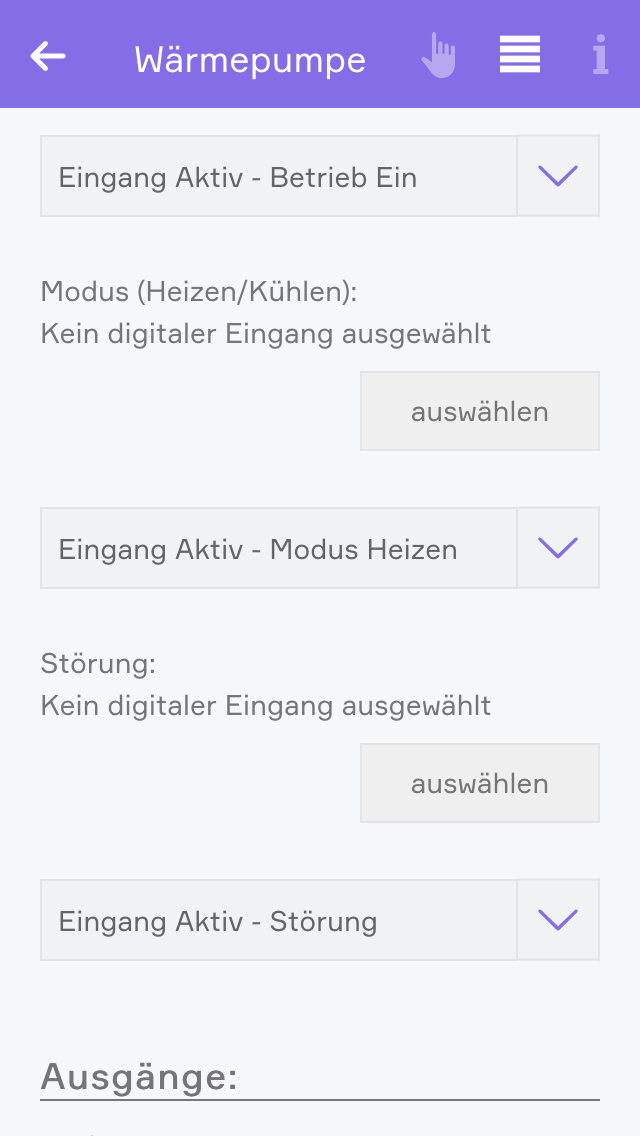
Um die angebundene Wärmepumpe zu steuern oder ihren aktuellen Status zu erhalten, müssen Sie die passenden Ein- und Ausgänge auswählen, über die sie an Ihr evon Smart Home System angeschlossen wurde.
Über die digitalen Eingänge haben Sie die Möglichkeit, den Status folgender Werte zu erhalten:
Ein/Aus
Stellt den aktuellen Betriebszustand dar.
Modus (Heizen/Kühlen)
Der Aktuelle Betriebsmodus der Wärmepumpe.
Störung
Wird verwendet um eine Störung der Pumpe zu melden.
Da nicht jede Wärmepumpe die digitalen Signale gleich handhabt, können Sie für jeden Eingang einstellen, wie diese interpretiert werden.
Die Verwendung der digitalen Eingänge ist für den Betrieb der Wärmepumpen-App nicht zwingend erforderlich. Sollten Sie nicht alle oder keine der digitalen Eingänge konfiguriert haben, werden für die angezeigten Werte (Modus, Status) die aktuellen Zustände der digitalen Ausgänge verwendet.
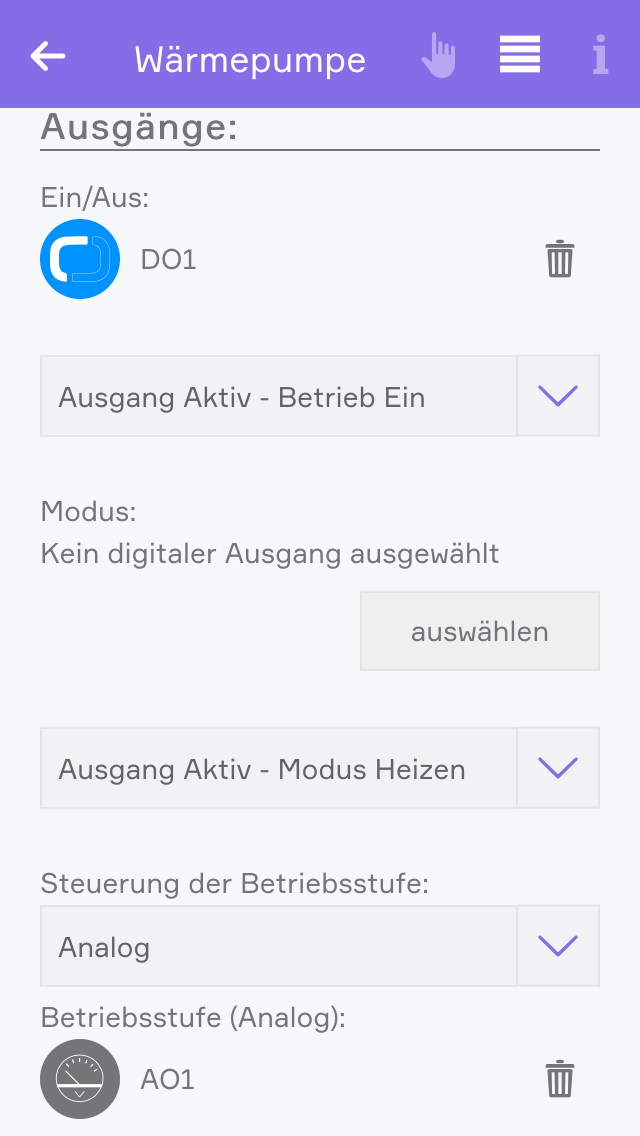
Über die digitalen Ausgänge haben Sie die Möglichkeit, den Status folgender Werte zu ändern:
Ein/Aus
Stellt den aktuellen Betriebszustand dar. Dieser Ausgang ist zwingend erforderlich um die Wärmepumpe in Betrieb zu nehmen und die anderen Bedienelemente zu aktivieren.
Modus (Heizen/Kühlen)
Der Aktuelle Betriebsmodus der Wärmepumpe.
Auch hier kann eingestellt werden, wie die Signale interpretiert werden.
Steuerung der Betriebsstufe
Für die Steuerung der Betriebsstufe können Sie zwischen analogem oder digitalem Ausgang wählen. Bei analoger Steuerung benötigen Sie nur einen einzelnen Ausgang über den sich die Betriebsstufe in 10 Stufen regeln lässt.
Bei der Verwendung von digitalen Ausgängen werden 3 einzelne digitale Ausgänge benötigt, über die die Wärmepumpe in 3 Stufen geregelt werden kann.
Operation
Szenen
Die Wärmepumpe bietet folgende Auslöser für evon Smart Home Szenen (Wenn...):
- Betrieb Aus: Die Wärmepumpe wurde ausgeschaltet
- Betrieb Ein: Die Wärmepumpe wurde eingeschaltet
- Modus Heizen: Der Modus der Wärmepumpe wurde auf Heizen gestellt
- Modus Kühlen: Der Modus der Wärmepumpe wurde auf Kühlen gestellt
- Störung erkannt: Eine Störung der Wärmepumpe wurde gemeldet
Die Wärmepumpe bietet folgende Funktionen für evon Smart Home Szenen (Dann...):
- Ausschalten: Die Wärmepumpe wird ausgeschaltet
- Betriebsstufe setzen: Eine beliebige Betriebsstufe kann für das Gerät gesetzt werden
- Einschalten: Die Wärmepump wird eingeschaltet
- Heizen: Der Modus Heizen wird aktiviert
- Kühlen: Der Modus Kühlen wird aktiviert
Ventilation
Erstellen
Die Anbindung und Steuerung einer Lüftung an Ihr evon Smart Home System erfolgt über digitale Eingänge und digitale oder analoge Ausgänge, je nachdem, was Ihre Lüftung unterstützt. Sie können auch Lüftungssysteme der Firma Pluggit einbinden, wenn diese sich im selben Netzwerk wie Ihr evon Smart Home befinden.

Wurde die Lüftung an betreffende Ein- Ausgänge angeschlossen, oder im Fall eines Pluggit Systems mit Ihrem Netzwerk verbunden, muss sie in Ihrem evon Smart Home System angelegt werden.
Wählen Sie dazu "Lüftung hinzufügen".

Es erscheint ein Popup, über welches Sie das betreffende Lüftungssystem auswählen können.

Sobald Sie eine Wahl getroffen haben, wird eine neue Lüftung erstellt und kann konfiguriert werden.
Digital

Nachdem Sie eine neue Lüftung in evon Smart Home angelegt haben, sollten Sie dieser zunächst einen Namen geben und sie einem Raum zuordnen.

Um die angebundene Lüftung zu steuern oder ihren aktuellen Status zu erhalten, müssen Sie die passenden Ein- und Ausgänge auswählen, über die sie an Ihr evon Smart Home System angeschlossen wurde.
Über die digitalen Eingänge haben Sie die Möglichkeit, den Status folgender Werte zu erhalten:
Ein/Aus
Stellt den aktuellen Betriebszustand dar.
Störung
Wird verwendet um eine Störung der Lüftung zu melden.
Da nicht jede Lüftung die digitalen Signale gleich handhabt, können Sie für jeden Eingang einstellen, wie diese interpretiert werden.
Die Verwendung der digitalen Eingänge ist für den Betrieb der Lüftungs-App nicht zwingend erforderlich. Sollten Sie den Eingang für den Betriebsstatus nicht konfiguriert haben, wird für den angezeigten Wert der aktuelle Zustand des entsprechenden digitalen Ausgangs verwendet.

Über die digitalen Ausgänge haben Sie die Möglichkeit, den Status folgender Werte zu ändern:
Ein/Aus
Stellt den aktuellen Betriebszustand dar. Dieser Ausgang ist zwingend erforderlich um die Lüftung in Betrieb zu nehmen und die anderen Bedienelemente zu aktivieren.
Es kann zusätzlich eingestellt werden, wie das Signal interpretiert werden soll.
Steuerung der Betriebsstufe
Für die Steuerung der Betriebsstufe werden 3 einzelne digitale Ausgänge benötigt, über die die Lüftung in 3 Stufen geregelt werden kann.
Pluggit
Nachdem Sie eine neue Pluggit Lüftung in evon Smart Home angelegt haben, sollten Sie dieser zunächst einen Namen geben und sie einem Raum zuordnen.

Um Ihr Pluggit Gerät steuern zu können, stellen Sie sicher, dass es sich im gleichen Netzwerk wie in Ihr evon Smart Home befindet. Tragen Sie die IP-Adresse der Pluggit Lüftung in das betreffende Feld ein.
Ist die Adresse korrekt und die Verbindung konnte erfolgreich hergestellt werden, wird Ihnen dies beim Verbindungsstatus angezeigt.
Sollte das Pluggit-Lüftungsgerät über das Netzwerk nicht erreichbar sein, müssen gegebenenfalls die Netzwerkeinstellungen über das PC-Programm "Pluggit iFlow" kontrolliert werden. Die Verbindung des Programms mit dem Lüftungsgerät erfolgt mittels USB-Kabel (Type B - Type A).
Download-Link: http://www.pluggit.com/portal/de/software-lueftungsgeraet-2-40-12113
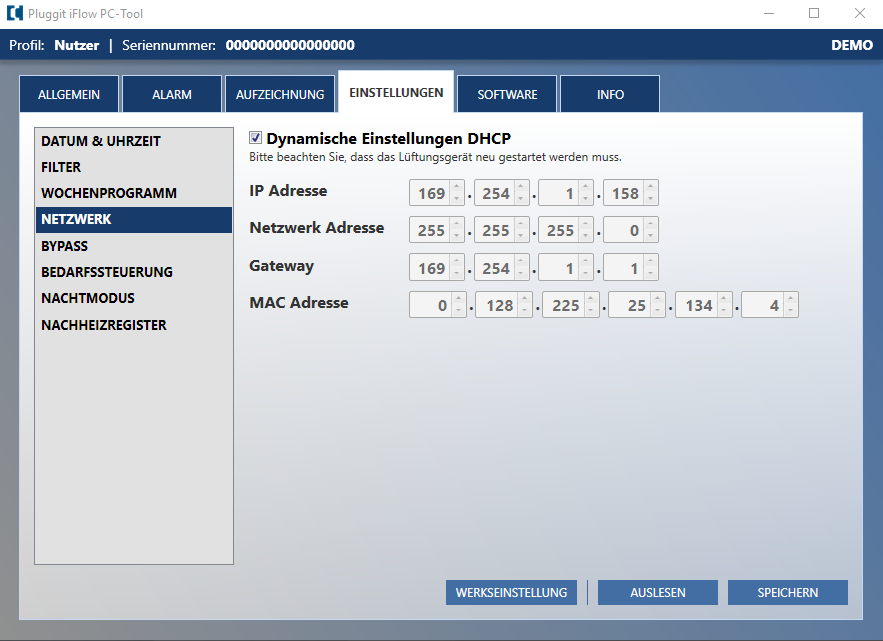
Operation
Pluggit

In der Bedienoberfläche der Lüftung, wird der aktuelle Status des Gerätes angezeigt. Sie haben hier einen Überblick über alle Sensorwerte, die Lüfterstufe sowie den aktuellen Betriebsmdus.
Der Betriebsmodus und die Lüfterstufe können mit den betreffenden Bedienelementen geändert werden. Je nachdem, welcher Betriebsmodus aktuell aktiv ist, kann es sein, dass eine Änderung der Lüftungsstufe nicht möglich ist. Das Ändern der Lüftungsstufe ist nur in den Betriebsmodi "Manuell" und "Sommer" möglich.
Folgende Betriebsmodi stehen zu Auswahl:
Manuell
Erlaubt Änderung der Lüfterstufe.
Wochenprogramm
Aktiviert eingestelltes Wochenprogramm.
Urlaub
In diesem Modus läuft das System im Feuchteschutz mit niedrigster Stufe.
Sommer
Schaltet den Zuluftventilator aus bzw verwendet den Sommerbypass (wenn installiert)
Kaminfunktion
Erzeugt einen Überdruck im Haus
Szenen
Die Lüftung bietet folgende Auslöser für evon Smart Home Szenen (Wenn...):
- Wurde aktiviert: Die Lüftung wurde aktiviert
- Wurde deaktiviert: Die Lüftung wurde deaktiviert
- Störung erkannt: Eine Störung an der Lüftungsanlage wurde gemeldet
Die Lüftung bietet folgende Funktionen für evon Smart Home Szenen (Dann...):
- Ausschalten: Das Gerät wird ausgeschaltet
- Betriebsstufe setzen: Eine beliebige Betriebsstufe kann für das Gerät vorgegeben werden
- Einschalten: Das Gerät wird eingeschaltet
Sprachausgabe
Die Sprachausgabe gibt Ihnen die Möglichkeit, von Ihnen eingegebene Texte über die an Ihr evon Smart Home Soundmodul angeschlossenen Lautsprecher wiederzugeben.

Sie finden die Anwendung unter 'Einstellungen' - 'Sprachausgabe'.
Konfiguration

Bevor Sie konfigurierte Texte über Ihr Soundmodul wiedergeben können, sollten Sie zuerst bestimmen, welche Lautsprecher dafür verwendet werden sollen. Dies können Sie in den Einstellungen der Sprachausgabe tun.
Hier haben Sie außerdem die Möglichkeit einen Signalton zu aktivieren, der vor jeder Sprachausgabe abgespielt wird.
Bedienung

In der Bedienoberfläche der Sprachausgabe können Sie den Text eingeben, der gesprochen werden soll. Außerdem ist es möglich, die Lautstärke der Ansage einzustellen.
Über den Button "Sprechen" wird die Wiedergabe auf den von Ihnen ausgewählten Lautsprechern gestartet. Darüber hinaus können Sie die Sprachausgabe auch in selbst erstellten Szenen verwenden, um Texte wiederzugeben.
Szenen
Die Sprachausgabe bietet folgende Funktionen für evon Smart Home Szenen (Dann...):
- Sprechen: Der eingegebene Text wird mit festgelegter Lautstärke gesprochen
Netatmo
The Netatmo App allows you to integrate your Netatmo Weatherstation and its Rain Gauge extension.

The Netatmo app is located under “all apps” – “Netatmo”.
Create

Once inside the Netatmo app, you can add your weather station with "add Netatmo". There, you will have to enter your Netatmo credentials to link your account with evon Smart Home.
Confirm to proceed.

If your login was successful, the system will fetch all your Netatmo Weather Stations from your account and add them to your evon Smart Home.
Configuration

The ParameterPanel of each Netatmo Device allows you to adjust its name and area as well as its displayed value, which will be shown in the ObjectPanel of the Device. For example, the Netatmo Base Station lets you select one of the following values:
- noise
- temperature
- humidity
- pressure
- CO2
Besides choosing a display value, you will also find a list of basic location information for the current Netatmo device, which are fetched from your Netatmo account.
Operation

The OperatorPanel of your Netatmo Device will list its aggregated data like noice, temperature, pressure and more.
It will also display the last time those values were loaded from the device.

At the bottom of the panel, you will find a diagram displaying all records for a selected value over a chosen time. You can change the value or timeframe via the provided dropdowns.
Philips Hue
The Philips Hue App makes it possible to integrate Philips Hue lights into your evon Smart Home.

“Philips Hue” is located under “all apps” – “settings” - "Philips Hue".
Creation
Before you can use your Philip Hue lights inside evon Smart Home you will have to connect the Philips Hue Bridge to it. Make sure that the Bridge is on the same network as your evon Smart Home system and follow these steps.
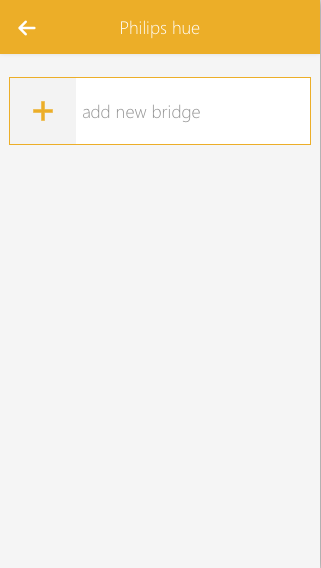
Navigate to "All Apps" - "Settings" - "Philips Hue".
All Philips Hue Bridges which are connected to evon Smart Home will be listed here. To add a new bridge to your system, use the "add new bridge" panel.

evon Smart Home will now start to search for all available Philips Hue Bridges inside your local network and lists them inside a popup.

Select the Philips Hue Bridge you want to add to evon Smart Home. You will be asked to press the link button on your Philips Hue Bridge to confirm the connection.
If the connection was established, you will be presented with a success message. You can close the popup now.
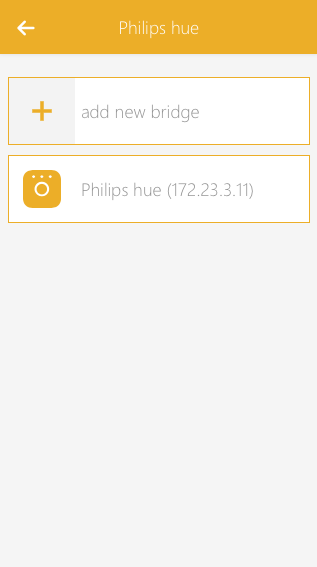
Your Philips Hue Bridge is now connected to your evon Smart Home system.

All Philips Hue lights, which are linked with the bridge, will also be added to your evon Smart Home system. In case you are changing your Philips Hue configuration in the future (adding or removing Philips Hue lights) you can use the "Search for new lights" button in the OperatorPanel.
Use the "Show lights" button to go to the list of all currently connected Philips Hue lights.
Notice that all connected Philips HUE lights will also be listed in the Lights App, which you can find under "All apps" - "Lights".
Configuration
Besides adding the Philips Hue Bridge and its connected lights to evon Smart Home as described in section "Create" no further configuration is needed. In case you add or remove any Philips Hue lights in the future, you can navigate into the settings to the bridge and use the "Search for new lights" button in the OperatorPanel. This will search for new lights and add them to your evon Smart Home.
Operation

All connected Philips Hue Lights are added to the Lights App, which can be found under "All apps" - "Lights". They behave like RGBW lights and provide the same basic controls and functionality like changing color, adjusting brightness or creating scenes with the Scenes app.

The OperatorPanel of each Philips Hue light provides you with a color wheel for selecting the desired color and a slider for adjusting the brightness. You can also add the current color/brightness combination to your favorites and activate them on demand.
Amazon Alexa
Bei "Alexa" handelt es sich um einen digitalen Sprachassistenten, der Befehle des Nutzers entgegen nimmt und je nach Anwendungsfall Antworten liefert oder verschiedene verbundene Dienste steuert. Sprachbefehle werden dafür aufgezeichnet, an die Server von Amazon gesendet, interpretiert und entsprechende damit verknüpfte Funktionen ausgeführt bzw. eine Antwort geliefert. Alexa ist nicht an ein bestimmtes Gerät gebunden, sondern lediglich ein Dienst/eine Software der/die auf beliebigen Platformen installiert werden kann. (Soweit dies über Amazon freigegeben ist.)
Es gibt diverse Geräte und Platformen, auf denen Alexa bereits verfügbar ist. Dazu gehören:
Amazon Echo (Echo Dot, Echo, Echo Plus, Echo Show, Echo Spot)
Fire TV (Fire TV Stick, Fire TV)
Fire-Tablet (Fire 7, Fire HD 8, Fire HD 10)
Mobile Apps (Amazon Music App)
Zusätzlich zu den Grundfunktionen von Alexa, wie das Abspielen von Musik oder diverse Wissenfragen, kann Alexa über sogenannte "Skills" um neue Möglichkeiten erweitert werden. Dafür gibt es einen eigenen "Alexa Skills Shop", welcher über eine Webseite (https://alexa.amazon.de) oder die offizielle Alexa App erreichbar ist.
evon Smart Home bietet eine Integration von Alexa in Form eines "Smart Home Skill" an. Somit lassen sich sowohl Geräte als auch Szenen über Sprachbefehle steuern. Folgende Geräte/Szenen lassen sich aktuell bedienen:
- Licht
- Jalousie
- Heizung
- Steckdosen
- Szenen
Weitere Informationen zu findest Du in den folgenden Abschnitten.
Erstellen
Um Alexa mit evon Smart Home verwenden zu können, wird ein Alexa kompatibles Gerät (z.B.: Fire TV oder Amazon Echo) benötigt. Ausserdem muss sich Ihr evon Smart Home in einem funktionsfähigen Netzwerk mit Internetverbindung befinden und der "Externe Zugriff" aktiviert sein.
Da alle Befehle, die Sie an Alexa richtest, zuerst an die Server von Amazon übermittelt werden, ist es aktuell nicht möglich Alexa ohne Internetzugang zu verwenden.
Bevor Sie mit der Einrichtung beginnen, stellen Sie sicher, dass der "Externe Zugriff" in evon Smart Home aktiviert ist. Sie benötigen die Zugangsdaten (ID, Benutzername, Passwort) in den folgenden Schritten.
Um Amazon Alexa mit Ihrem evon Smart Home verbinden zu können, müssen Sie den evon Smart Home Smart Home Skill aus dem Alexa Skills Shop laden. Nutze dazu die offizielle Amazon Alexa App auf Ihrem Smartphone oder Tablet. Alternativ können Sie auch über Ihren Browser auf die Seite https://alexa.amazon.de gehen.
Um den evon Smart Home Smart Home Skill zu aktivieren, müssen Sie sich mit Ihren evon Smart Home Zugangsdaten anmelden. Dazu werden Sie auf die Login-Seite von evon Smart Home weitergeleitet, wo Sie Ihre Daten eingeben müssen. War der Vorgang erfolgreich, wird der evon Smart Home Smart Home Skill aktiviert und Sie können zum nächsten Schritt übergehen.
Nach der Aktivierung startet Alexa die Suche nach kompatiblen Geräten und Szenen. Sie können diese Suche auch später in der offiziellen Amazon Alexa App oder der zugehörigen Website erneut starten.
Wurde die Suche abgeschlossen, werden alle gefundenen Geräte (z.B. Lichter) aufgelistet. Sie können die gefundenen Geräte nun bereits über Sprachbefehle steuern. (Siehe Abschnitt "Bedienung")
Configuration
Bedienung
Alle Befehle müssen mit "Alexa" beginnen. Dadurch wird Alexa geweckt und hört nun auf den folgenden Satz. Einige Geräte (und Apps) wie der Echo, haben zusätzlich eine eigene Taste, über die Alexa ebenfalls aktiviert werden kann, wodurch "Alexa" nicht mehr zu Beginn des Befehls genannt werden muss.
Der evon Smart Home Smart Home Skill verwendet die von Amazon zur Verfügung gestellte "Smart Home Skill API". Daher werden alle möglichen Sprachbefehle, die in evon Smart Home eingebunden sind, von Amazon bereit gestellt. Amazon führt regelmäßig Änderungen und Verbesserungen an Alexa durch. Dadurch kann es vorkommen, dass einige Sprachbefehle entfernt oder hinzugefügt werden. Auch die möglichen Formulierungen bestimmter Befehle können regelmäßig erweitert oder geändert werden (z.b. Licht einschalten: "aktiviere", "schalte ein" etc. )
Im Folgenden finden Sie eine Liste der möglichen Befehle, über die Sie Ihre Geräte in evon Smart Home steuern können.
Licht (Ein/Aus, Dimmen, Farbe)
- Alexa, schalte Lichtname ein
- Alexa, schalte Lichtname aus
- Alexa, stelle Lichtname auf 30 Prozent
- Alexa, erhöhe Lichtname um 20 Prozent
- Alexa, senke Lichtname um 40 Prozent
- Alexa, stelle Lichtname auf rot
Jalousie (Position)
- Alexa, stelle Jalousiename auf 30 Prozent
Heizung (Temperatur)
- Alexa, stelle Heizungsname auf 22 Crad
- Alexa, erhöhe Heizungsname um 4 Crad
- Alexa, senke Heizungsname um 2 Crad
Steckdose (Ein/Aus)
- Alexa, schalte Steckdosenname ein
- Alexa, schalte Steckdosenname aus
Szenen (Aktivieren)
- Alexa, starte Szene Szenenname
Schlotterer Funkerweiterung
Neben der kabelgebundenen Anbindung von Beschattungen, mittels evon Smart Home Beschattungsmodulen, lassen sich auch funk-basierte Beschattungselemente der Fa. Schlotterer integrieren.
Erstellen

Voraussetzung zum Einlernen bzw. Steuern von Beschattungselementen ist der USB-Transmitterstick.
Dieser muss am USB-Steckplatz am Controller (USB4) angeschlossen werden.

Zusätzlich muss der Stick mindestens über die Version 3.04 verfügen. Dies kann im SettingsPanel überprüft werden. Angeschlossene Erweiterungen finden Sie unter "Alle Apps" - "Einstellungen" - "Schlotterer".
Wurde der Stick erfolgreich verbunden, können Sie mit dem Einlernen neuer Kanäle beginnen. Beachten Sie, dass maximal 10 Elemente gleichzeitig eingelernt werden können. Es dürfen somit nur maximal 10 Elemente gleichzeitig ein- und ausgesichert werden um den Einlernvorgang bei diesen Elementen zu starten.

Starten Sie den Einlernvorgang über den Button „Neuen Kanal einlernen“. Ein einfacher Wizard führt Ihnen nun durch die notwendigen Schritte.
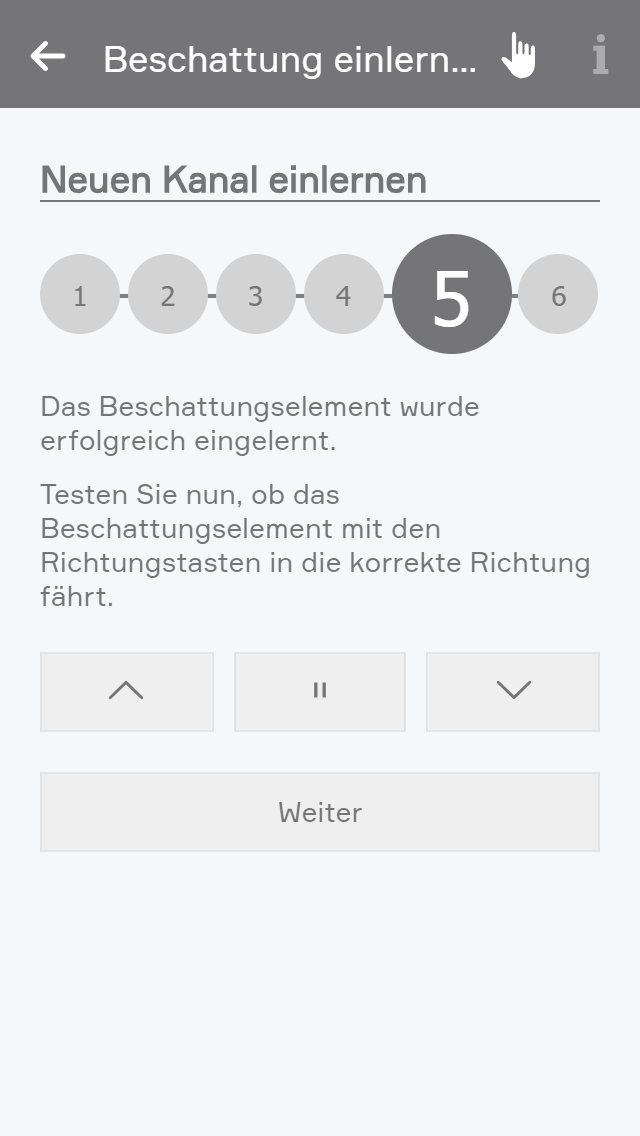
Für das neue Beschattungselement wird automatisch der nächste freie Kanal verwendet.
Außerdem wird beim Einlernvorgang automatisch erkannt, ob der Antrieb ein Rolladen-bzw. Raffstore-Motor ist. Aus dieser Information wird danach die Bedienoberfläche erstellt.

Für die Steuerung der Retrolux-Sonderfunktionen, kann nach dem Einlernvorgang in den Einstellungen der Lamellentyp ausgewählt werden. Zudem verfügt die Bedienoberfläche, je nach gewähltem Typ, über die Möglichkeit in Arbeitsstellung bzw. Geschlossene Stellung zu fahren.
Konfiguration

Bestimmung des Typs
Schlotterer Beschattungselemente sind in unterschiedlichen Ausführungen erhältlich. Je nach Typ stehen verschiedene Funktionen zur Verfügung. In den Einstellungen kann der Typ der Raffstoreelemente über die Form der Lamelle erkannt werden.
Hierfür stehen drei verschiedene Lamellentypen zur Auswahl: 80R, 80d und 92Z. Die Typen 80R und 92Z entsprechen einer herkömmlichen Jalousie, der Typ 80d entspricht einer Schlotterer Jalousie welche auch in der Ausführung mit Arbeitsstellung verfügbar ist.
Um zu erkennen welche Jalousie Sie verwenden hilft Ihnen ein Wizard, mit dem Sie anhand der Bewegung der Lamelle erkennen, um welchen Jalousie-Typ es sich handelt.
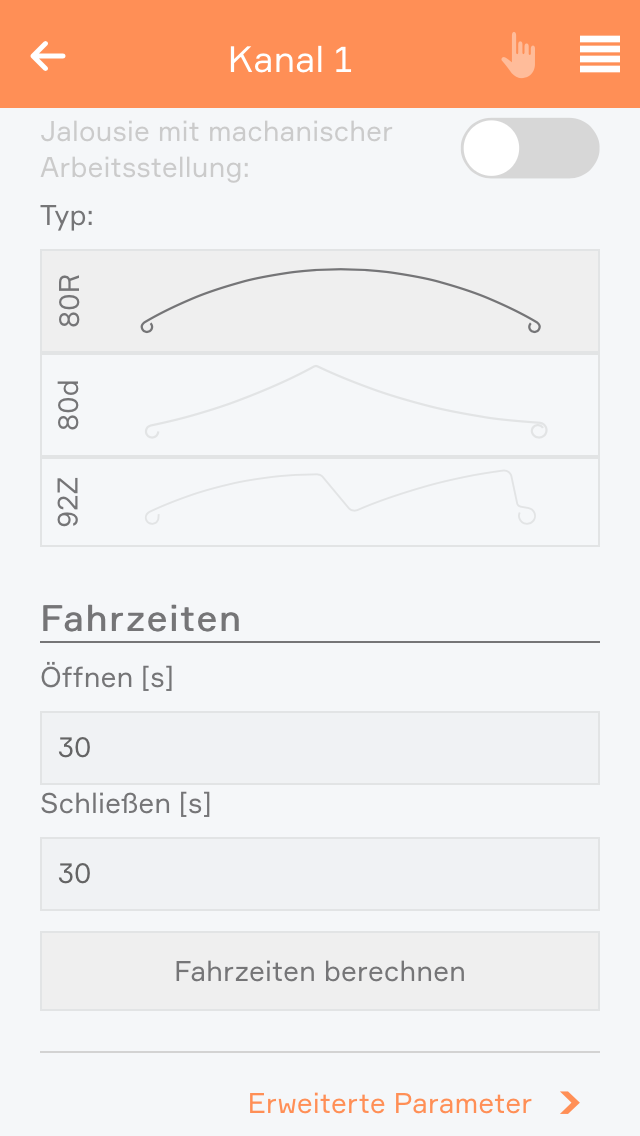
Fahrzeiten berechnen:
Alle Beschattungselemente besitzen Endpositionen, welche bei der Installation eingestellt werden. Um die korrekte Position des Elements garantieren zu können, müssen die Fahrzeiten über den Button „Fahrzeiten berechnen“ einmalig konfiguriert werden. Der Ablauf erfolgt automatisch und die Endpositionen sind anschließend korrekt eingestellt.

Verfügbare Funktionen
Rolladen
Der Rolladen bietet Funktionen zum Öffnen, Schließen, Stoppen, Positionieren und das Positionieren auf definierte Favoritenpositionen.
Die Favoritenpositionen können in den Einstellungen der Jalousie konfiguriert werden. Dabei werden Sie durch einen Wizard geführt, welcher Ihnen beim Einlernen unterstützt.
Standard Jalousie
Die Standard Jalousie bietet Funktionen zum Öffnen, Schließen, Stoppen, Positionieren, Tippen Auf und Tippen Zu.
80d mit Arbeitsstellung
Die Jalousie 80d mit Arbeitsstellung bietet zusätzlich zur Standard Jalousie die Funktionen „Arbeitsstellung“ und „Geschlossen“. Beim Modus „Arbeitsstellung“ bleibt die Lamelle immer der Jalousieposition entsprechend geöffnet. Im Modus „Geschlossen“ schließt die Jalousie und Lamelle komplett.
80d ohne Arbeitsstellung
Die Jalousie 80d ohne Arbeitsstellung bietet zusätzlich zur Standard Jalousie die Funktionen „Lichtlenkung“ und „Aufwenden“. Die Funktion „Lichtlenkung“ schließt die Jalousie und öffnet die Lamelle. Die Funktion „Aufwenden“ belässt die Jalousie auf der aktuellen Position und wendet die Lamelle auf.
Bei Rollläden und Standard Jalousien können zwei Positionen angesteuert werden (Zwischenposition und Wende-/Lüftungsposition), welche vorkonfiguriert sind, bzw. über den Funksender eingelernt werden können.
Weitere Informationen erhalten Sie über die entsprechenden Anleitungen unter https://www.elero.de/de/downloads-service/downloads/.
WakeOnLAN

Die Wake On Lan App ermöglicht Ihnen das Aktivieren/Starten verschiedener Netzwerkgeräte (TV-Geräte, Beamer, PCs, ...) welche sich in einem Standby-Zustand befinden.
Konfiguration

Geräte welche die Wake On Lan (WOL) Funktion unterstützen erwarten den Empfang der eigenen MAC-Adresse in einer speziellen Form. Aus diesem Grund muss zur Konfiguration nur die MAC-Adresse des gewünschten Gerätes eingestellt werden. Die eingegebene MAC-Adresse wird dabei validiert, die folgenden Formate werden unterstützt:
- AA:BB:CC:DD:EE:FF
- AA-BB-CC-DD-EE-FF
- AA.BB.CC.DD.EE.FF

Die Wake On Lan Funktion muss bei einigen Geräten erst aktiviert werden. Als Beispiel wird das Aktivieren der Funktion auf einem Windows-PC erklärt. Unter Systemsteuerung -> Netzwerk und Internet -> Netzwerkverbindungen -> Adapter auswählen -> Eigenschaften -> Konfigurieren... -> Erweitert -> Wake on Magic Packet -> ENABLED.
Das Aktivieren der Funktion kann abhängig vom Gerät und Schnittstelle anders funktionieren, wird aber meistens von den Herstellern dokumentiert.
Bedienung

Durch drücken des "Wake Up!" Buttons wird die Wake On Lan Funktion für das konfigurierte Gerät (MAC-Adresse) ausgeführt.
Szenen
Die WakeOnLAN App bietet folgende Funktionen für evon Smart Home Szenen (Dann...):
- WakeUp: Löst den Aufwachvorgang des konfigurierten Endgerätes aus
evon Connect
Mit der App "evon Connect" können Sie von einem zweiten evon Smart Home Werte Abfragen und Methoden aufrufen, welches sich im selben Netzwerk befindet. Damit lässt sich zum Beispiel das Öffnen der Eingangstür eines Mehrparteienwohnhauses umsetzen.

Sie finden die "evon Connect" App unter Alle Apps.
Erstellen

Um einen neuen evon Connect Client zu erstellen, navigieren Sie zur App und wählen Sie "Client hinzufügen".
Konfiguration
In den Einstellungen können Sie Allgemeine Einstellungen für den Client vergeben, wie zum Beispiel die Verbindungsdaten.

Einstellungen
Client Aktiviert
Mit dieser Option lässt sich der Client deaktivieren damit er keine Daten mehr abfragt oder sendet.
Nicht erreichbar nach
Mit diesem Wert können Sie einstellen nach welcher Zeit ein Client als "nicht erreichbar" gekennzeichnet wird.

Netzwerkeinstellungen
IP Adresse
Hier können Sie die IP Adresse des zweiten evon Smart Homes eingeben.
Port
Hier können Sie den Port des zweiten evon Smart Homes angeben. Standardmäßig ist dieser 80.
Benutzername
Hier können Sie den Benutzernamen des Benutzers angeben mit welchem Sie sich anmelden möchten. Dieser Benutzer muss im zweiten evon Smart Home angelegt sein.
Passwort
Hier können Sie das Passwort für den Benutzer angeben.
Farbe und Icon
Hier können Sie eine Farbe und ein Icon für den Client vergeben werden, welche dann entsprechend angezeigt werden.
Damit die Netzwerkeinstellungen übernommen werden müssen Sie "Netzwerkeinstellungen übernehmen" anklicken.
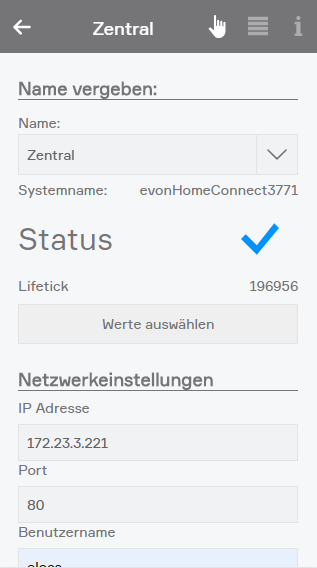
In der Bedienung können über den Button "Werte auswählen" die Werte und Methoden ausgewählt werden, welche zur Verfügung stehen sollen.

Mit "App auswählen" wird ein Wizard geöffnet welcher die Verfügbaren Werte und Methoden anzeigt und ausgewählte hinzufügt. Alternativ können Werte und Methoden auch manuell angelegt werden indem Sie auf "Neue Methode hinzufügen" oder "Neuen Wert hinzufügen" klicken.

Wenn Sie den Wizard mit "App auswählen" starten, bekommen Sie im ersten Schritt eine Ansicht mit allen verfügbaren Apps.

Im zweiten Schritt bekommen Sie eine Ansicht aller Elemente der ausgewählten App.

Im dritten Schritt bekommen Sie eine Auswahl aller verfügbaren Werten und Methoden. Wählen Sie eine davon aus wird Ihnen der entsprechende Wert oder die entsprechende Methode angelegt.

Einstellungen für Werte
Attribut ID
Hier können Sie nachträglich ändern welcher Wert abgefragt werden soll.
Zyklisch
Hier können Sie einstellen ob der Wert zyklisch abgefragt werden soll und in welchem Zyklus abgefragt werden soll.
Aktualisieren
Bei Betätigung dieses Buttons wird der Wert aktualisiert.

Einstellungen für Methoden
Methoden ID
Hier können SIe nachträglich die Methode ändern welche aufgerufen werden soll.
Parameter hinzufügen
Hier können Sie nachträglich Methoden Parameter hinzufügen. und Bestehende Parameter ändern.
Methode aufrufen
Hiermit können Sie die Methode aufrufen.
Bedienung

In der Bedienung des evon Connect Clients werden die ausgewählten Werte angezeigt und die Methoden können ausgeführt werden.

In der Ansicht unter "Werte anzeigen" lassen sich die Methoden ebenfalls ausführen.

Außerdem können Werte und Methoden auch an anderen Stellen Ihres evon Smart Home verwendet werden, wie zum Beispiel in Szenen oder Logikprogrammen. Hierfür bietet die Auswahl im oberen Bereich einen Reiter "evon Connect" mit allen verfügbaren Clients und deren Methoden und Werten.
Szenen
Die evon Connect App bietet folgende Auslöser für evon Smart Home Szenen (Wenn...):
- Client wurde Offline: Der verbundene evon Smart Home Client ist nicht mehr erreichbar
- Client wurde Online: Der verbundene evon Smart Home Client ist wieder erreichbar
Rest Client
Mit der App "REST Client" können Sie auch Funktionen auf Geräten auslösen, für welche es keine eigene evon Smart Home App gibt, welche jedoch über eine REST Schnittstelle verfügen.
Für die Verwendung von REST benötigen Sie ein Verständnis für die Funktionsweise von REST und die Schnittstellen die Ihnen das Gerät bietet, welches Sie anbinden wollen.
Eine kurze Beschreibung zu REST finden Sie hier.

Sie finden die "REST Client" App unter Alle Apps.
Erstellen

Um einen neuen REST Client zu erstellen, navigieren Sie zur App und wählen Sie "Client hinzufügen".
Konfiguration
In den Einstellungen können Sie Allgemeine Einstellungen für den Client vergeben, wie zum Beispiel die Verbindungsdaten.

Verbindung
HTTP / HTTPS
Hier können Sie angeben ob der REST Service über eine Verschlüsselte Verbindung (HTTPS) zur Verfügung steht oder nicht.
Host
Hier können Sie die IP-/Web-Addresse des REST Services angeben.
Port
Hier können Sie den Port des REST Services angeben.
Basis URL
Viele REST Services haben einen fixen Basis Pfad von welchem ausgehend alle weiteren Anfragen angehängt werden, diesen können Sie hier mitangeben. Z.B.: "/api".
Globale Header
Hier können Sie Header angeben welche mit jeder Anfrage mitgesendet werden sollen. Diese müssen als JSON String angegeben werden.
Authentifizierung
Es gibt drei vorhandene Authentifizierungsmethoden welche unterstützt werden: keine, Basic, Benutzerdefiniert.
keine
Wenn "keine" gewählt ist wird keine Authentifizierung vor dem Senden von Anfragen geschickt.

Basic
Bei "Basic" können Sie einen Benutzernamen und ein Passwort mitschicken. Diese Authentifizierungsmethode kann gewählt werden wenn der REST Service Basic Authentifizierung unterstützt.

Benutzerdefiniert
Für andere Authentifizierungsmethoden gibt es die Möglichkeit einer Benutzerdefinierten Authentifizierung.
- Methode: Hier können Sie auswählen ob die Authentifizierung über GET oder POST gesendet werden soll.
- Login URL: Hier können Sie einen Pfad für den Login wählen, dieser ist unabhängig von der Basis URL.
- Header: Hier können Sie Header für die Login Anfrage angeben. Diese müssen als JSON String angeben werden.
- Token: Hier können Sie angeben ob bei der Antwort vom REST Service der benötigte Token im Header gesendet wird oder im Body.
- Position: Hier können Sie die Position angeben an der der Token in der Antwort steht. Z.B.: "login-token" im Header.
- Inkludieren in: Hier können Sie angeben ob der ausgelesene Token bei weiteren Anfragen im Header oder im Body mitgesendet werden soll.
- Position: Hier können Sie die Position angeben an der der Token bei weiteren Anfragen eingefügt werden soll. Z.B.: "x-token" im Header.
- Periodisch Einloggen: Hier können Sie angeben ob ein periodischer Login erfolgen soll und in welchem Abstand.

Damit die Einstellungen übernommen werden muss der Button "Einstellungen übernehmen" gedrückt werden.

Über den Button "Anfragen bearbeiten" kommen Sie auf die Ansicht der Anfragen für den REST Client. Hier können Sie neue Anfragen anlegen und bestehende bearbeiten.

Mit "Anfrage hinzufügen" können Sie eine neue Anfrage erstellen.

In den Einstellungen von Anfragen können Sie definieren was in der Anfrage gesendet werden soll.
Methode
Hier können Sie auswählen mit welcher HTTP Methode die Anfrage gesendet werden soll.
Url
Hier können Sie angeben auf welchen Pfad die Anfrage gesendet werden soll. Dieser wird dann zusätzlich zum Host und Basis Pfad angehängt.
Header
Hier können Sie Header angeben welche mit der Anfrage mitgesendet werden sollen. Diese müssen als JSON String angegeben werden.
Body
Hier können Sie angeben was im Body der Anfrage gesendet werden soll. Der Body muss als JSON String angegeben werden.
Zyklisch
Hier können Sie angeben ob die Anfrage Zyklisch gesendet werden soll und in welchem Abstand.

Verwende JSON Parse
Sollten die Rückgabedaten im JSON-Format sein, kann mit dieser Funktion auf jedes Property im JSON-Object gesucht werden. Sollte das Object aus mehreren Ebenen oder Arrays bestehen kann der Selektor beliebig erweitert werden (z.B.: id.name, id[3].value, ...)

Sie können Ihre Anfrage mit "Anfrage schicken" senden, um zu testen ob alle Einstellungen richtig gesetzt sind und bekommen die Antwort angezeigt.
Zum Testen der Funktion des REST-Clients kann die Webseite "https://jsonplaceholder.typicode.com/" empfohlen werden. Dieser Webserver bietet JSON-Testdaten in verschiedenen Formaten an (z.B.: https://jsonplaceholder.typicode.com/users)
Bedienung

In der Bedienung des REST Clients werden Ihnen die Anfragen angezeigt und können gleich gesendet werden.
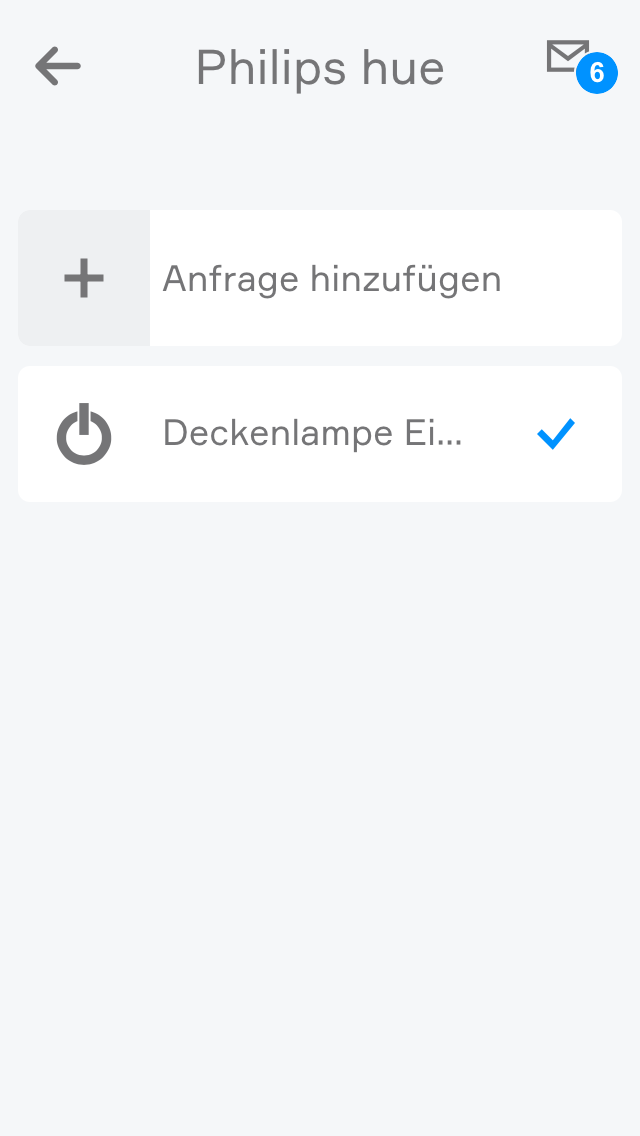
Auch unter "Anfragen bearbeiten" können Sie die Anfragen senden.

Außerdem können die Anfragen auch an anderen Stellen Ihres evon Smart Home verwendet werden, wie zum Beispiel in den Szenen.
Velux
Die Velux-App ermöglicht Ihnen mit evon Smart Home Ihre Velux Fenster- und Beschattungselemente zu steuern. In wenigen Schritten können Sie die definierten Programme des Velux KLF200 Interface in evon Smart Home importieren und verwenden.

Sie finden Velux unter "Einstellungen" - "Velux"
Erstellen
Um Ihre Velux Geräte zu integrieren, müssen Sie diese mit einem Velux KLF200 Interface verknüpft sein.
Das Gerät muss per LAN mit dem selben Netzwerk wie Ihr evon Smart Home System verbunden sein.
Zudem sollte die IP-Adresse des Gerätes auf eine freie statische IP-Adresse gesetzt werden.
Stellen Sie sicher, dass das KLF200 Interface über eine Firmware-Version verfügt welche >= 0.2.0.0.71.0 ist. Sie können die Firmware unter folgender Adresse herunterladen: https://updates2.velux.com/

Um die Netzwerkeinstellungen in Ihrem Velux Interface zu konfigurieren, müssen Sie sich über WLAN mit dem Interface verbinden und mit Ihrem Browser auf 192.168.0.1 verbinden. Das Passwort für den Login befindet sich auf der Rückseite Ihres Gerätes.
Nach erfolgreichem Login finden Sie die Netzwerkeinstellungen in den Einstellungen unter "LAN".
Hier sollte eine noch freie statische IP-Adresse vergeben werden.

Durch Klick auf den Reiter "Programme" können Sie Ihre Szenen verwalten. Diese "Programme" können dann in Ihrem evon Smart Home verknüpft werden.

Nach der Inbetriebnahme können Sie durch Klick auf "Gateway hinzufügen" Ihr Gerät integrieren.
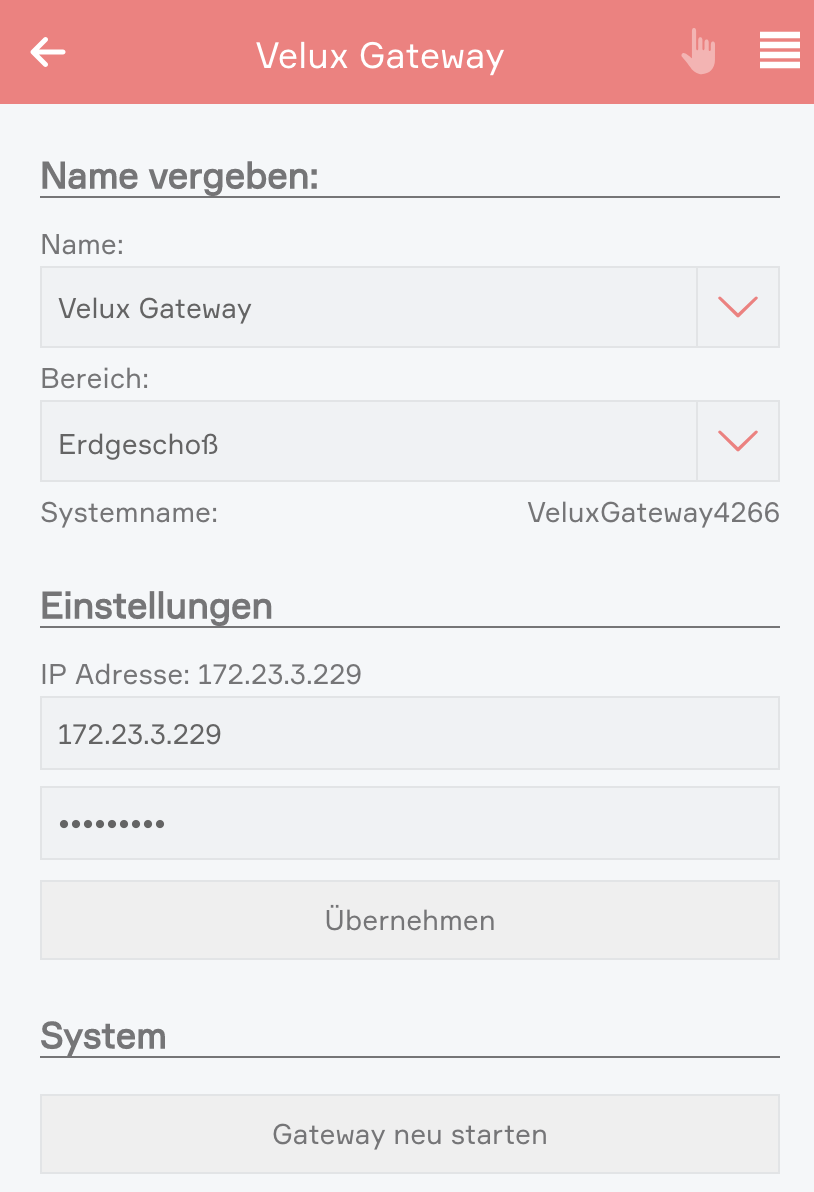
Im nächsten Schritt ist die Eingabe der Geräte IP-Adresse und des Passwortes im Parameter Panel erforderlich.
Das Passwort finden Sie auf der Rückseite Ihres Gerätes , für die Konfiguration in evon Smart Home muss das Passwort (unter SSID) verwendet werden - nicht der Web logon!

Nach erfolgreicher Verbindung zum KLF200 Interface wird dies im Operator Panel angezeigt.
Durch Klick auf "Szenen aktualisieren" werden alle am Gateway eingelernten Programme in das evon Smart Home System importiert und stehen zur Verwendung bereit.
Bedienung

Durch Klick auf den linken Bereich im Object Panel oder mittels Klick auf "Szenen anzeigen" im Operator Panel werden alle Szenen angezeigt.
Jede Szene kann durch Klick auf den Play-Button im linken Bereich des Object Panel oder im Operator Panel mittels Klick auf "Szene ausführen" ausgeführt werden.
Zusätzlich kann jede Szene in einer evon Smart Home Szene unter "dann" verknüpft werden.

Nachdem eine Szene gestartet wurde, können Sie diese durch Klick auf den Pause-Button wieder stoppen.
Achtung: Es kann immer nur eine Szene gleichzeitig ausgeführt werden. Falls mehrere Szenen gestartet werden, werden diese hintereinander ausgeführt.

Im Parameter Panel jeder Szene kann die Ausführungsgeschwindigkeit der Szene eingestellt werden.
Dabei ist zu beachten, dass nicht alle Geräte jede Geschwindigkeit unterstützen.
Anwesenheitssimulation
Die Anwesenheitssimulation soll trotz Abwesenheit (z.B.: Urlaub) das Eigenheim bewohnt aussehen lassen und somit als Schutz vor Einbruch dienen. Um die Anwesenheit bestmöglich zu simulieren wird das gewohnte Verhalten aufgezeichnet und lokal auf Ihrem Controller gespeichert. Diese Daten werden dann verwendet, um eine intelligente Simulation der Anwesenheit zu ermöglichen.

Sie finden die Anwesenheitssimulation unter "Alle Apps" - "Anwesenheitssimulation"
Konfiguration
Die Anwesenheitssimulation existiert bereits und muss daher nicht mehr erstellt werden. Die Konfiguration können Sie mit wenigen Klicks ganz einfach vornehmen.

Durch Klick auf das ObjectPanel öffnet sich ein Wizard. Mithilfe des Wizards, können Sie die Anwesenheitssimulation ganz einfach konfigurieren.

Im ersten Konfigurationsschritt können die Lichter ausgewählt werden, welche in die Simulation aufgenommen werden sollen. Wenn Sie bestimmte Lichter (z.B.: Kellerräume, etc.) von der Anwesenheitssimulation ausnehmen wollen, können Sie dies indem Sie die Checkbox „Alle auswählen“ abhaken und die einzelnen Lichter in der Liste manuell auswählen.

In diesem Schritt können die Beschattungselemente für die Anwesenheitssimulation konfiguriert werden. Wenn Sie bereits eine automatische Beschattungsregelung konfiguriert haben, müssen Sie entscheiden ob während der Simulation die automatische Beschattungsregelung oder die Anwesenheitssimulation zur Steuerung der Elemente verwendet werden soll. Der Unterschied besteht darin, dass die Anwesenheitssimulation nicht auf die aktuelle Sonneneinstrahlung reagiert, sondern vergangene automatische und manuelle Bedienungen der Elemente wiedergibt.
Wie auch bei den Lichtelementen können Sie entscheiden, ob Sie alle Elemente oder nur bestimmte für die Anwesenheitssimulation verwenden möchten.

Optional können Sie auch beliebige digitale Ausgänge (z.B.: TV-Steckdose) in die Simulation aufnehmen. Klicken Sie hierzu einfach auf hinzufügen und wählen Sie die gewünschten Elemente aus.
Achten Sie darauf, dass Sie keine sicherheitsrelevanten Elemente wie Türöffner o.Ä. in die Auswahl aufzunehmen!

Der aktivierte Zufallsmodus schaltet zusätzlich zu den aufgezeichneten Ereignissen die Lichter auch in einer zufälligen Folge (z.B.: Licht Gang um 23:00 für 5min ein). Die Lichter werden im Zufallsmodus maximal 10 Minuten aktiviert.
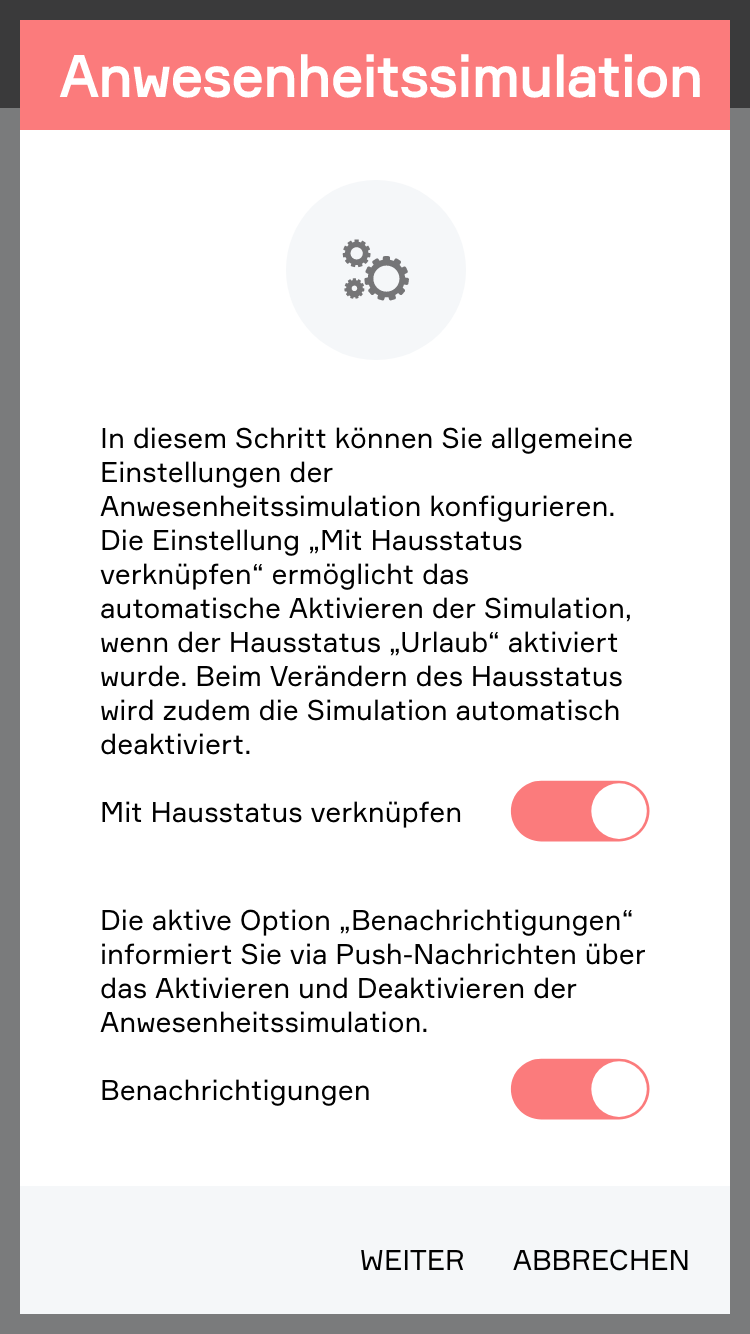
In diesem Schritt können Sie allgemeine Einstellungen der Anwesenheitssimulation konfigurieren. Die Einstellung „Mit Hausstatus verknüpfen“ ermöglicht das automatische Aktivieren der Simulation, wenn der Hausstatus „Urlaub“ aktiviert wurde. Beim Verändern des Hausstatus wird zudem die Simulation automatisch deaktiviert.

Die Simulation funktioniert nach dem Aktivieren den gesamten Tag, Sie können jedoch auch einen Zeitbereich wählen in welchem die Simulation aktiv sein soll.

Die Konfiguration ist erfolgreich abgeschlossen! Die Aufzeichnung wird im Anschluss automatisch gestartet. Für eine vollständige Simulation muss die Aufzeichnung ca. 1 Woche ausgeführt werden. Möchten Sie die Simulation jedoch bereits früher nutzen können Sie mit eingeschränkten Funktionen bereits nach 1-2 Tagen starten.
Die aufgezeichneten Daten werden automatisch aktualisiert, Sie müssen die Konfiguration somit nicht erneut ausführen.
Bedienung
Wenn Sie die Anwesenheitssimulation mit dem Hausstatus "Urlaub" verknüpft haben, wird diese automatisch aktiviert, sobald Sie diesen Hausstatus aktivieren.
Alternativ haben Sie die Möglichkeit, mithilfe der Szenen "Simulation aktivieren" und "Simulation deaktivieren" zu steuern.
Sie können die Simulation natürlich im OperatorPanel der Anwesenheitssimulation selbst auch aktivieren.
Achten Sie darauf, dass die Aktivierung mittels Hausstatus oder Szene erst dann funktioniert, wenn ausreichend Daten aufgezeichnet wurden.

Sobald Sie die Anwesenheitssimulation konfiguriert haben, beginnt diese Ihr Verhalten aufzuzeichnen.
Der aktuelle Status der Anwesenheitssimulation wird im ObjectPanel dargestellt.

Im OperatorPanel wird der aktuelle Status, sowie der Aufzeichnungsfortschritt dargestellt.
Sobald ausreichend Daten aufgezeichnet wurden, kann die Anwesenheitssimulation durch Klick auf den Button "Simulation Starten" gestartet werden.
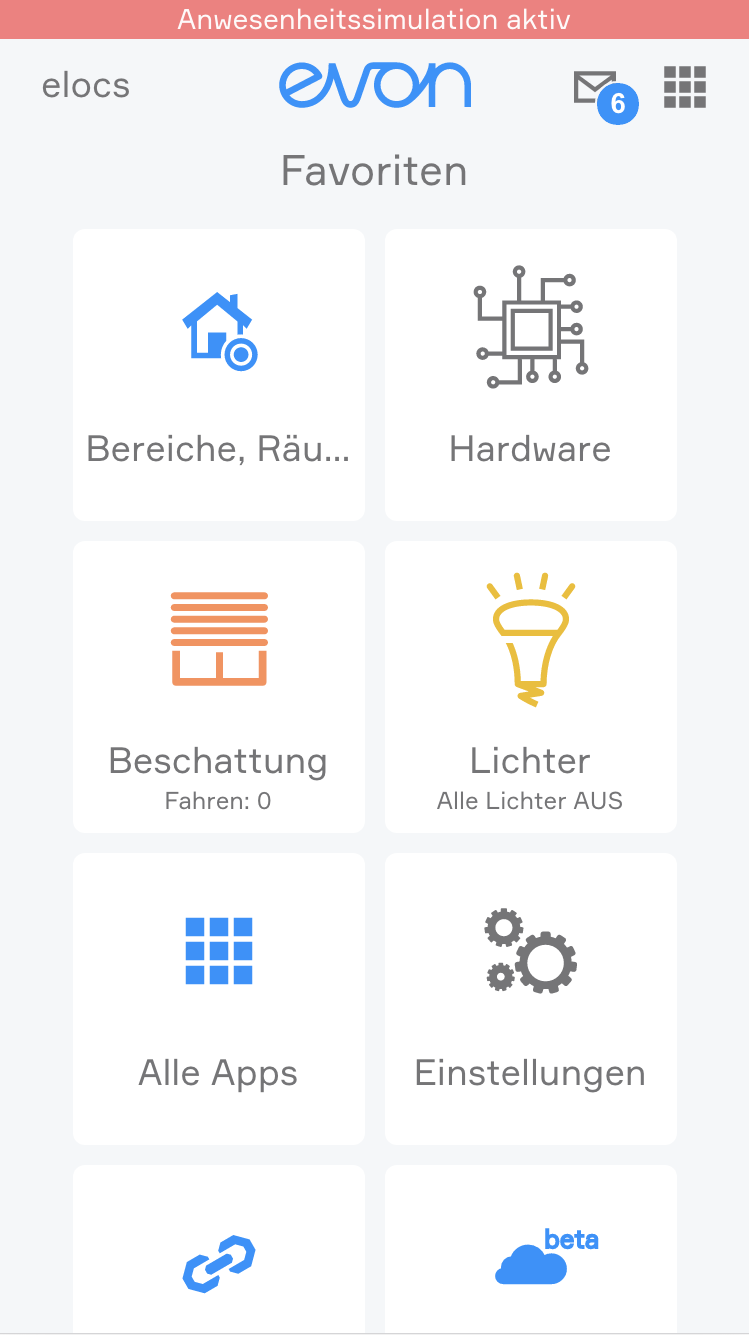
Wenn die Anwesenheitssimulation aktiv ist, wird Ihnen dies am oberen Bildschirmrand der Startseite angezeigt. Somit haben Sie den Status der Anwesenheitssimulation immer im Blick.

Im ParameterPanel können alle Einstellungen, welche im Wizard konfiguriert werden geändert werden.
Zusätzlich können die Elemente, welche für die Simulation verwendet werden bearbeitet werden.
Achtung: Wenn neue Elemente ausgewählt werden, kann es einige Tage dauern, bis diese in der Simulation mit berücksichtigt werden
Durch Klick auf "Anwesenheitssimulation zurücksetzen" werden alle Einstellungen zurückgesetzt und gespeicherte Daten gelöscht. Sie können die Anwesenheitssimulation danach jederzeit neu konfigurieren.
KWB
Mit der App „KWB Comfort Smart“ können Sie Ihre KWB Comfort C3 Heizungssteuerung integrieren.

Sie finden die KWB Anwendung unter „Alle Apps“ – „Comfort Smart“.
Erstellen

Um Ihre KWB Heizungssteuerung mit evon Smart Home verbinden zu können, muss diese mit Ihrem Heimnetzwerk verbunden sein und über eine gültige Netzwerkkonfiguration verfügen. Nachdem Sie eine neue Anlage hinzugefügt haben, müssen Sie die IP-Adresse der Heizungssteuerung unter den Verbindungseinstellungen eintragen. Eine erfolgreiche Kommunikation mit der Steuerung wird über den Verbindungsstatus angezeigt.
Bedienen

Die Comfort-Smart App dient hauptsächlich zur Anzeige des aktuellen Status und zur Konfiguration der Buffertemperaturen. Über das Operator-Panel kann jedoch auch die Anlage gesamt Ein- oder Ausgeschaltet werden.
Szenen
Das Comfort Smart App bietet folgende Funktionen für evon Smart Home Szenen (Dann...):
Einschalten: Die gesamte Anlage wird ausgeschaltet
Ausschalten: Die gesamte Anlage wird eingeschaltet
Samsung
Die Samsung App ermöglicht Ihnen die Einbindung von Samsung Klimageräten in Ihr evon Smart Home System.

Sie finden die Samung App unter "Alle Apps" - "Samsung".
Konfiguration
Stellen Sie bei der Inbetriebnahme sicher, dass das Klimagerät über das Gateway über Modbus RTU mit dem evon Smart Home System verbunden ist und eine gewünschte Geräteadresse am Gerät eingestellt ist.

Um das Gateway und die Klimageräte mit dem evon Smart Home System zu verbinden navigierten Sie in die App und Klicken auf "Gateway hinzufügen".

Nach dem Klick auf "Gateway hinzufügen" öffnet sich ein Konfigurationsassistent, mit welchem in wenigen Klicks die Konfiguration ermöglicht wird.

Als ersten Schritt ist es erforderlich, jene Modbus RTU Schnittstelle auszuwählen, an welcher Sie das Gateway angeschlossen haben.
Falls die gewünschte Schnittstelle nicht erscheint, stellen Sie sicher, dass keine anderen Modbus RTU Geräte mit unterschiedlichen Verbindungseinstellungen mit dieser Schnittstelle konfiguriert sind.

Nach Auswahl der Schnittstelle ist die Auswahl der Geräte Adresse erforderlich. Wählen Sie jene Geräte Adresse aus, welche Sie auch beim Klimagerät eingestellt haben.
Sollte die gewünschte Adresse nicht auswählbar sein, ist auf dieser Schnittstelle bereits ein Gerät mit dieser Adresse konfiguriert. Wählen Sie eine freie Adresse aus und stellen Sie die gleiche Adresse beim Gerät ein.
Achtung: Beim Umstellen der Geräte Adresse am Gerät ist häufig ein Spannungslos-machen des Gerätes erforderlich, damit diese übernommen wird.

Nach der Auswahl der Geräte Adresse werden die Modbus RTU Einstellungen für die Verbindung nochmal zusammengefasst. Vergewissern Sie sich, dass diese Einstellungen für Ihr Gerät passen.

Im nächsten Schritt wird die Verbindung zum Gateway überprüft. Sollte die Verbindung nach mehrmaligen Versuchen nicht möglich sein, überprüfen Sie bitte die Verkabelung sowie die eingestellte Schnittstelle und Geräte Adresse.
Nach erfolgreicher Verbindung zum Gateway werden im nächsten Schritt die Innenstationen gesucht. Falls nicht alle vorhandenen Innenstationen gefunden werden, überprüfen Sie bitte, dass diese eingeschaltet und mit dem Gateway verbunden sind und starten Sie mit Klick auf "Erneut suchen" die Suche erneut. Neue Innenstationen können auch nachträglich jederzeit gesucht werden.

Durch das Abschließen des Konfigurationsassistenten wird das Gateway und die dazugehörigen Innenstationen automatisch angelegt und ist einsatzbereit. Nach wenigen Sekunden sollten die Daten der Geräte angezeigt werden.
Bedienung

Wurden die Samsung Klimageräte erfolgreich in Ihr evon Smart Home eingebunden, stehen Ihnen mehrere Bedienelemente zur Verfügung.
Sie können die Temperatur einstellen, das Gerät ein-/ausschalten und den Betriebsmodus umschalten.
Außerdem lässt sich der Lüftungsmodus von "Automatisch" auf "Manuell" ändern. Im manuellen Modus können Sie die Lüfterstufe einstellen.
Für die Luftstromrichtung können Sie das vertikale Schwingen des Innengerätes aktivieren.
Viele Innenstationen bieten die "Windfrei" Funktion an. Bei Aktivierung dieser Funktion schließt sich die Klappe der Innenstation und die gekühlte Luft strömt durch die Löcher der Klappe. Diese Funktion ist am Klimagerät nicht immer möglich.
Alle Einstellungen lassen sich auch über Szenen steuern. So können Sie z.B.: die Lüftungsstufe oder Temperatur ändern, sobald Ihre festgelegten "Wenn"-Bedingungen erfüllt sind.
Szenen
Die Samsung App bietet folgende Funktionen für evon Smart Home Szenen (Dann…):
- Einschalten: Das Klimagerät wird eingeschaltet.
- Ausschalten: Das Klimagerät wird ausgeschaltet.
- Einschalten mit Optionen: Das Klimagerät wird eingeschaltet und Optionen werden gesetzt.
- Leise-Betrieb aktivieren: Das Klimagerät schaltet die Lüfterstufe auf Leise".
- Lüfterstufe setzen: Das Klimagerät schaltet die gewünschte Lüfterstufe.
- Luftstromrichtung setzen: Das Klimagerät schaltet die gewünschte Luftstromrichtung.
- Modus für alle setzen: Alle Klimageräte schalten auf den gewünschten Betriebsmodus.
- Solltemperatur: Das Klimagerät übernimmt die Solltemperatur.
- Vertikale Luftverteilung aktivieren: Das Klimagerät aktiviert die vertikale Luftverteilung.
Smart Meter
Mit der App "Smart Meter" können Sie Ihren Energiebedarf überwachen.

Sie finden die Smart Meter App unter "Alle Apps" - "Smart Meter"
Konfiguration
Stellen Sie bei der Inbetriebnahme sicher, dass der evon Smart Meter über Modbus RTU mit dem evon Smart Home System verbunden ist und eine gewünschte Geräteadresse am Gerät eingestellt ist.

Um den Smart Meter mit dem evon Smart Home System zu verbinden navigierten Sie in die App und Klicken auf "Smart Meter hinzufügen".
Nach dem Klick auf "Smart Meter hinzufügen" öffnet sich ein Konfigurationssssistent, mit welchem in wenigen Klicks die Konfiguration ermöglicht wird.

Als ersten Schritt ist es erforderlich, jene Modbus RTU Schnittstelle auszuwählen, an welcher Sie den Smart Meter angeschlossen haben.
Falls die gewünschte Schnittstelle nicht erscheint, stellen Sie sicher, dass keine anderen Modbus RTU Geräte mit unterschiedlichen Verbindungseinstellungen mit dieser Schnittstelle konfiguriert sind.
Nach der Auswahl der Schnittstelle werden alle angeschlossenen Smart Meter automatisch gesucht. Klicken Sie auf den Smart Meter um diesen mit dem evon Smart Home System zu verbinden.
Sollte der angeschlossene Smart Meter nicht gefunden werden, können Sie durch Klick auf "Erneut suchen" die Suche erneut starten.
Falls der evon Smart Meter nicht gefunden werden sollte, überprüfen Sie bitte, dass dieser eingeschaltet und mit der ausgewählten Schnittstelle verbunden ist. Vergewissern Sie sich, dass die Modbus RTU Anschlüsse A und B nicht vertauscht sind.
Durch das Abschließen des Konfigurationsassistenten wird der evon Smart Meter automatisch angelegt und ist einsatzbereit. Nach wenigen Sekunden sollten die Daten des Smart Meters angezeigt werden.
Bedienung
Im Object Panel wird die Aktuelle Leistung angezeigt. Weiters ist sofort erkennbar, ob gerade Strom vom Netz bezogen wird oder in dieses eingespeist wird.

Im Operator Panel wird der aktuelle Bezug oder die aktuelle Einspeisung visuell dargestellt.
Unter "Energiebilanz" werden der gesamte Netzbezug sowie der Netzbezug der letzten 24 Stunden dargestellt. Wurde mit dem Smart Meter auch in das Netz eingespeist, so wird auch die gesamte Einspeisung sowie die Einspeisung der letzten 24 Stunden dargestellt.
Zusätzlich kann mithilfe eines Histogramms der Bezug, bzw. die Einspeisung, über verschiedene Zeiträume betrachtet werden.
Ein Vergleichswert zeigt an, ob der durchschnittliche Bezug oder die durchschnittliche Einspeisung im vergleich zur letzten Periode mehr oder weniger wurde.
Im Parameter Panel wird der Verbindungsstatus zum evon Smart Meter dargestellt.
Zusätzlich können alle Messdaten des Smart Meters betrachtet werden.
Siemens Sentron
Mit der App “Siemens Sentron” können Sie Siemens Leistungsmessgeräte der Type PAC XXXX (Modbus TCP) in evon Smart Home einbinden.
Aufgrund der kleineren Bauform und einfacheren Integration werden zur Leistungsmessung die Geräte HC-SM300-00 und HC-SM100-00 empfohlen. Aus diesem Grund wird die Siemens Sentron Integration in evon Smart Home nicht weitergeführt. Bestehende Integrationen funktionieren weiter, neue Messgeräte können aber nicht mehr hinzugefügt werden.
